Home > Product Installs & Reviews > Product Reviews > Car Speaker Reviews > JBL Stadium Marine Speakers Unbox & Review
In this article: I'll unbox and review JBL's Stadium Marine Gray 6 1/2 inch and 8 inch speakers along with their 10 inch subwoofer. I'll walk through some of their unique performance and marine-specific features and also hook them up to power and demo their LED lights.
The Stadium Marine series is JBL's latest lineup of marine-grade speakers for your boat. It's their flagship marine series, so it's comprised of the best marine products that JBL offers. Followed by the Club Marine and the entry level Stage marine series. Originally introduced in 2019 with a white and black version, the Stadium Marine speakers incorporates many of the quality and performance technology of their automotive lineup onto a marine-ready platform.
Marine speakers seldom are released individually, and the Stadium Marine series is a good example of the growing group of manufacturers offering a packaged suite of products so that you can build your entire boat's stereo with the same set of speakers. And what's good about a series of products like this, is that they're normally engineered to work well together – whether that's from a frequency coverage perspective, power handling or even looks (e.g. LED lighting). In most cases, you can build the stereo that meets your needs with a combination of the speakers within a single lineup. The Stadium Marine lineup is comprised of three products right now:
- 6 1/2 inch coaxial speaker
- 8 inch 3-way convertible speaker
- 10 inch switchable 2/4 ohm subwoofer
We were lucky to get our hands on the whole line of speakers (thanks JBL!) and in this review, I'll open up all three and give you an inside look at the various shared and unique features to each speaker. I'll point out what I like about them and in general give you a good walkthrough of the lineup so that you have the information you need to decide whether or not they're a good choice for your boat or application.
Unbox & First Impressions
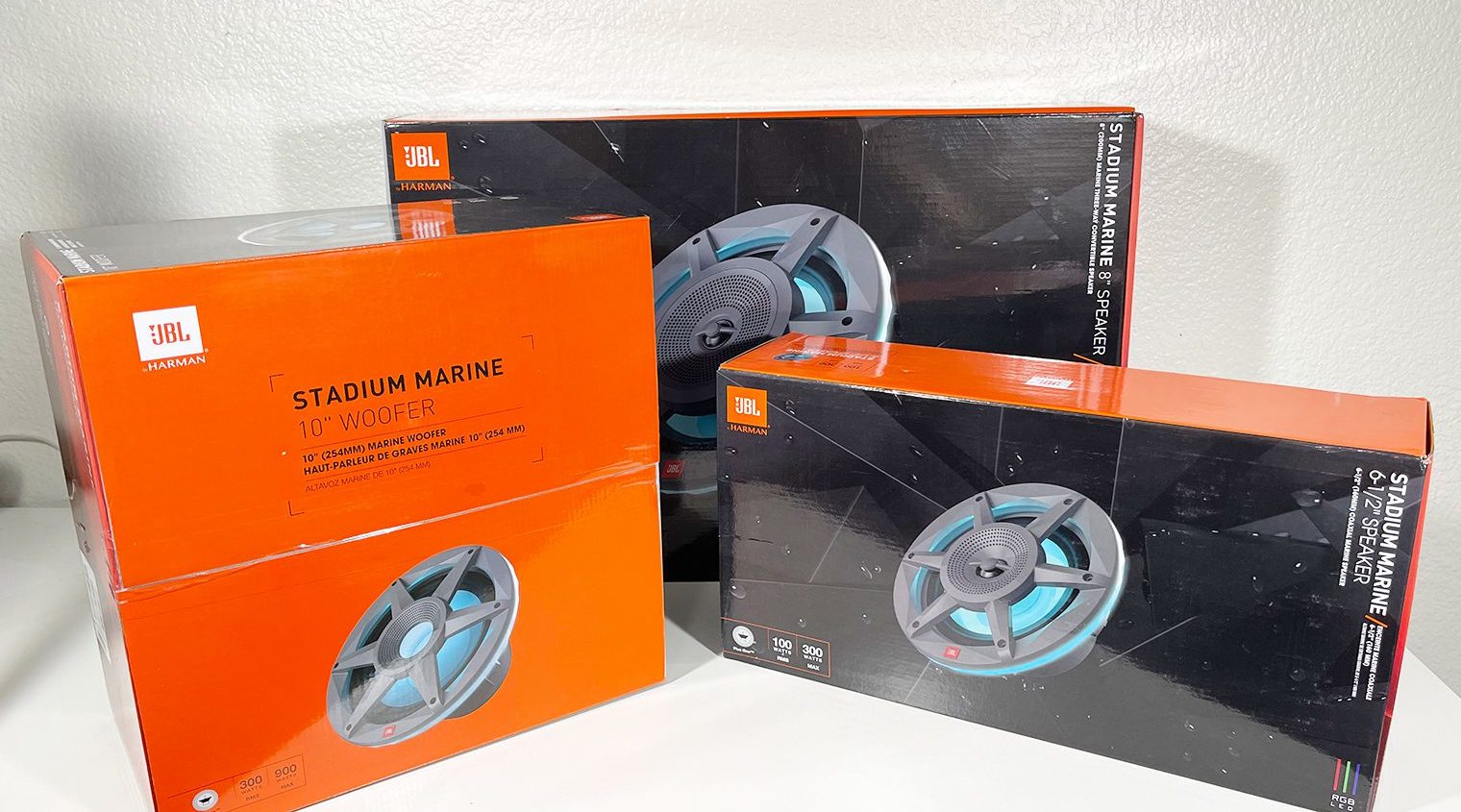
So let’s talk through what you see in the picture above. I mentioned this earlier, JBL’s Stadium Marine lineup is comprised of three speakers right now – a 6 ½ inch on the right which is a 100 Watt RMS, 3 ohm speaker, an 8 inch convertible speaker in the back with a removable 3 inch midrange and 1 inch tweeter, and then a 10 inch subwoofer with a switchable 2 or 4 ohm impedance. Here's a few photos of what you'll find in the box of each:
JBL Stadium Marine 62
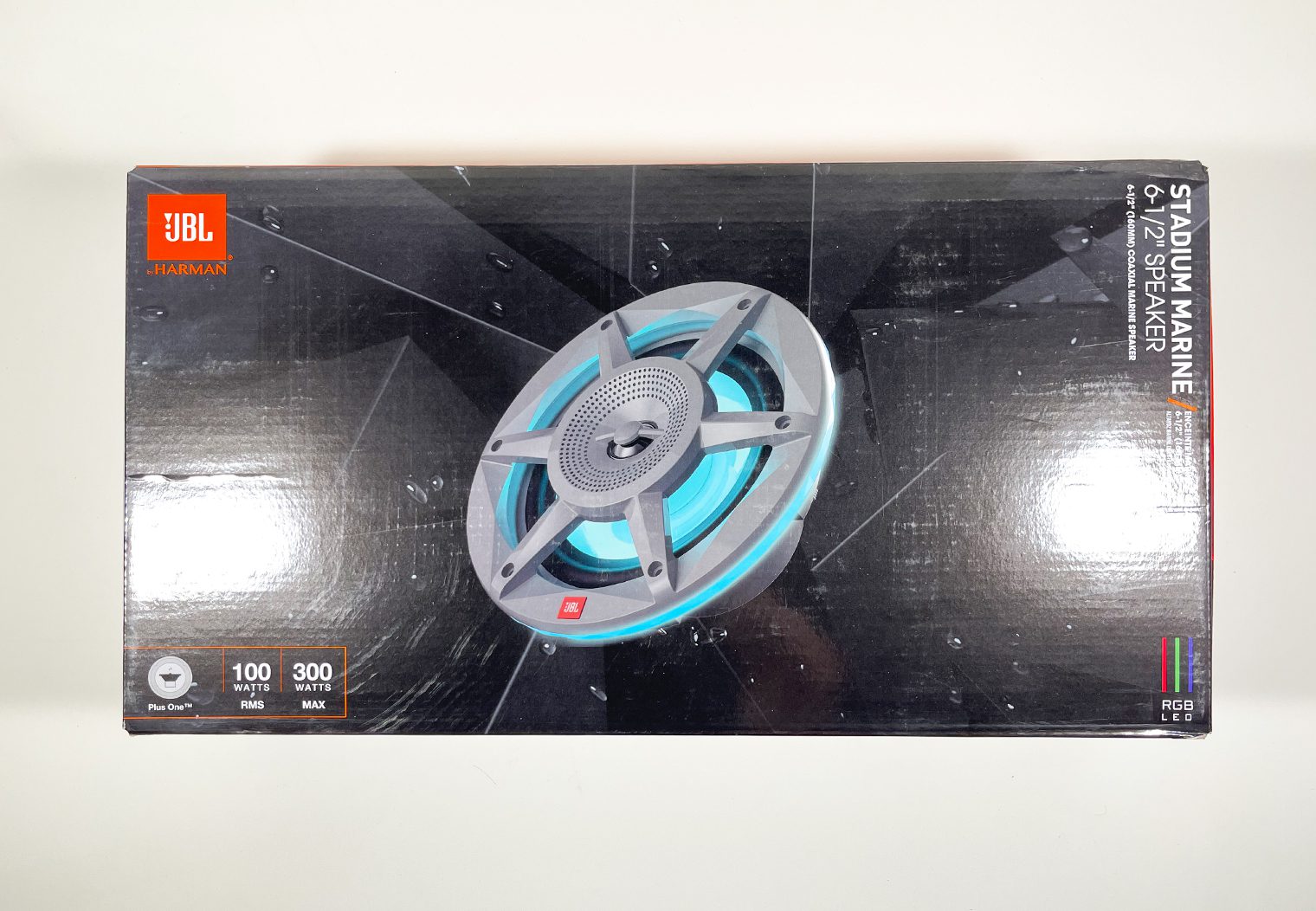
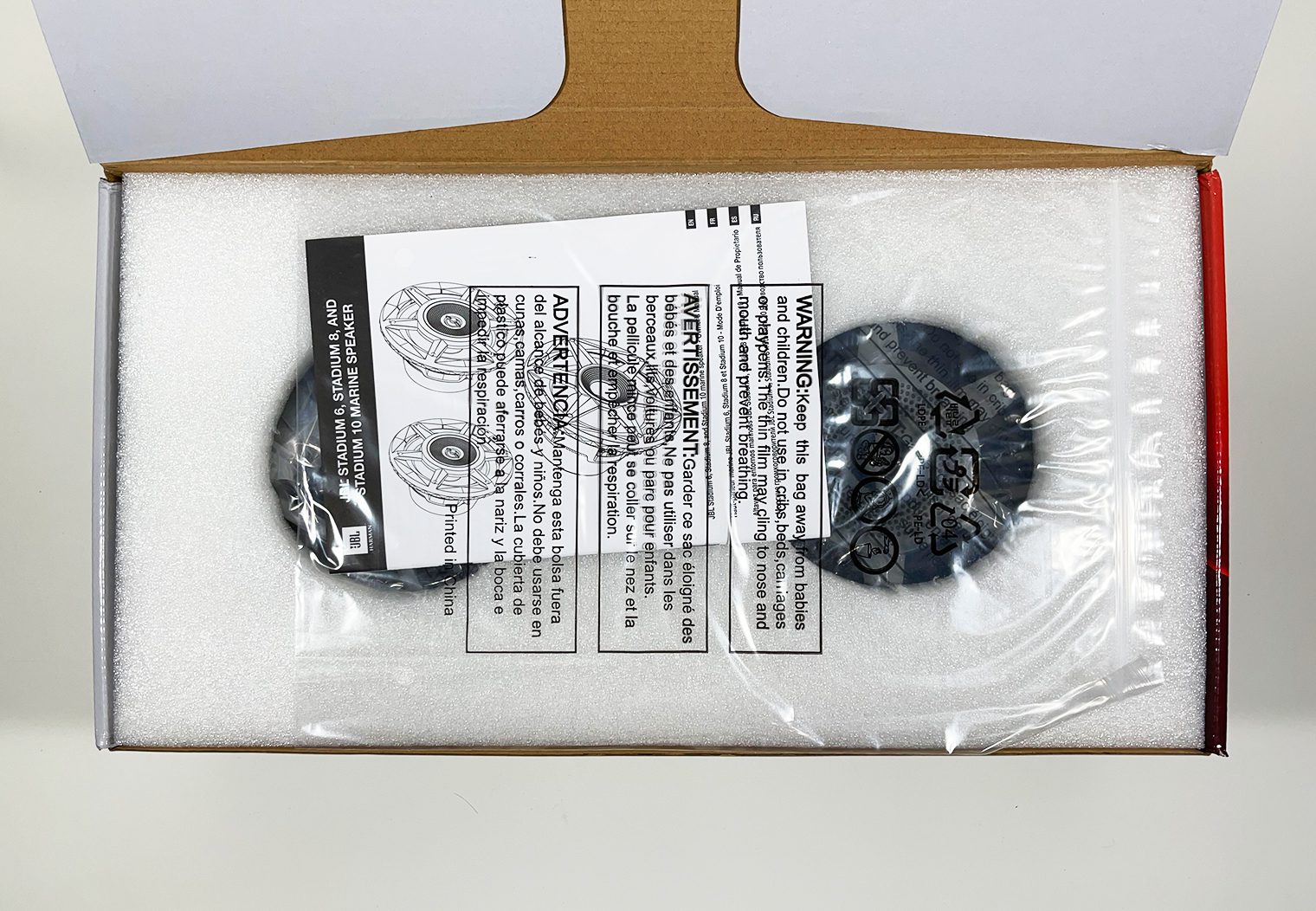
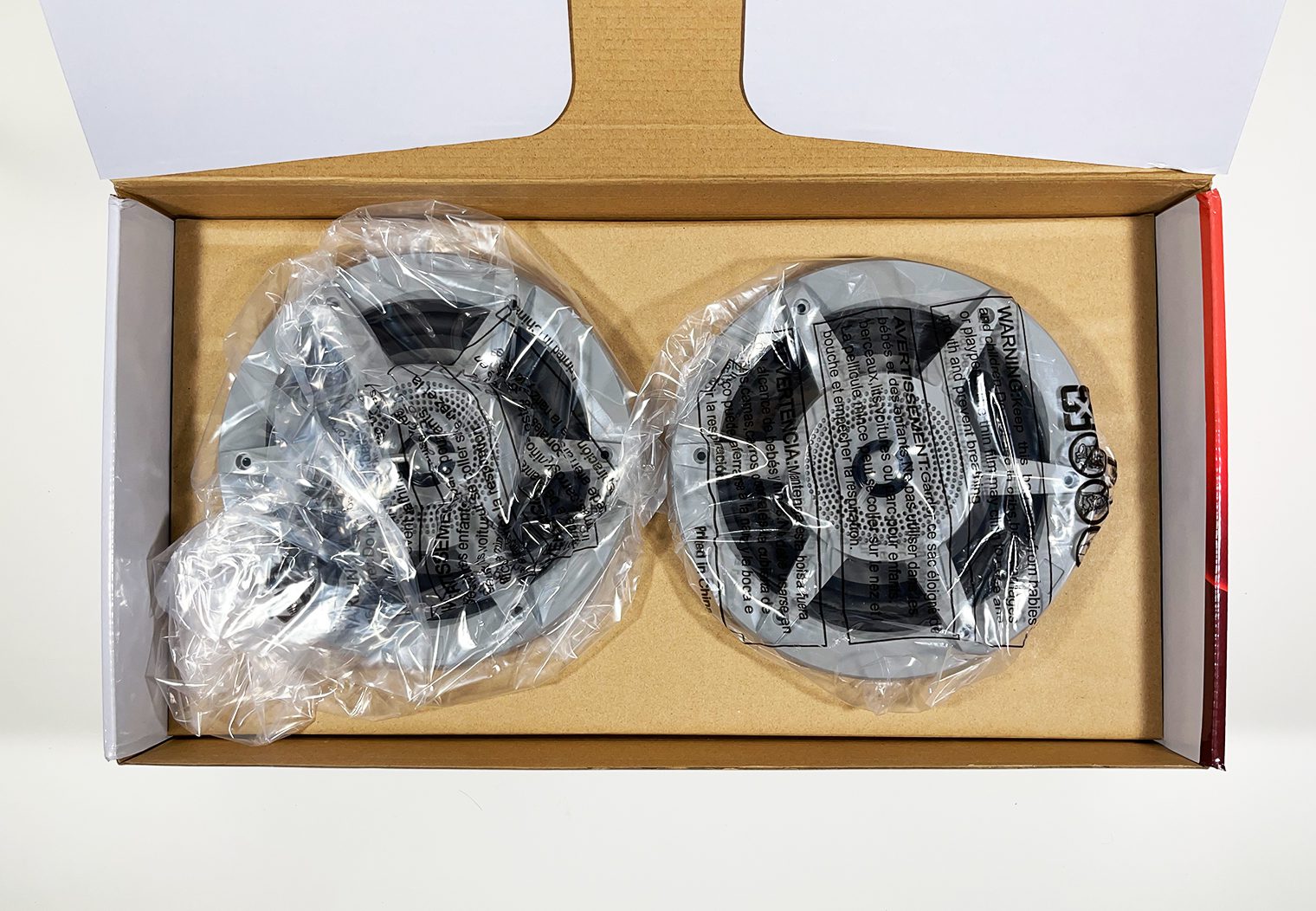
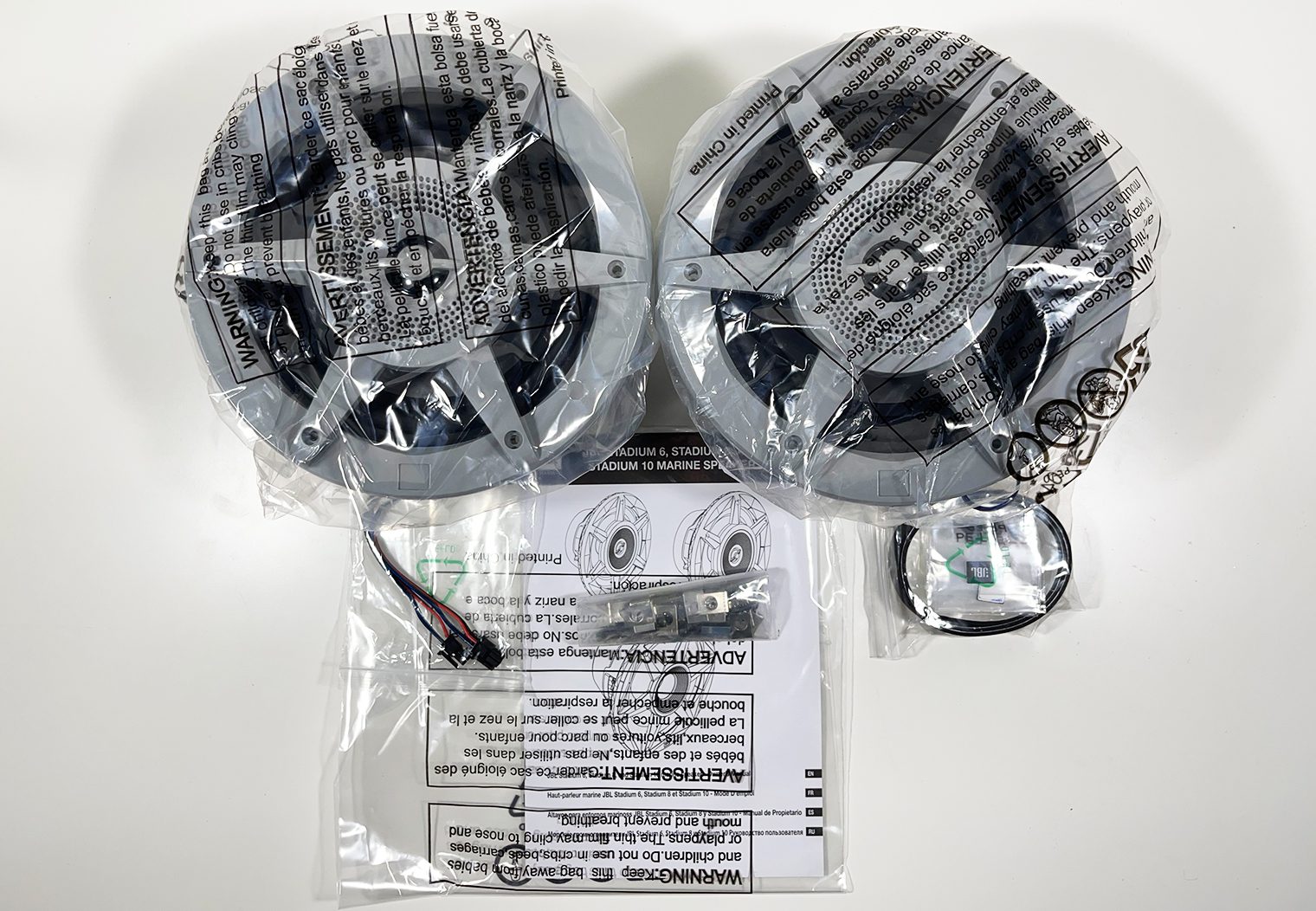
JBL Stadium Marine 82M
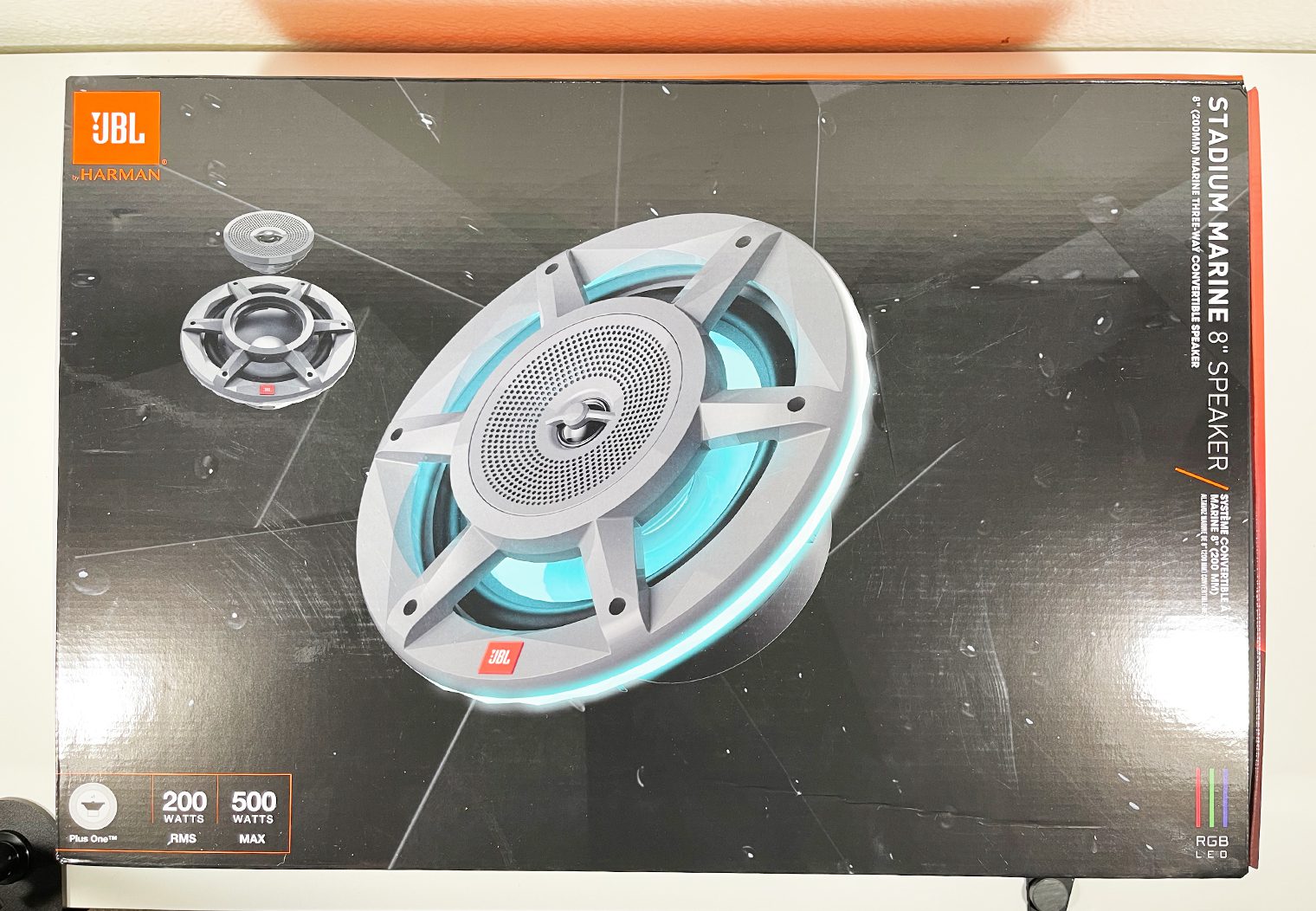
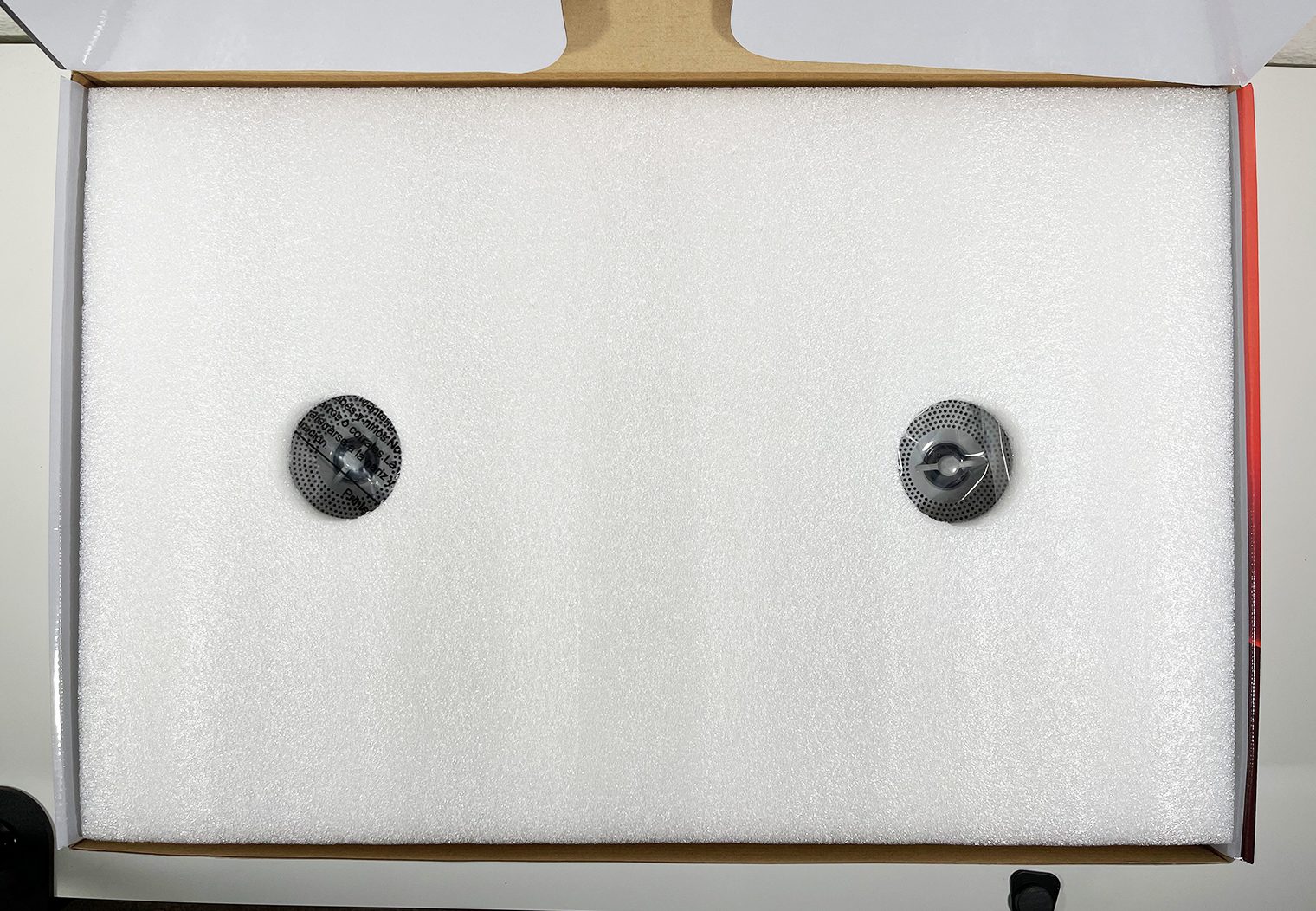
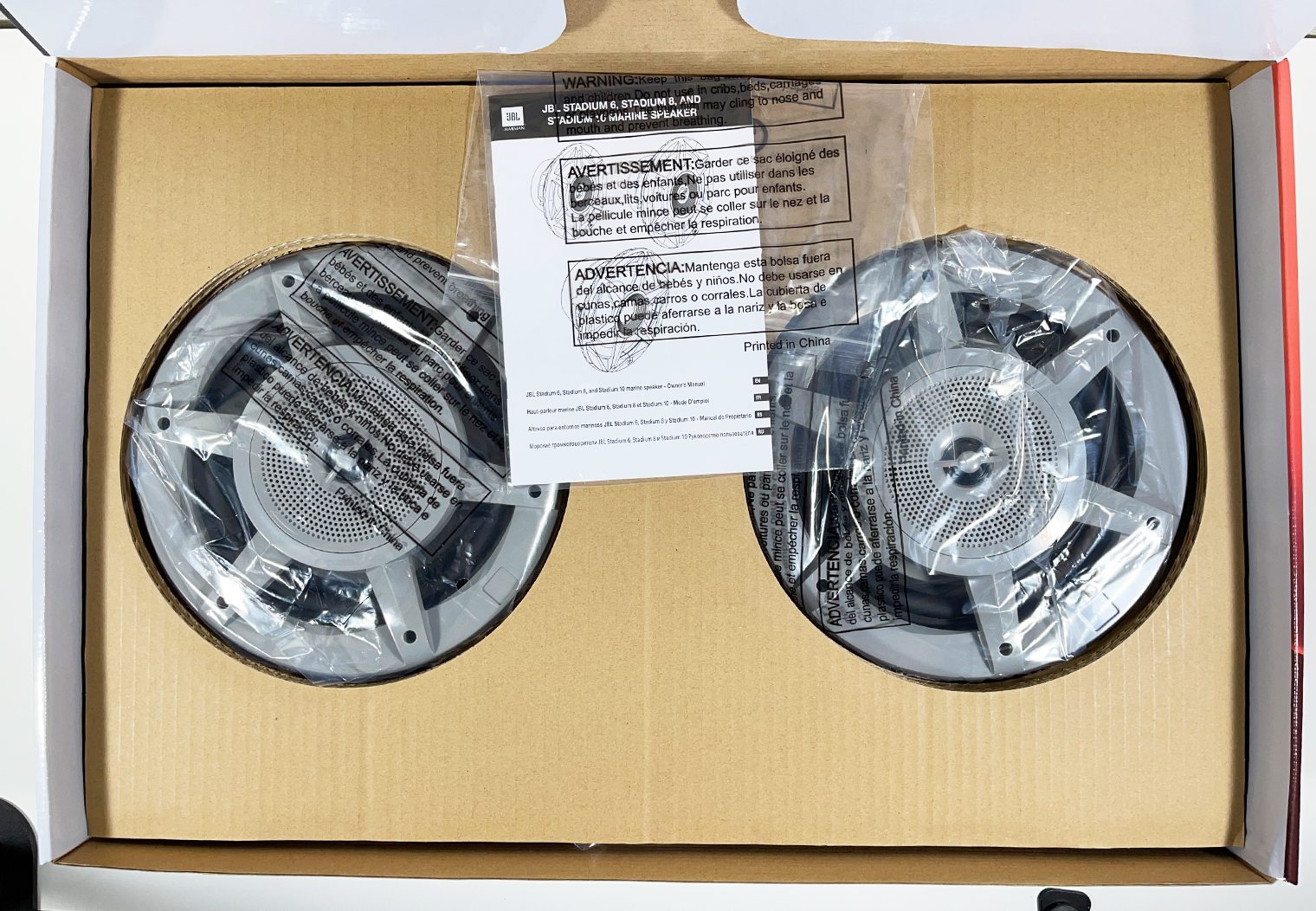
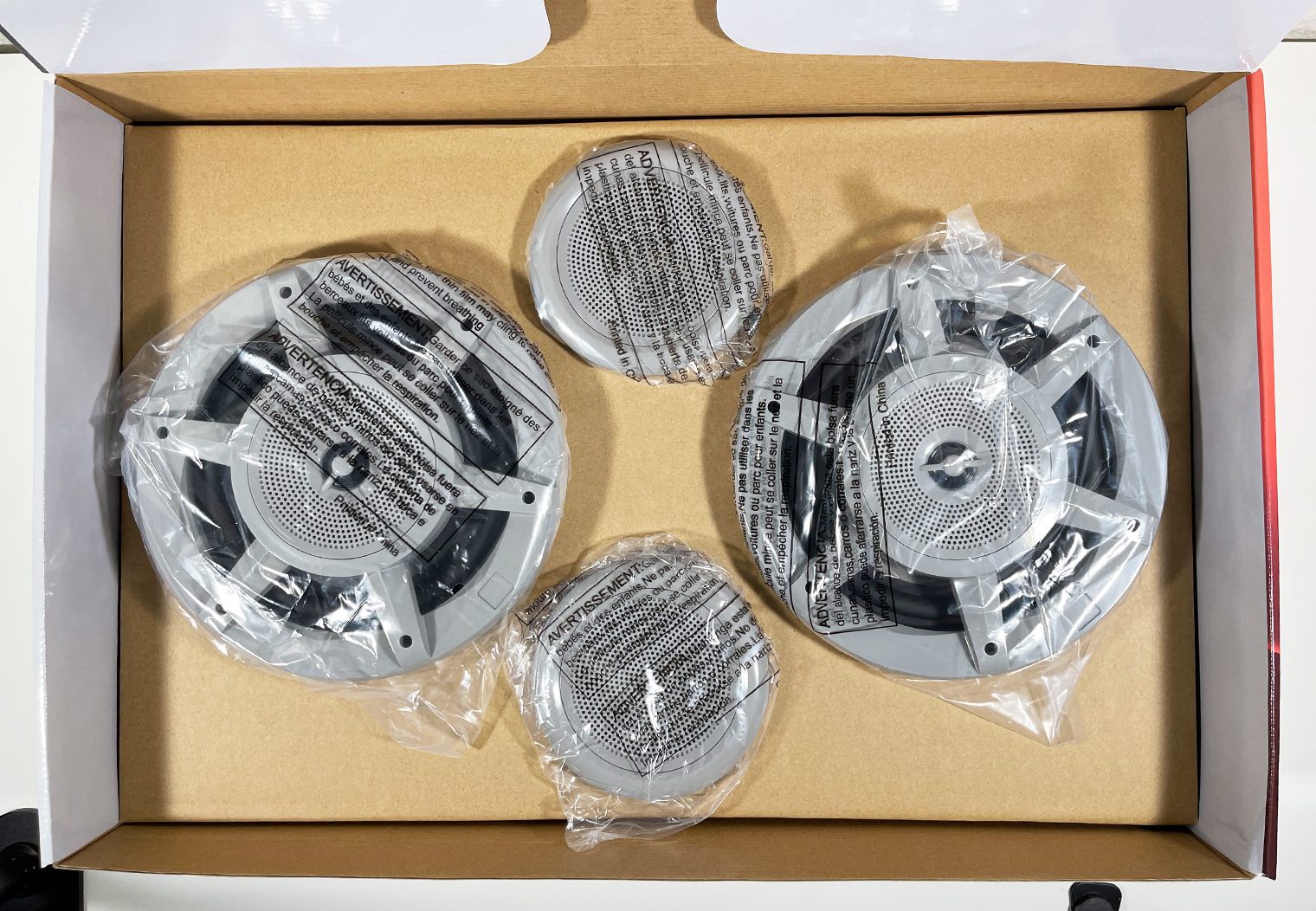
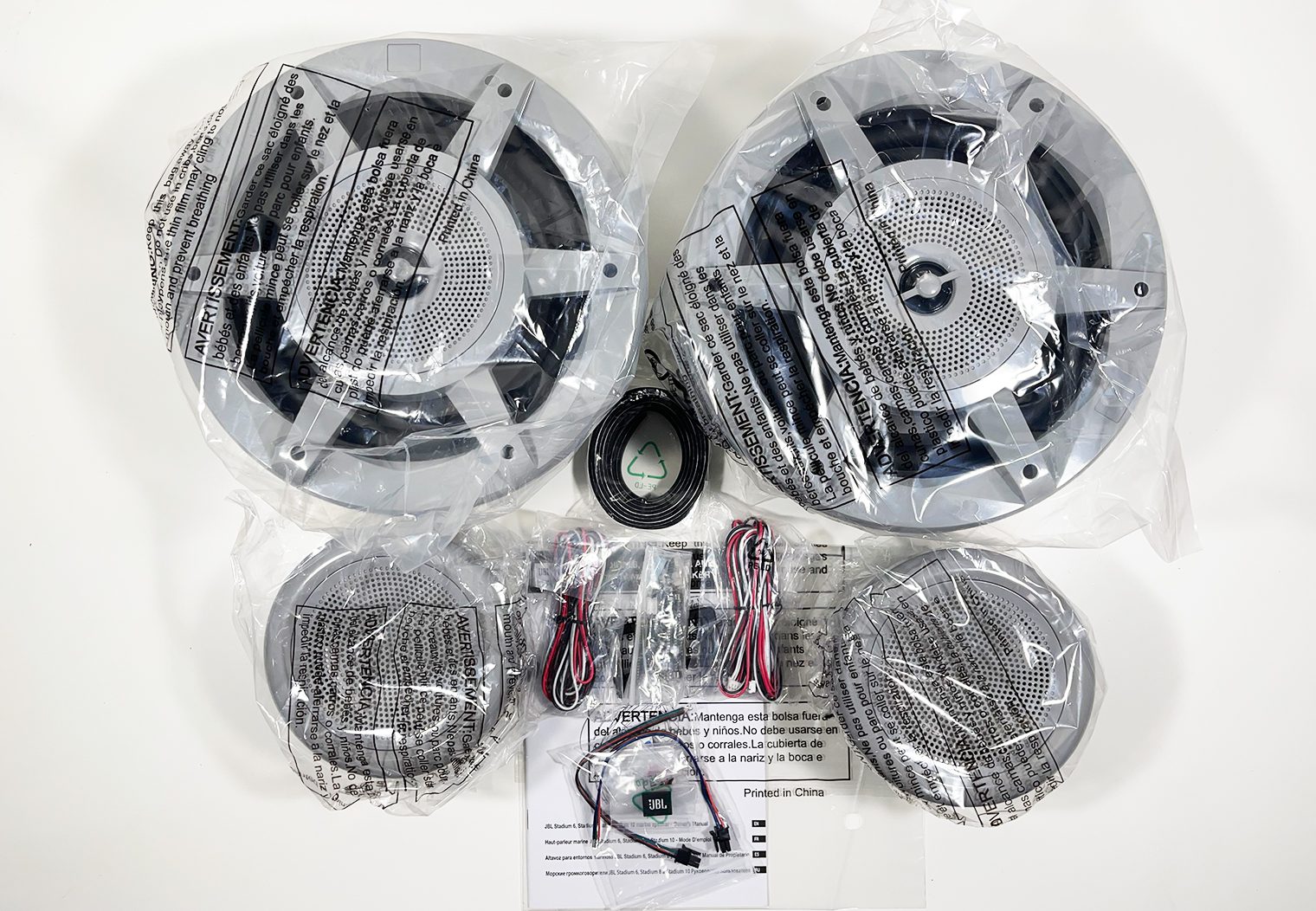
JBL Stadium Marine 102
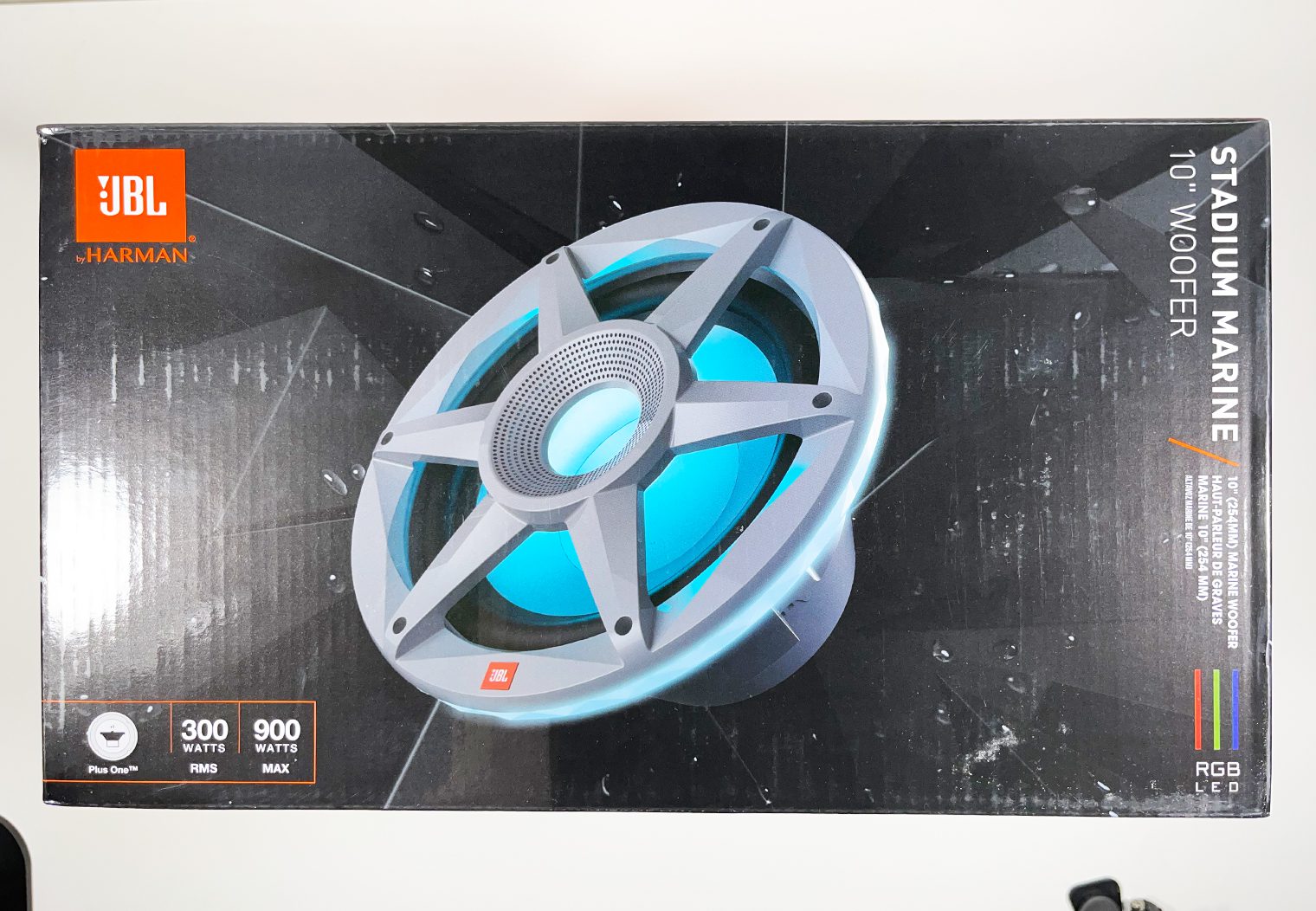
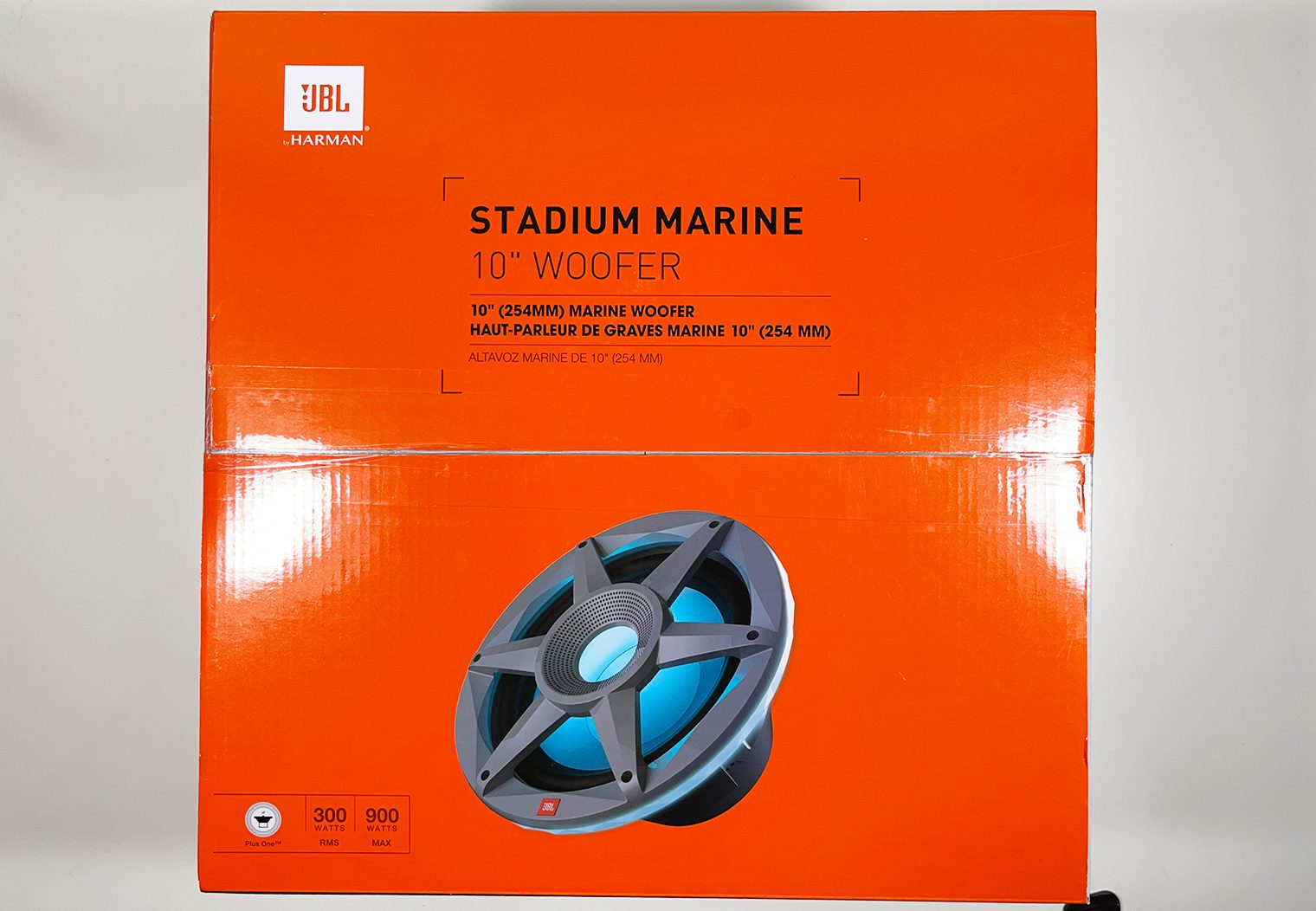
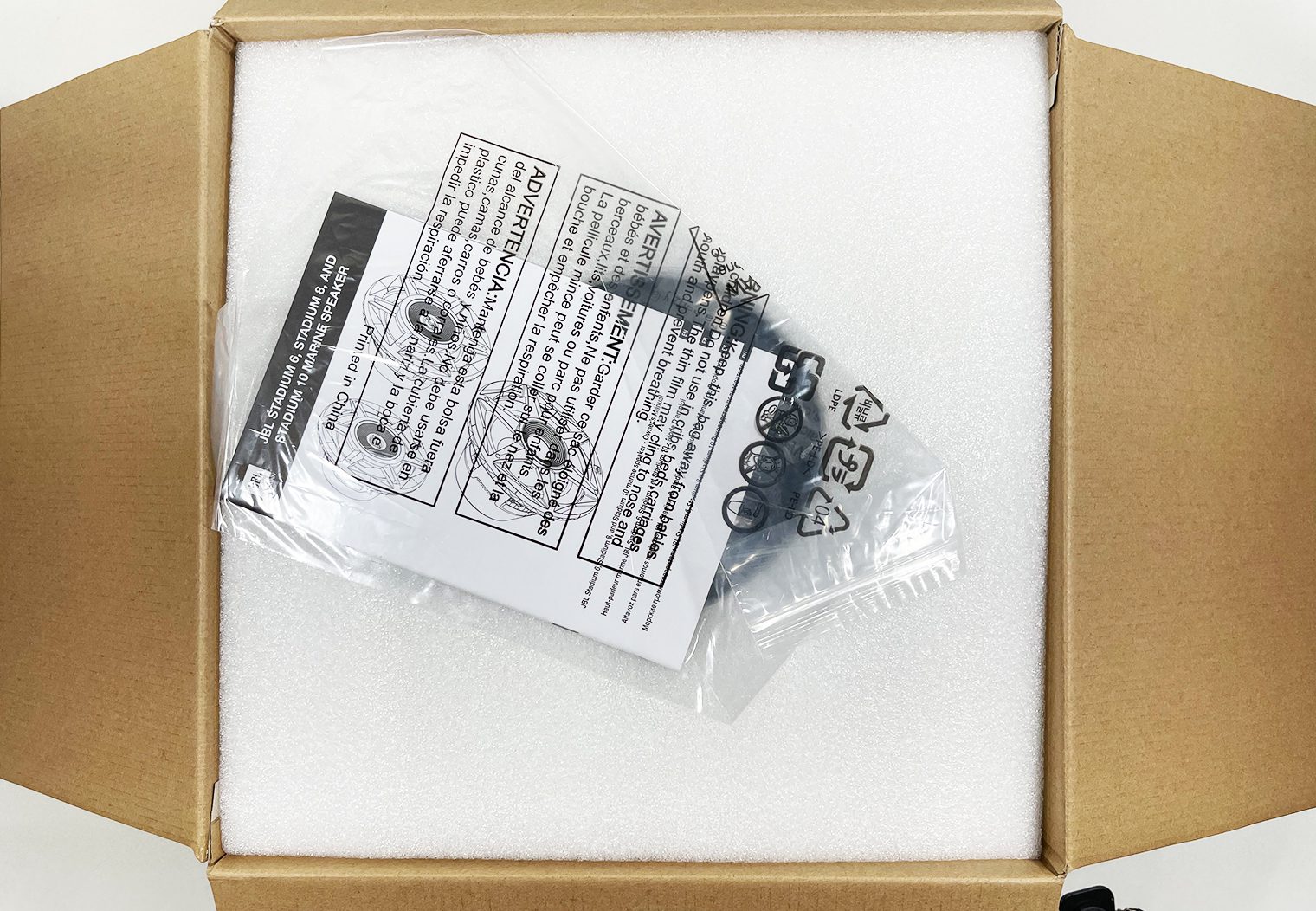
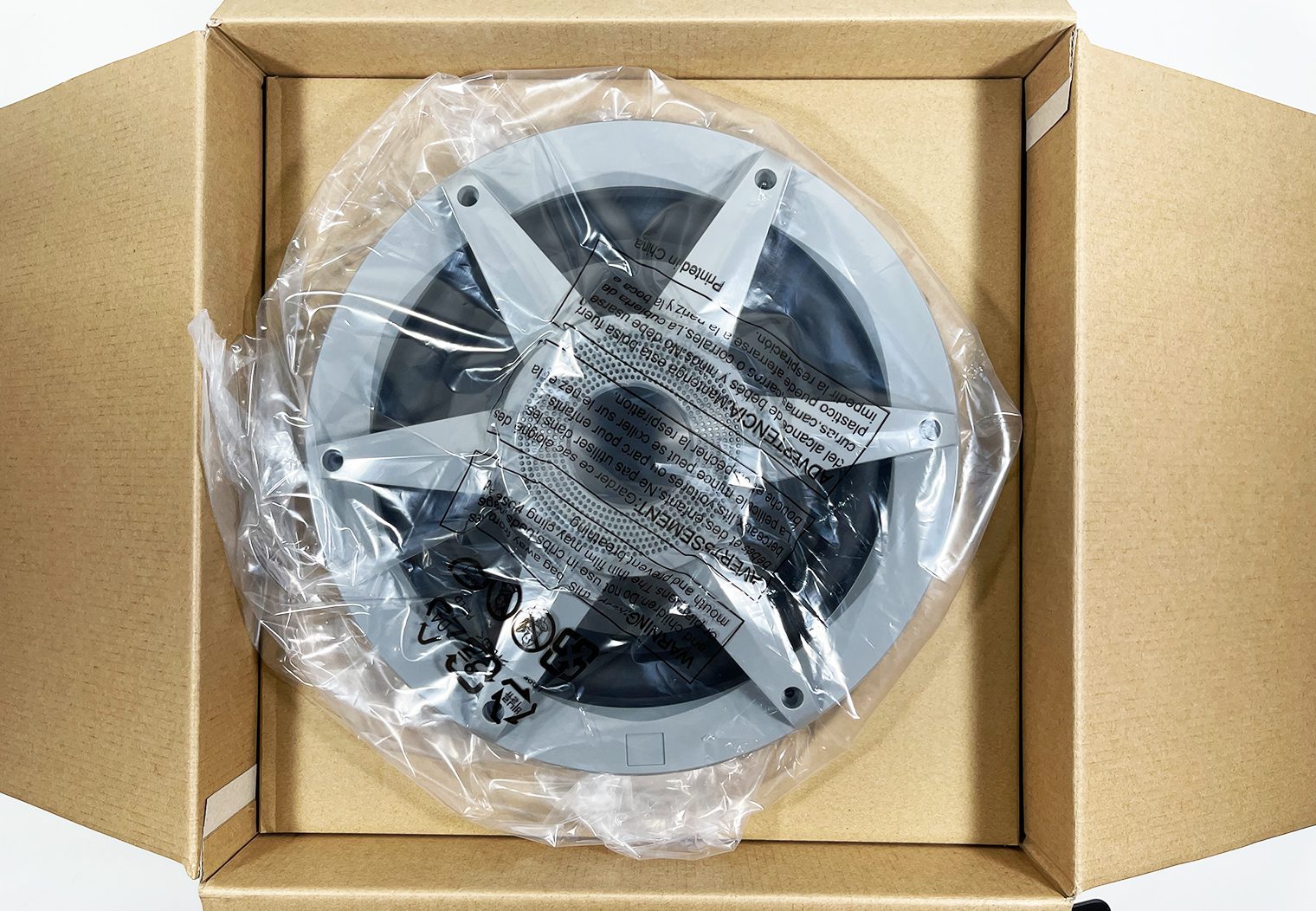
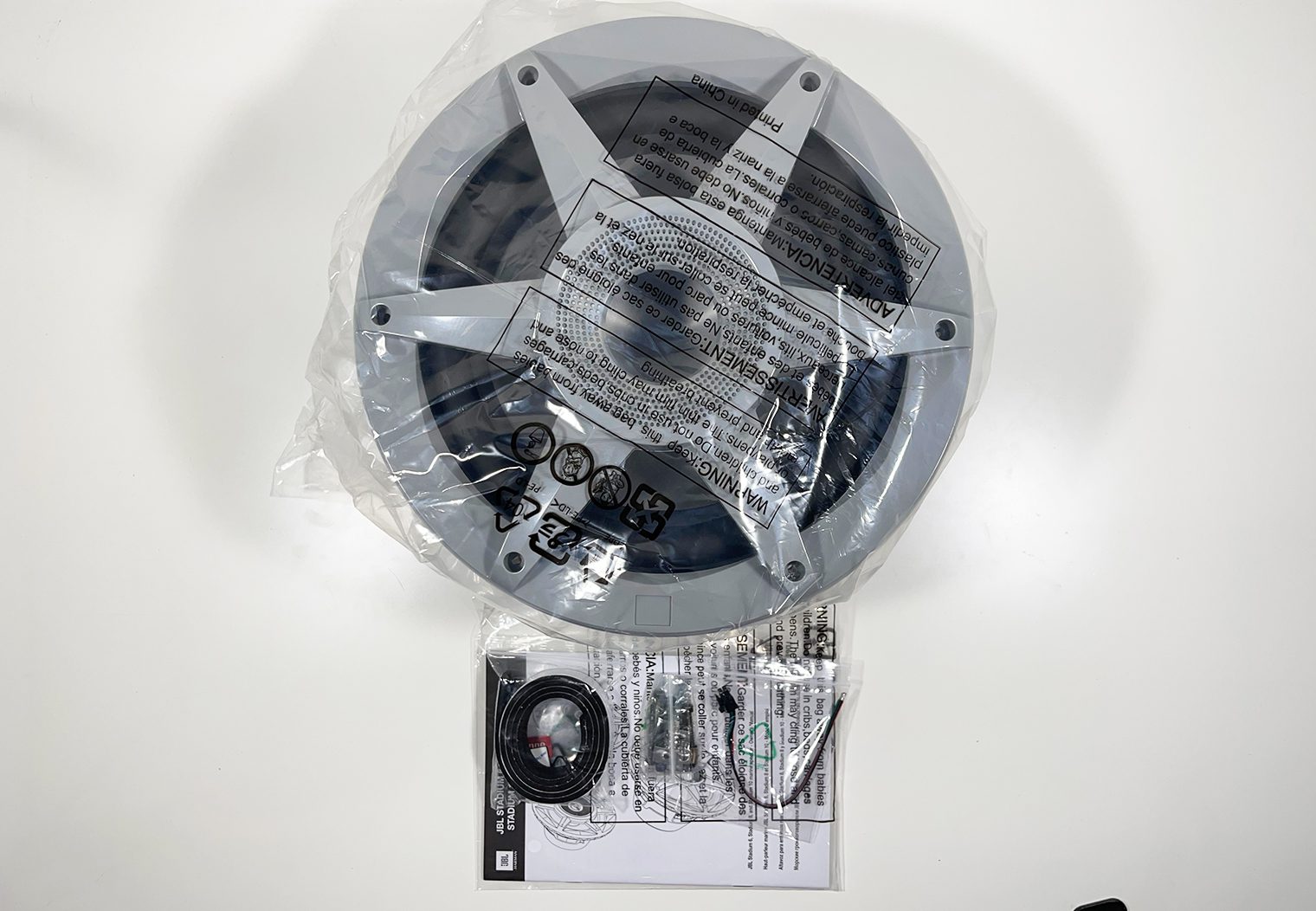
All three speakers share a 6 spoke grille design that's clean and stylish. The biggest difference between the three designs (from a style perspective) is just the overall size of the speaker and the look of the grille. You can see in the pictures above that the 8 inch set is a pretty large set. It takes up a good portion of my bench. They come with a separate set of mounts that are designed to house and install the midrange and tweeters separate from the main driver.
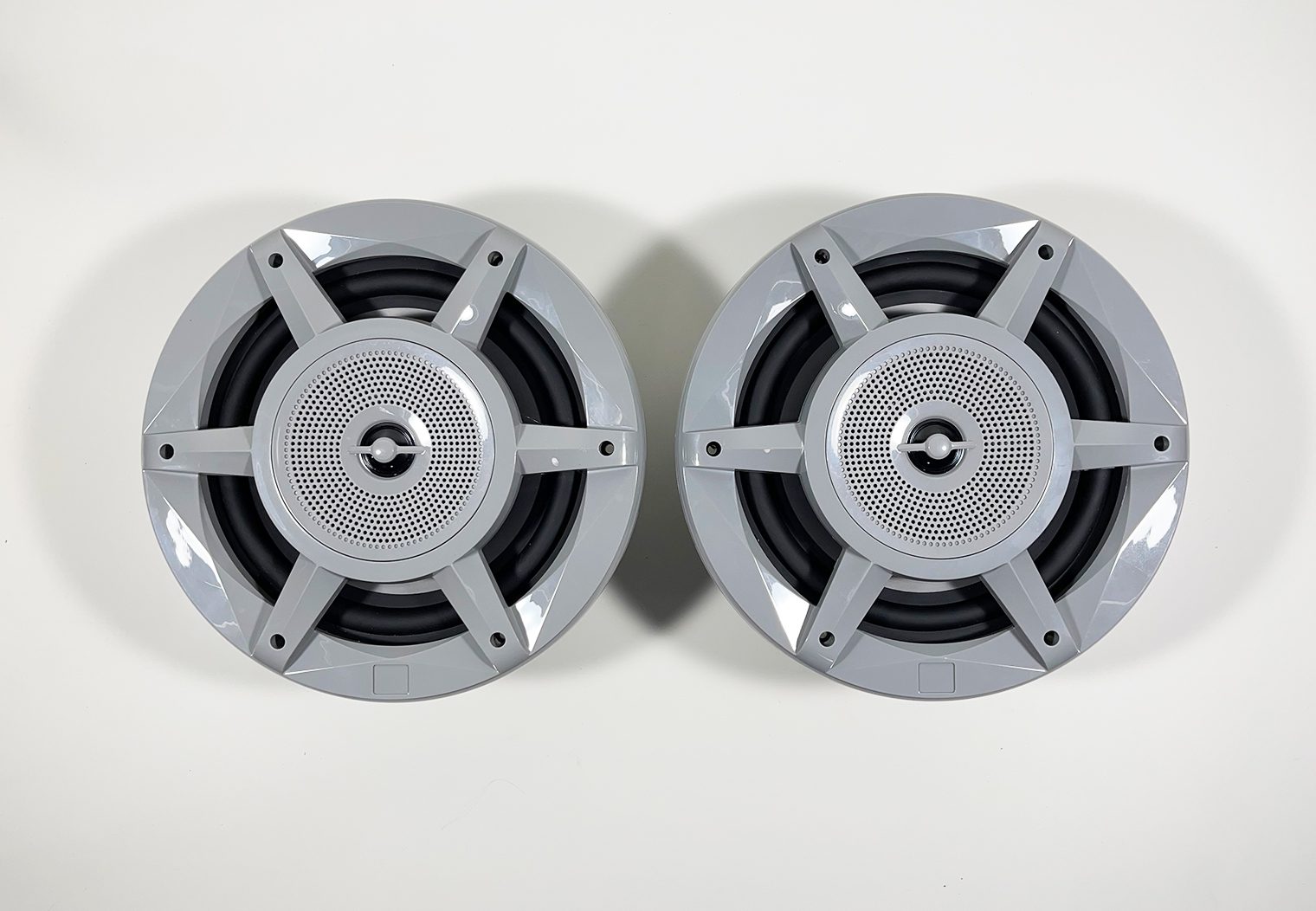
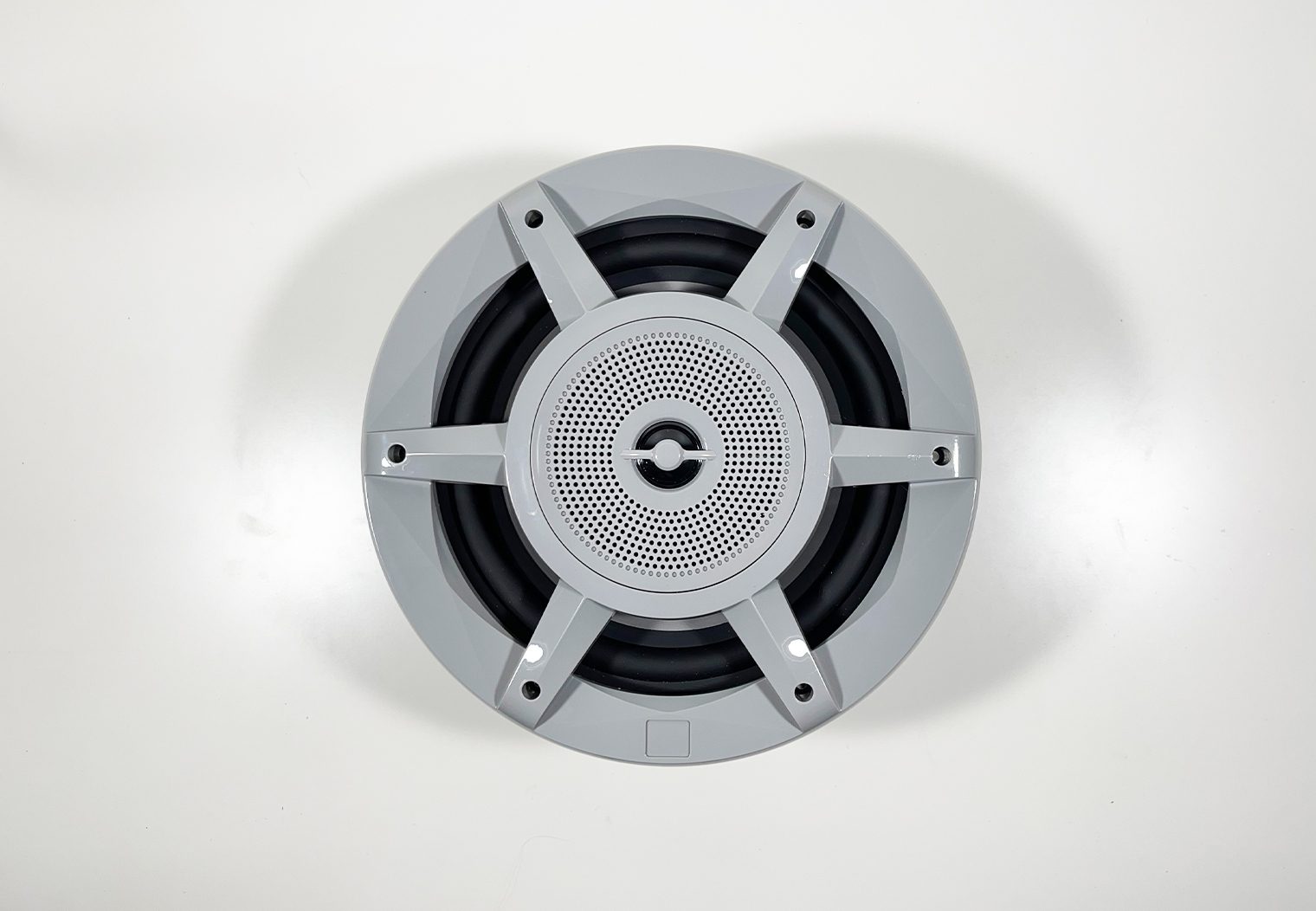
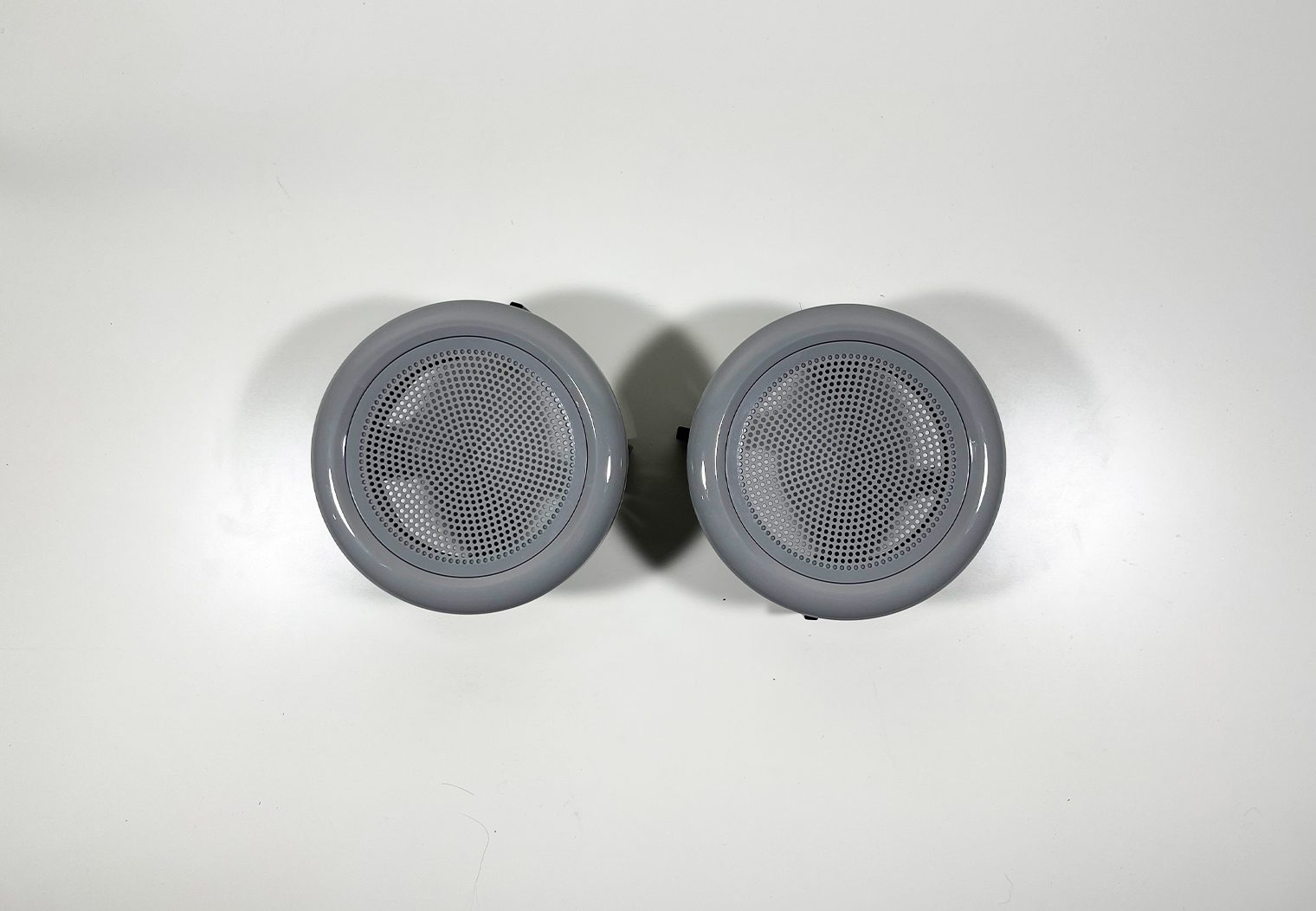
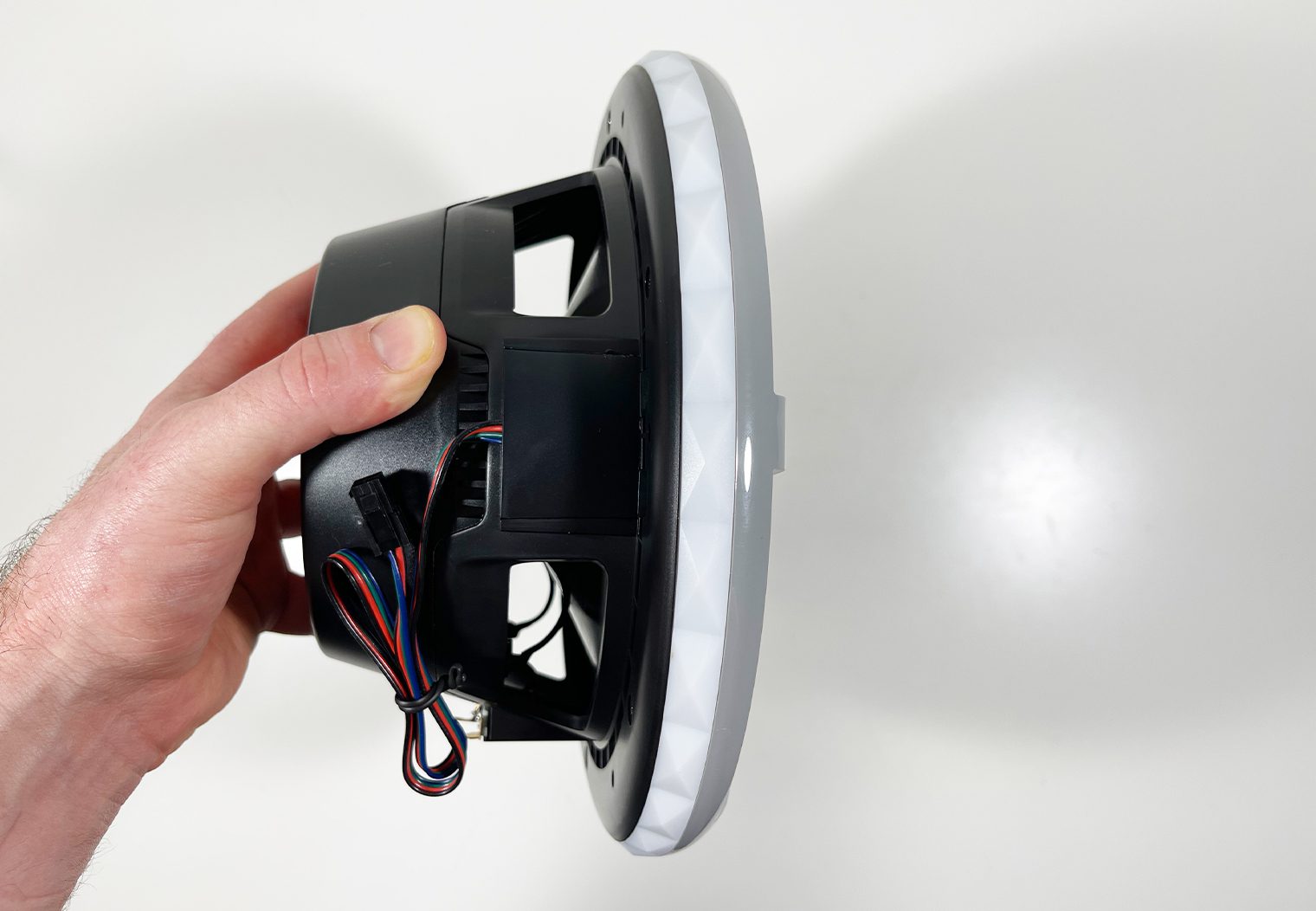
The 6 1/2″ speaker set is your traditional coaxial speaker with a 1″ mylar dome tweeter. Unlike the 8″ choice, it's a 2-way speaker (doesn't have a mid-range) and the grille/tweeter is not removable. However, similar to the 8″ speakers, the tweeter is suspended above the cone. You'll notice that if you place your fingers underneath the tweeter, there's a space between the back of the tweeter and the cone – it does not mount to a fixed pole that protrudes from the center of the cone. I like to see this design, in particular on 6 1/2″ boat speakers and 5 1/4″ speakers because it allows for the cone to have more surface area. More surface area on the cone can help a small speaker produce bass and lower frequencies better. In the boat world where speakers are mounted in an open area, this is particularly important because bass does not carry as well as it would in an enclosed vehicle.
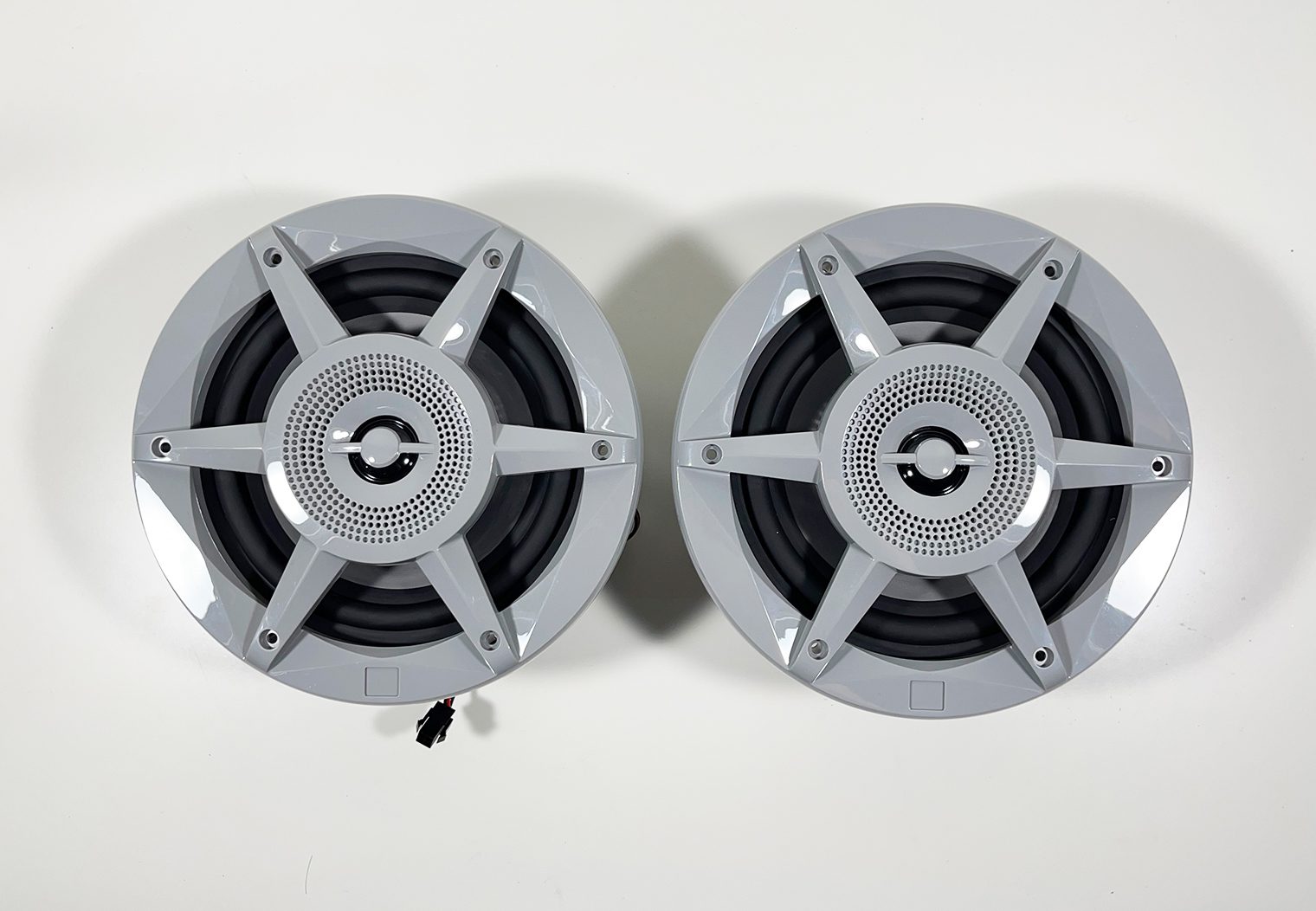
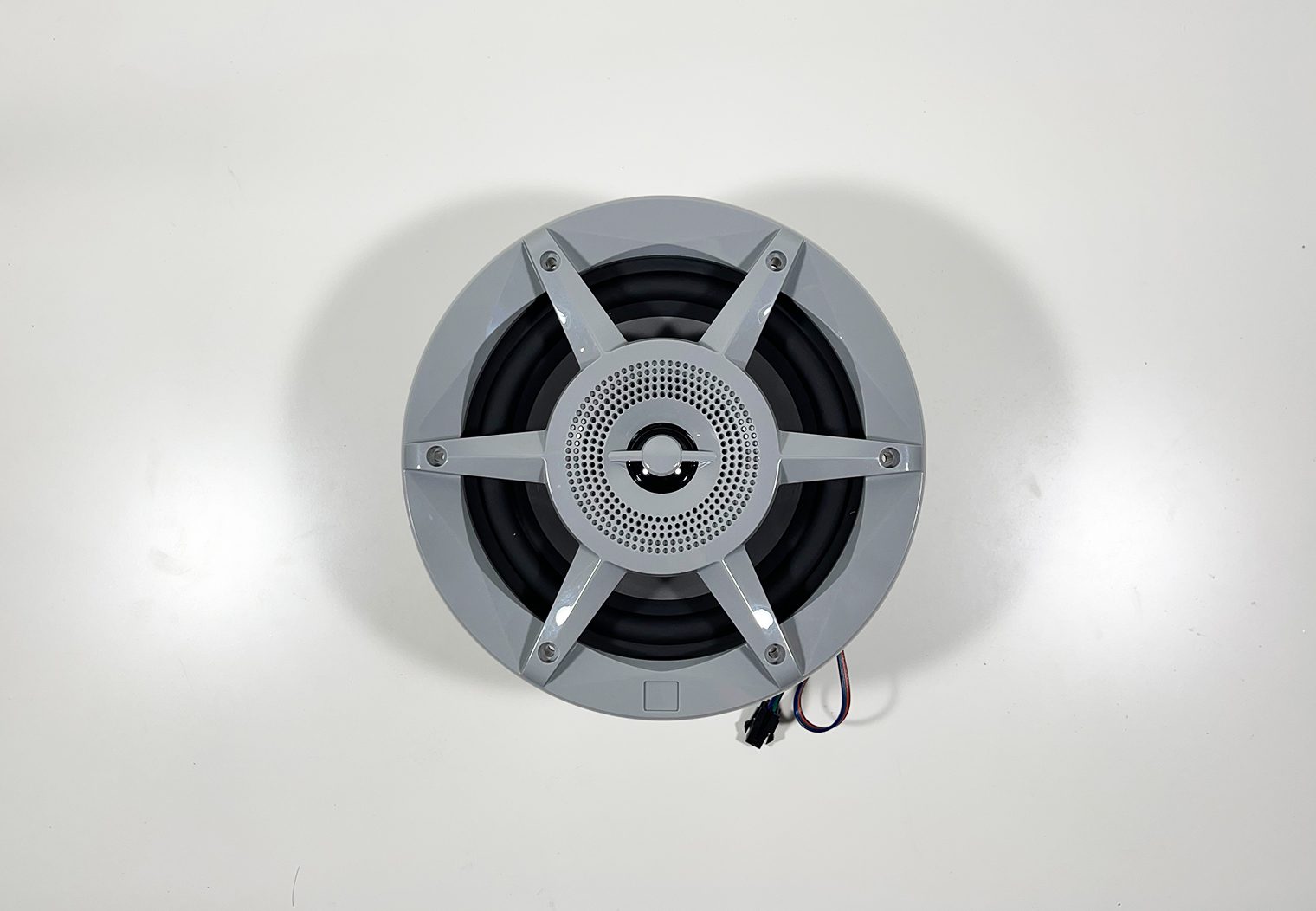
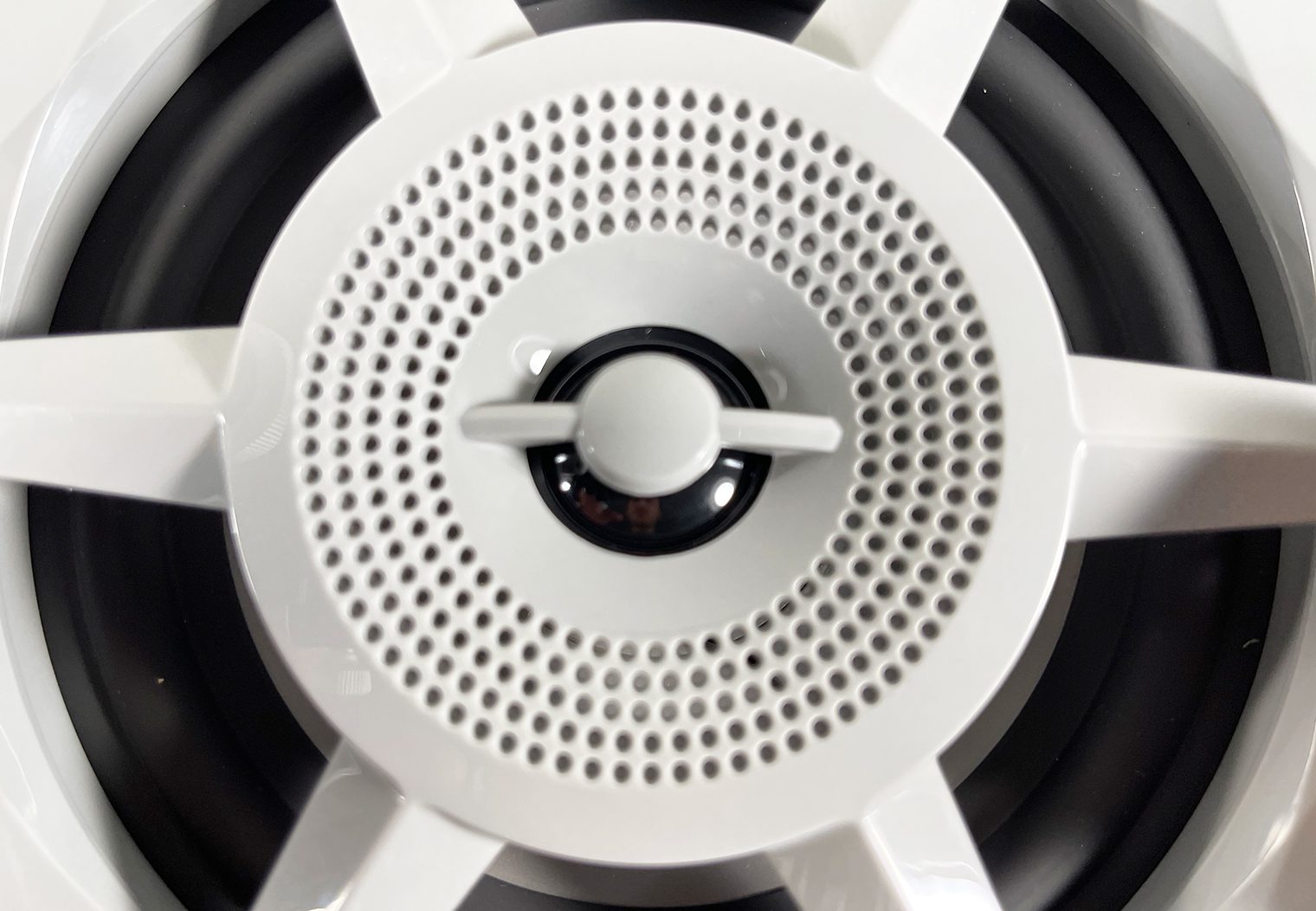
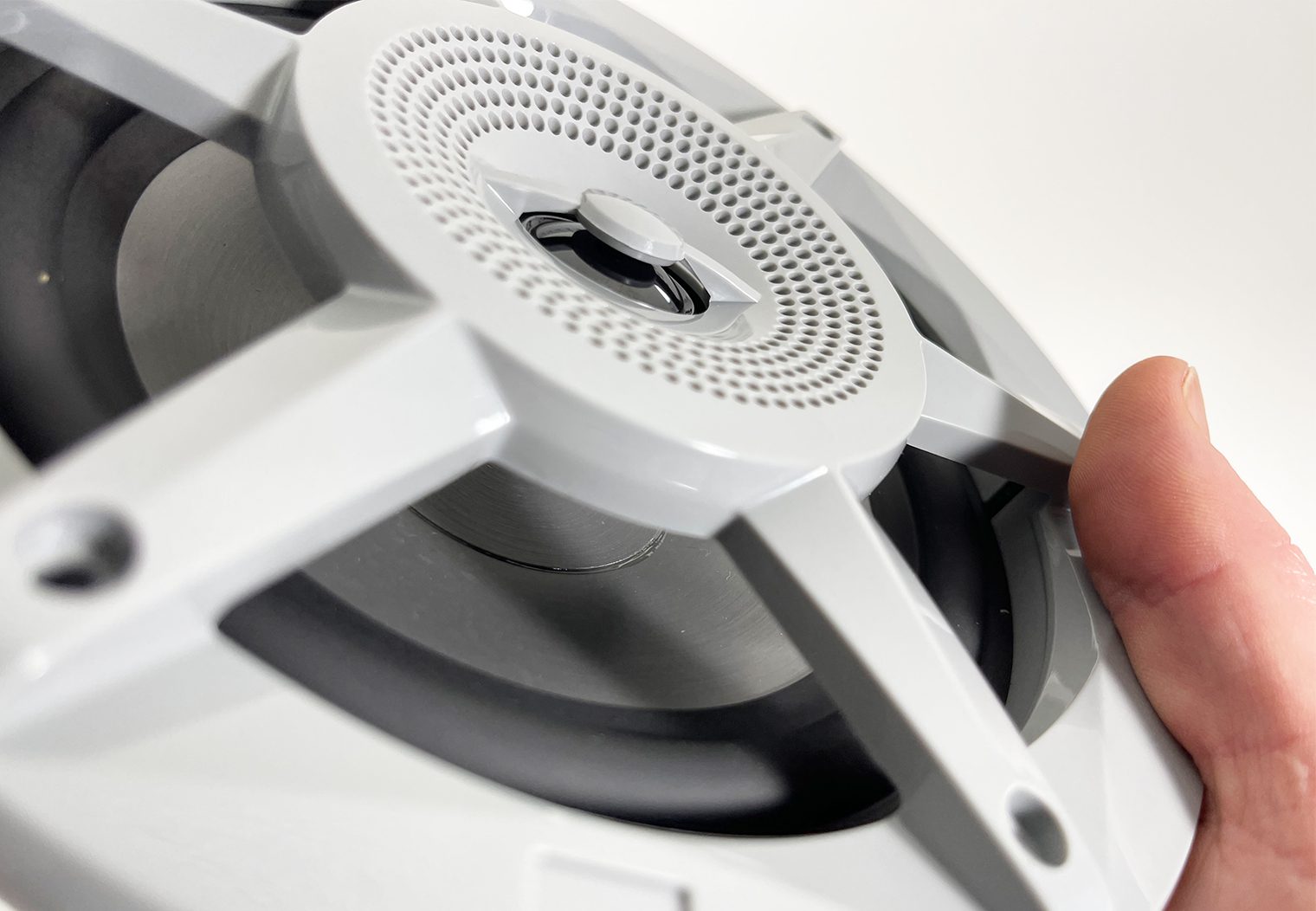
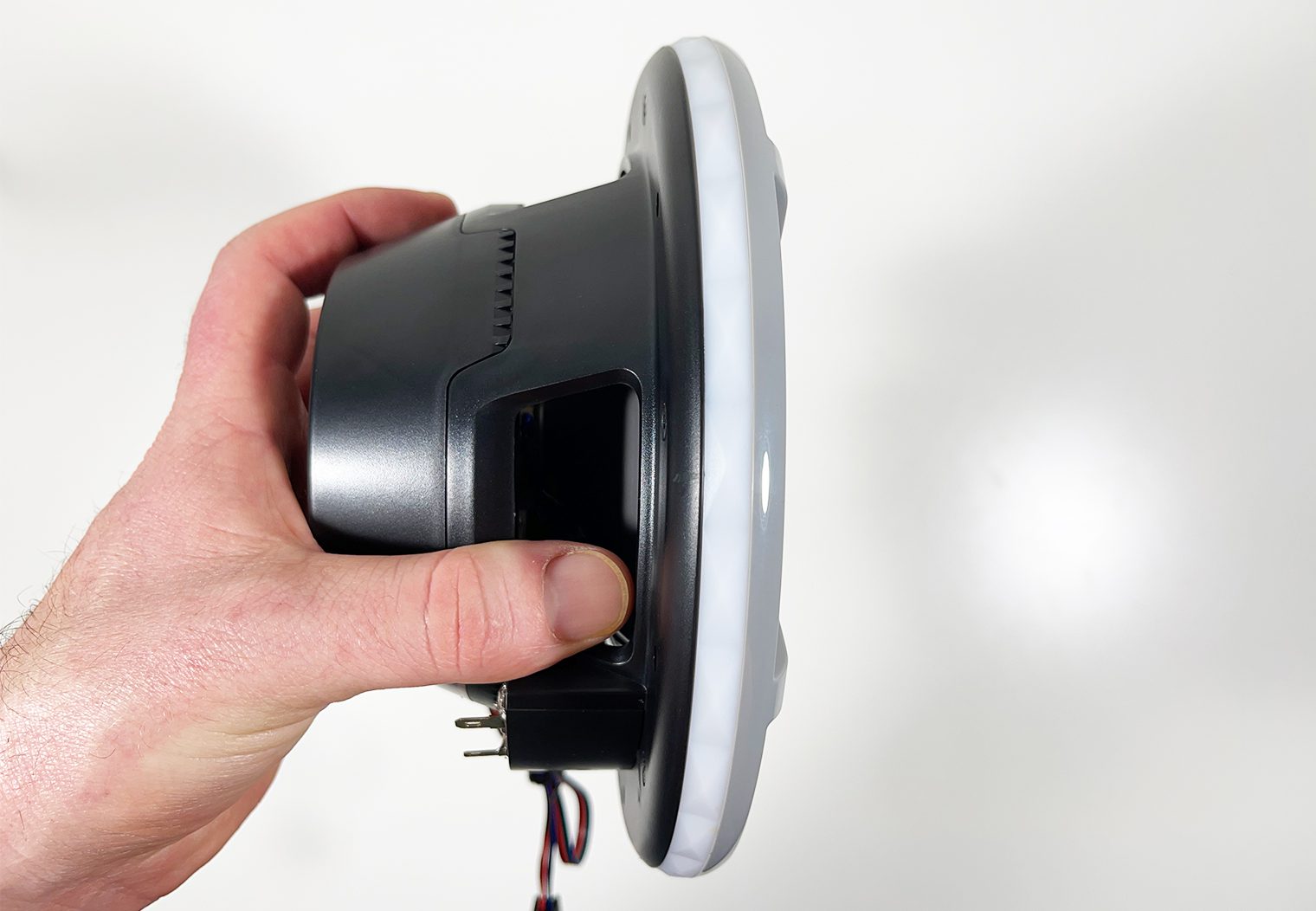
The 10 inch marine grade subwoofer is Free Air by design, which means that it's great for applications that don't necessarily have a traditional enclosure. I installed free air subwoofers on my Nautique G23, because behind surface that I mounted the subwoofers to was open space in the bow. But you could also install the Stadium Marine 102 in either a ported or sealed box if you wanted. Be sure to follow the instructions, which will define the volume of the enclosure for both applications along with the frequency to tune it to. And if you're wondering what a free air subwoofer is and how it differs from traditional subs, check out our free air subwoofers defined article.
It has a little more simplistic look since without the tweeter design that the speakers have, but very similar. I was particularly interested in the switchable ohm design when I pulled it out of the box, so that was what I searched out first. It's located on the side of the sub where the terminals are, and I have to say it can't get much easier than how JBL designed it. No need to reference a wire diagram and bridge terminals, just flip the switch to the left for 4 ohms and to the right for 2. And also worth noting, right below the switch are two “Set Screw” terminal connections which use Phillips screws to secure the speaker wire to the sub which is good to see compared to the spring loaded speaker terminal posts that are little more susceptible to corrosion.
On the outer rim of the subwoofer, the LED ring is pretty substantial in size compared to the speakers. Pretty intense. I'll dive into the lighting later in the article and demo the 6 1/2″ set to give you first-hand look at the colors and overall looks, but the subwoofer in particular made me want to demo the LED features.
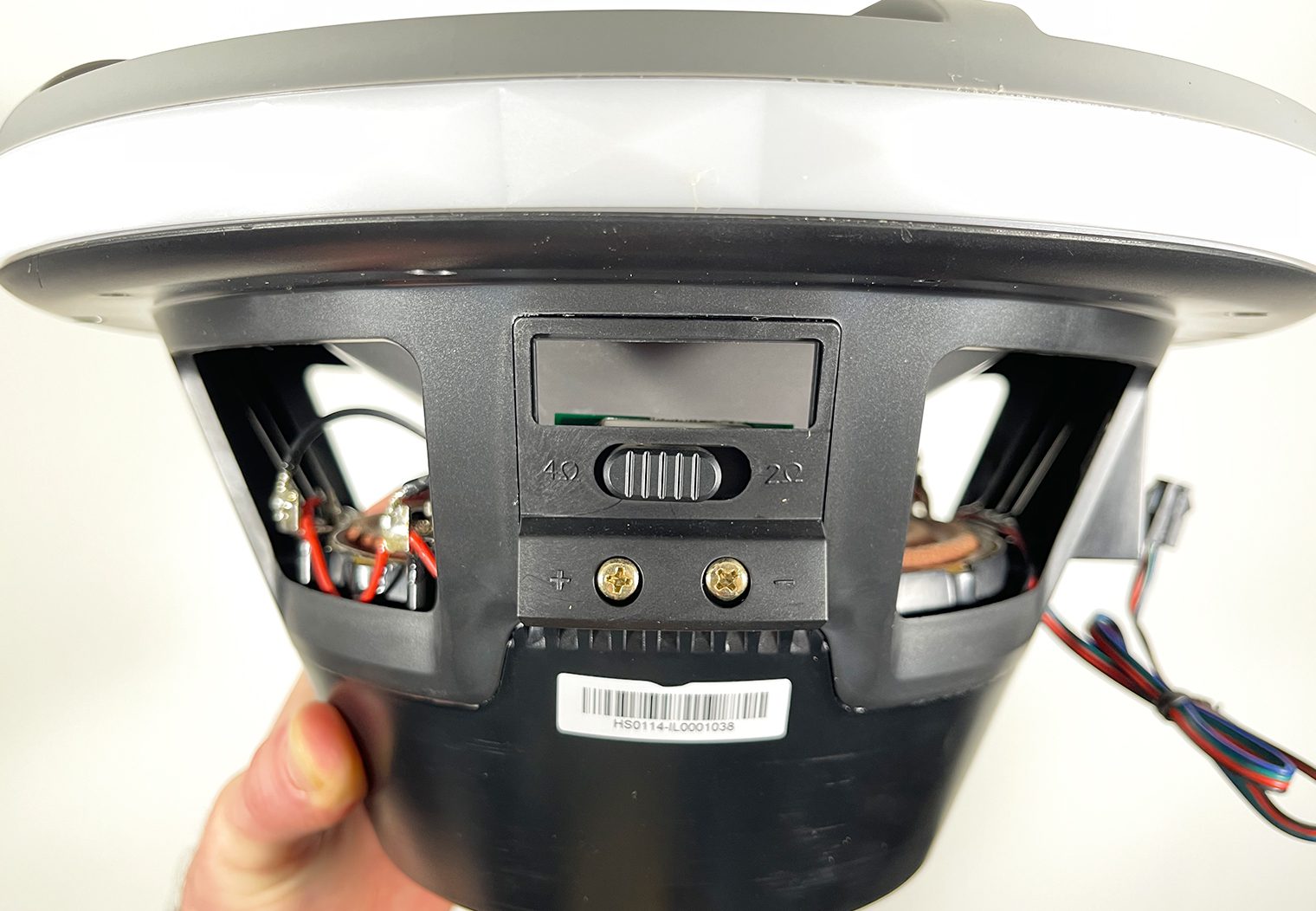
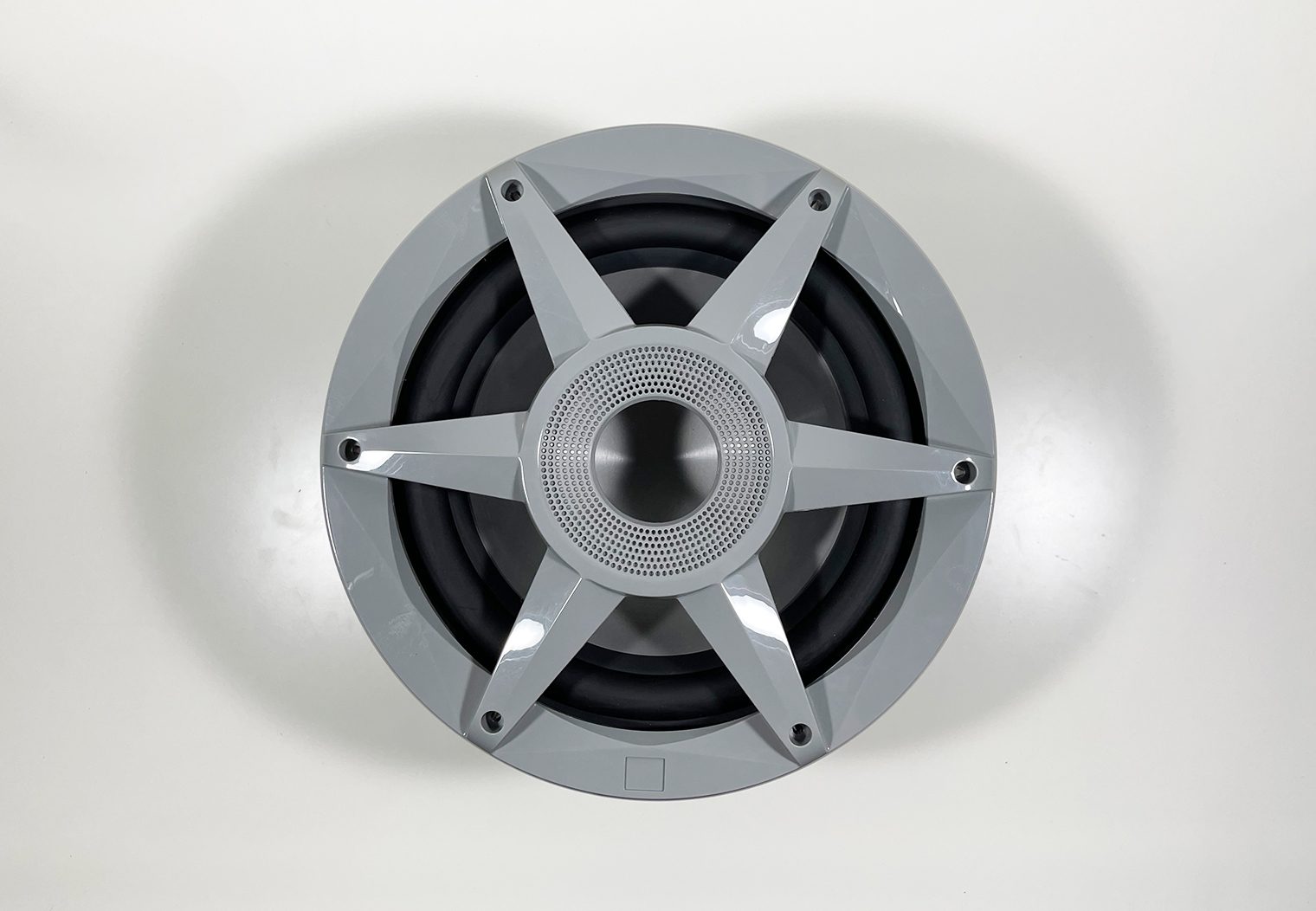
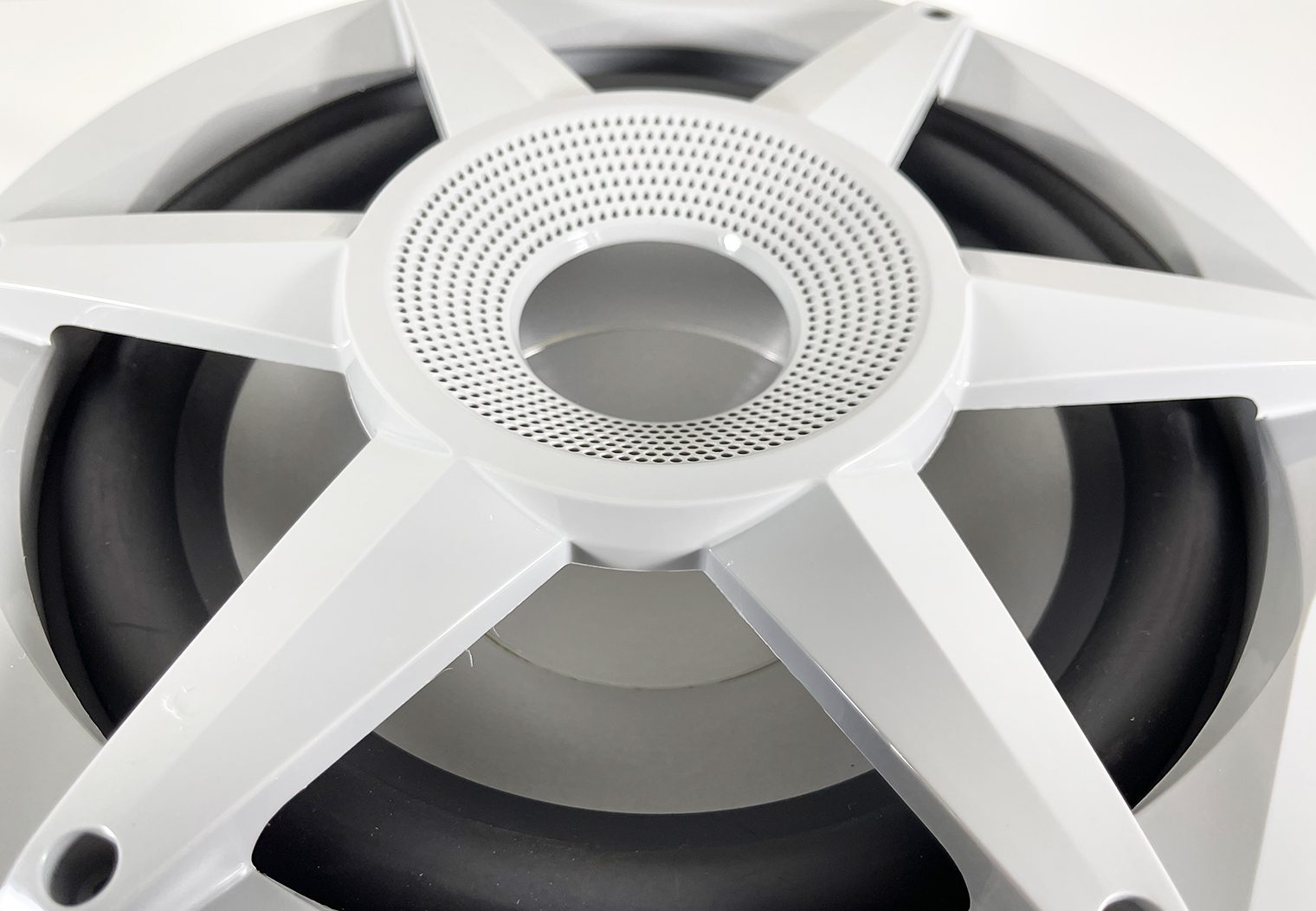
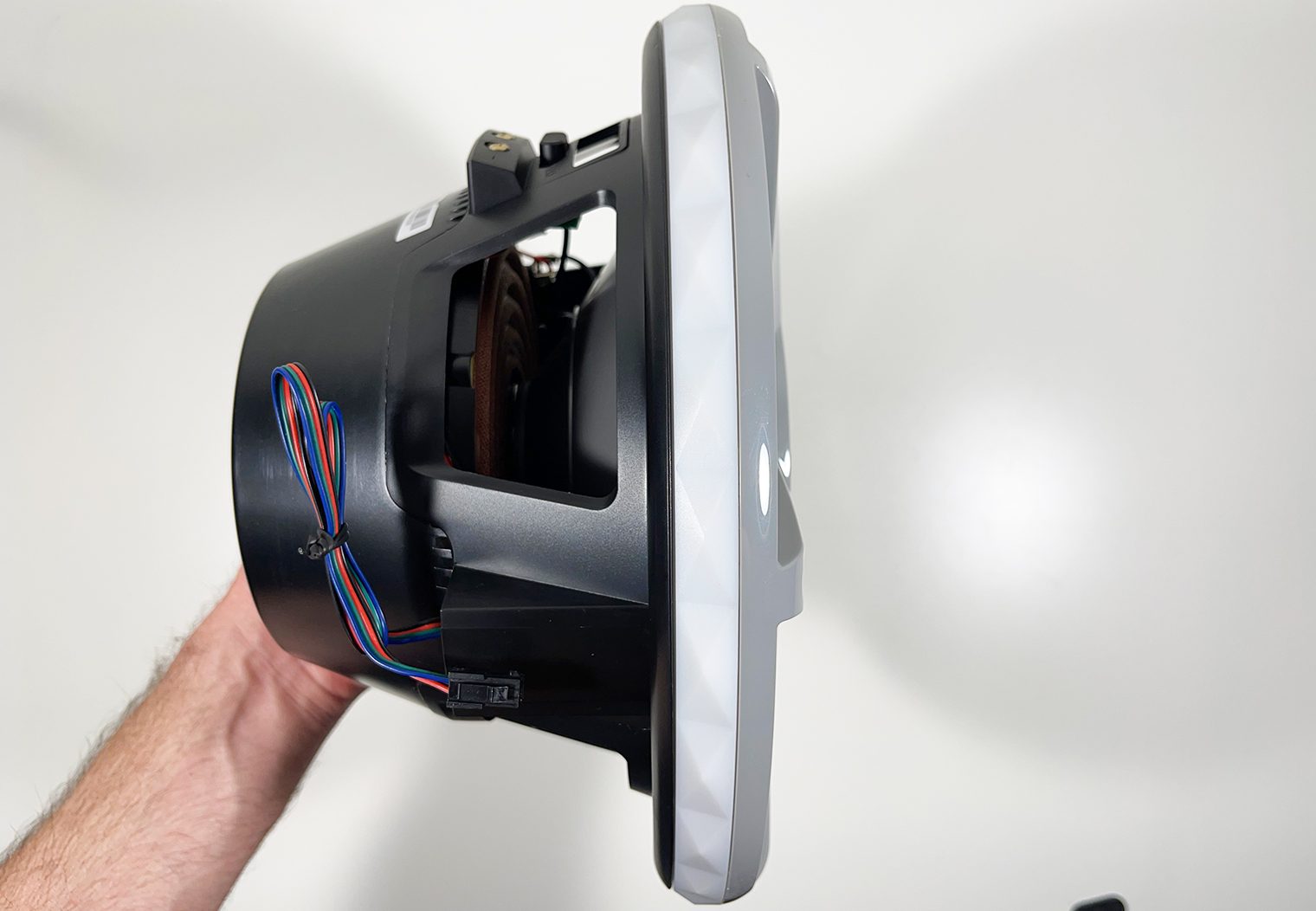
Marine-Specific Features
So let's talk about some of the marine-specific features first. UV protection, splash resistance, heat and cold resistance – these are features that are very important when you're looking into a speaker for your boat. They're likely going to be subject to harsh environments, whether that be on a wakeboard boat on the lake, or a cruiser on the ocean. When I look at marine speakers I’m looking for things like; how well they’re sealed, what type of plugs they have, the hardware and materials that they use, and so on. All three of these speakers share a lot of the same technology and features, and I think that marine-readiness is a good example of that. The entire Stadium Marine lineup is rated IPX3 overall, with a IPX5 rating from the front when installed.
IPX3 basically means that the speaker can withstand sprays of water up to 60 degrees for a certain duration of time, while IPX5 can withstand larger amounts of water (water jets is the term they use when they define the rating vs water spray in IPX3). So they’re IPX rated. Any speaker that isn’t IPX rated is a non-starter for the marine application, obviously.
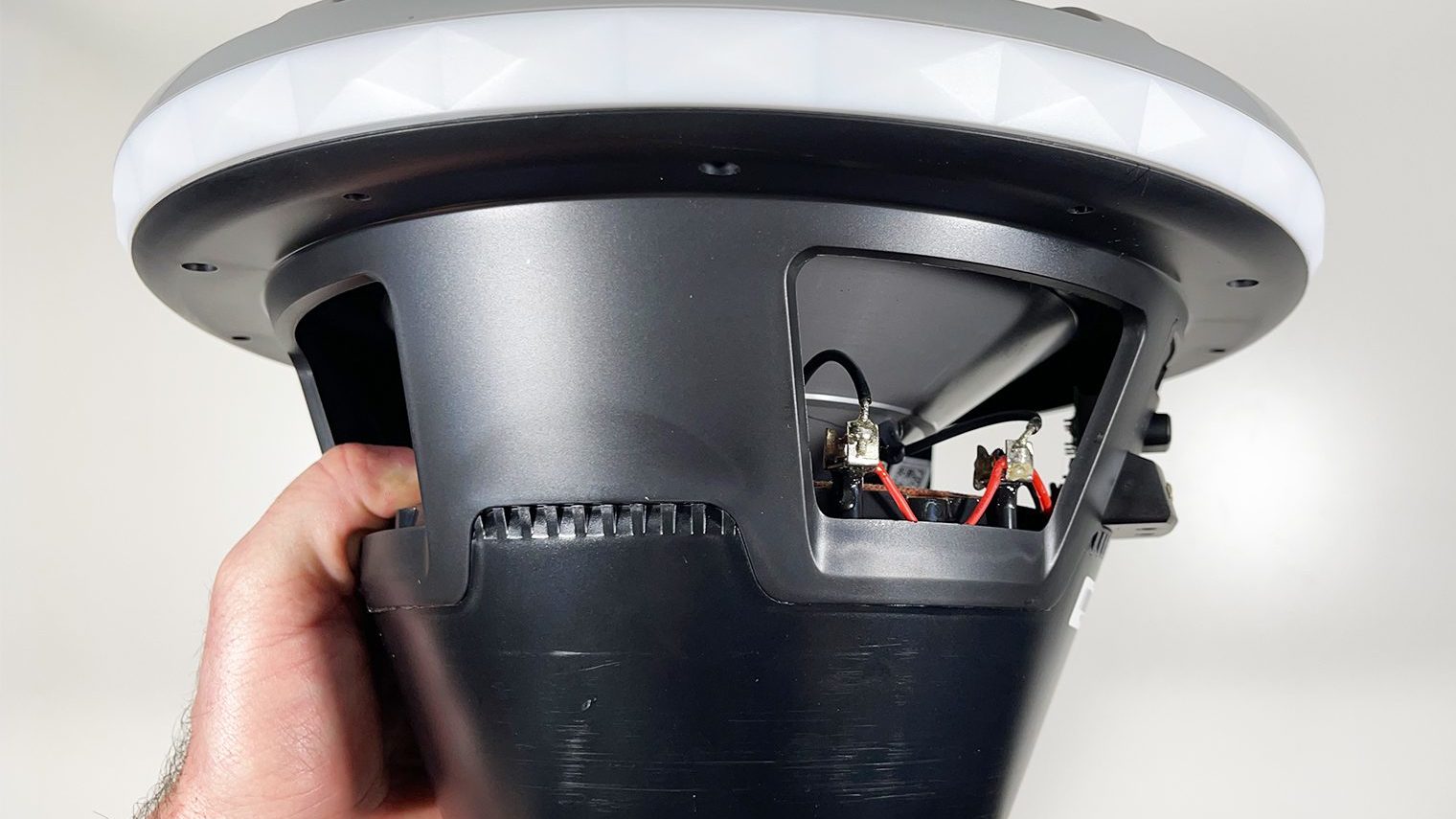
And when you look around the speaker you can see it’s pretty well sealed and protected from the grille and face of the speaker to the motor and terminals. The basket is a one-piece unit made from a polymer plastic and the mylar tweeter is pretty well integrated and sealed in the grille as well. It would have been nice to see the terminals completely sealed off, or the use a water-sealed plug (deutsch plugs are my preferred) but not a big deal. It looks like they’re coated with a corrosion-resistive material so that’s good to see. I also am not the biggest fan of the exposed lead wires on the subwoofer (see the leads in the picture above). This is only on the Subwoofer though. Corrosion will attack the weakest point, so exposed areas like this always catch my eye even if it may not actually have a big impact on longevity.
Overall, I thought that these were marine-ready after a close look despite some of my minor OCD callouts. Very water-tight and most importantly IPX5 rated when they're installed properly.
Speaker Sound, Performance & Technology
From a performance perspective, they fare pretty well on paper. The 6 ½” are rated for 100 watts RMS, the 8” are rated for 200 watts RMS and the subwoofer is rated for 300 watts RMS. I’d probably recommend doubling up on the subwoofers if you’re looking to put these on something like a 27′, 28′ deck boat or speed boat depending on the combination of 6 ½” speakers, 8” speakers that you choose for your install. But for comparison, the JL Audio M6 10” subwoofer has a 250 watt RMS so in terms of power handling the subs are pretty comparable.
Lets talk about some of the unique and proprietary performance features that set the Stadium Marine lineup apart from it's competitors.
Plus One Cone Technology
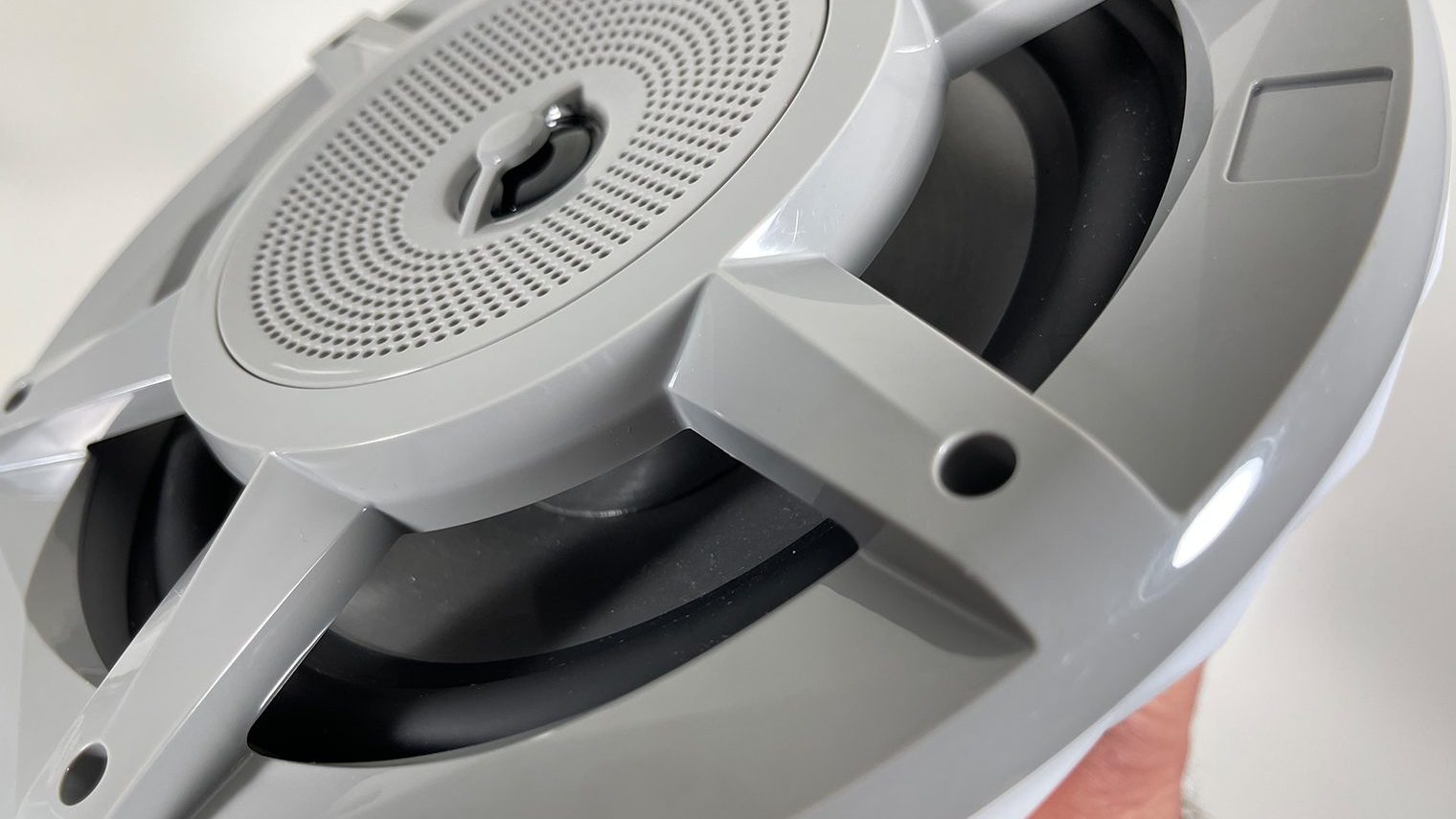
All three speakers in the lineup share a cone that's made from a polypropylene material. In a lot of speaker reviews that I do, I'll detail see some blend of interesting (sometimes questionable) material that's woven for the speaker cones. But sometimes, simplicity is good. Polypropylene is a great material that's tried and true and has great corrosion and UV resistance properties even if it doesn't always have the same performance properties that a more expensive material might have. It's a good choice for the marine environment.
What's important to know about the cones is that the Stadium Marine lineup feature what’s called Plus One cones, including the subwoofer. This technology is shared across many speakers at JBL and Infinity, including their automotive speakers. Simplified, what this means is that when the cones are compared to traditional/standard JBL cones, they’re sizably larger. 35% larger in fact, and what that’s good for is efficiency and responsiveness when producing lower frequencies. I mentioned this earlier when I talked about the suspended tweeter design and how it impacts the surface area of the cone, but I think this is particularly important for the 6 ½” speakers. Same with the 10” subwoofer.
Specs
Here's the specs for each speaker in the lineup:
- power handling: 100 watts RMS (300 peak)
- sensitivity: 92 dB at 2.83 volts
- frequency response: 40-25,000 Hz
- impedance: 3 ohms
- power handling: 200 watts RMS (500 peak)
- sensitivity: 92 dB at 2.83 volts
- frequency response: 30-22,000 Hz
- impedance: 3 ohms
- power handling: 300 watts RMS (900 peak)
- sensitivity: 89 dB at 2.83 volts
- frequency response: 20-2000 Hz
- impedance: switchable 2- or 4-oh
Convertible Coaxial Design (8″ Speaker Only)
Let’s talk about the tweeter design a little more. Both he 6 ½” and 8” speakers feature a mylar tweeter. Mylar is pretty flexible – it’s sort of in between a soft fabric material and a hard material. It’s not a hard material like an aluminum or titanium dome tweeter though, so generally the highs will be a little softer and won’t project as far or carry the same volume that a hard dome tweeter will.
But more than the mylar tweeter material, let’s talk about the convertible mechanism on the 8” speaker. The 6 1/2” coaxial speaker has a fixed tweeter, but the 8” speaker features a 3″ midrange speaker in addition to the 1″ tweeter. And the convertible design allows you to pull the midrange and tweeter out of the center and mount them independently.
This is a truly unique design. I haven’t seen this on any other marine grade speaker yet and I think it’s a great idea. It allows you to either separate the midrange and tweeter like a traditional component speaker, or keep it contained as one and install it like a coaxial. This is especially good on a boat because it'll let you position your midrange and high range speakers higher, where they can be more directional – like on your dash. JBL provides you with a signal wire for the midrange as well, that will plug into the side of the main driver to power the tweeter separately. Let me show you the process of removing the midrange from the grille and installing it onto the separate mount.
Removing the midrange & tweeter:
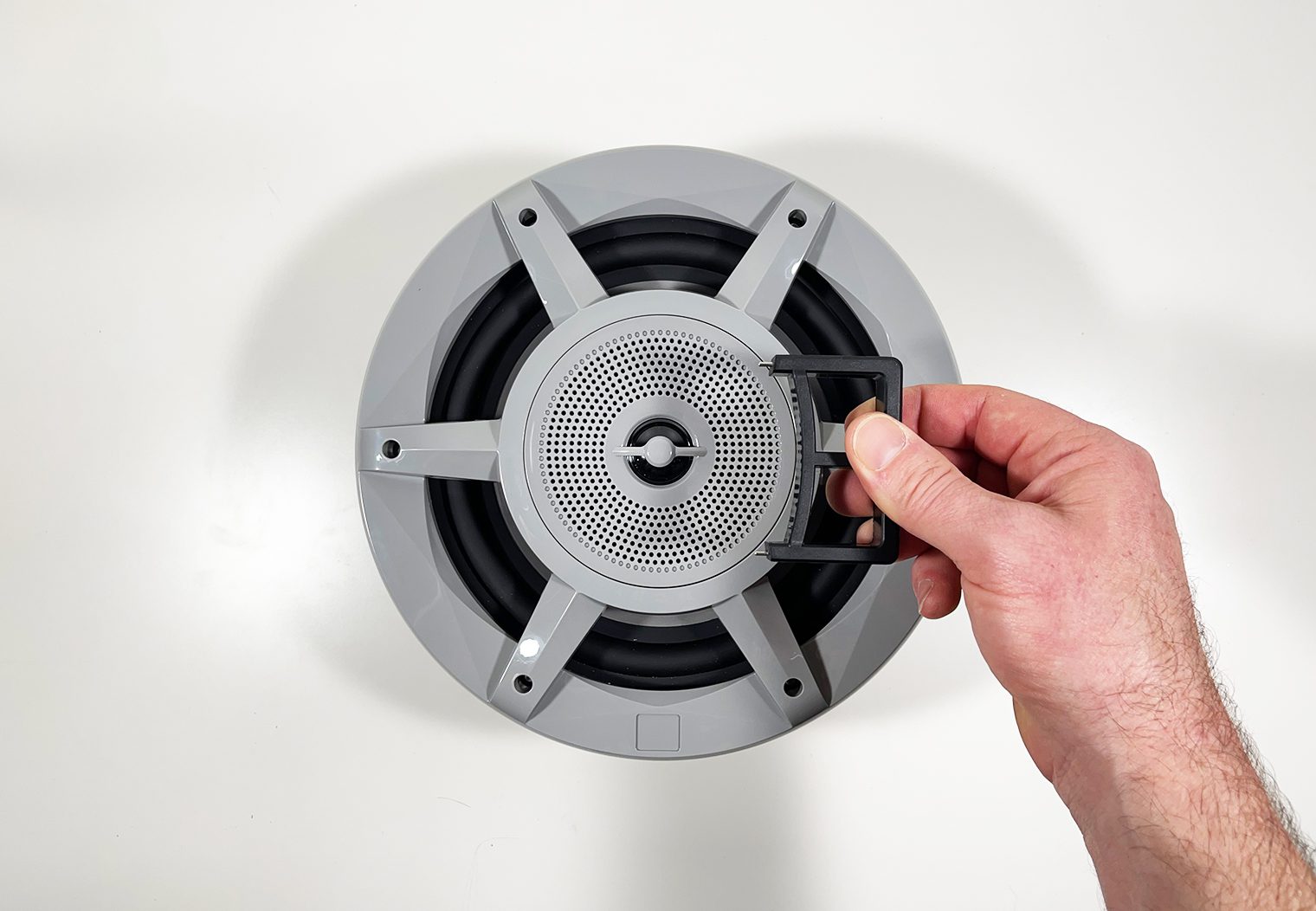
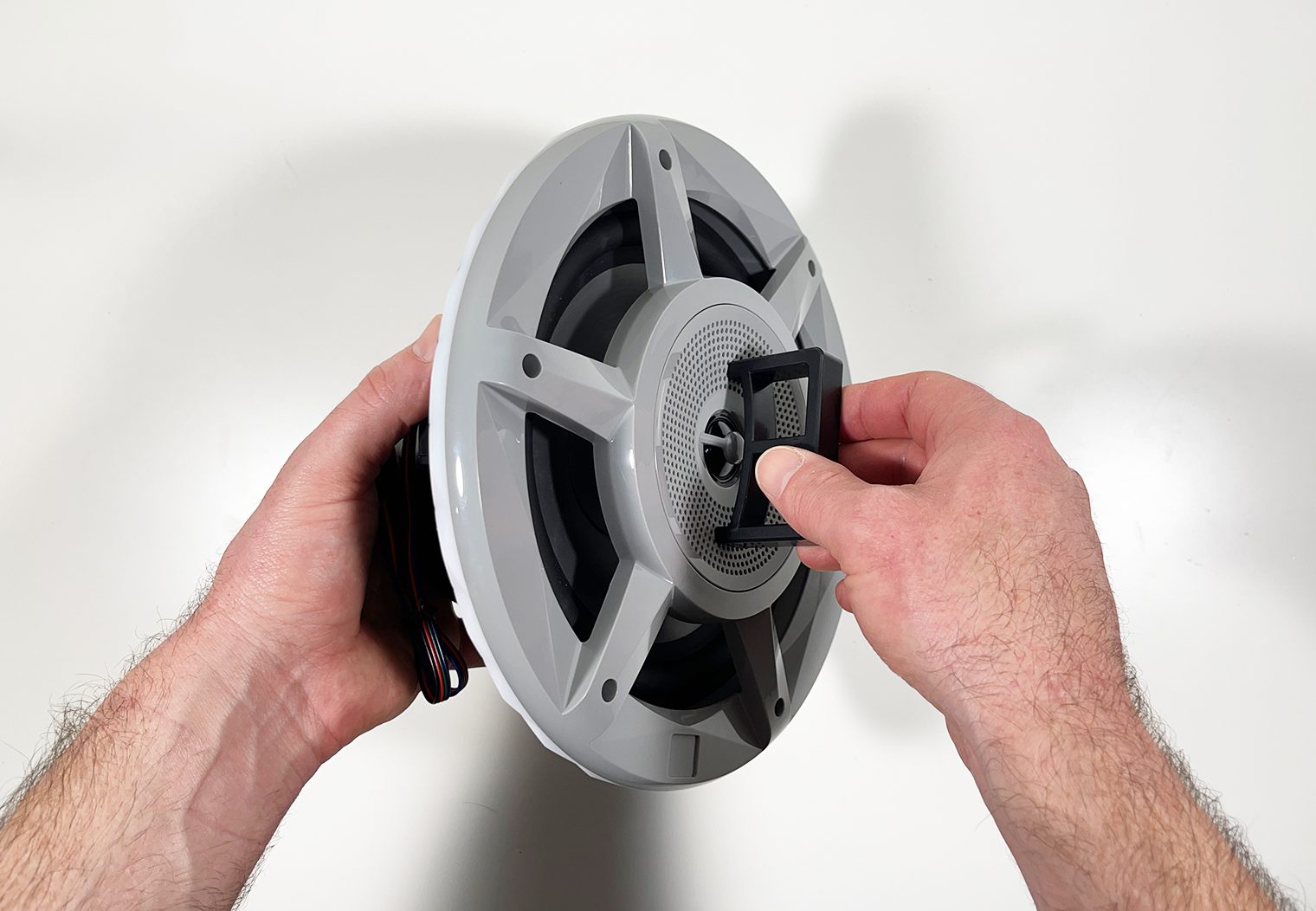
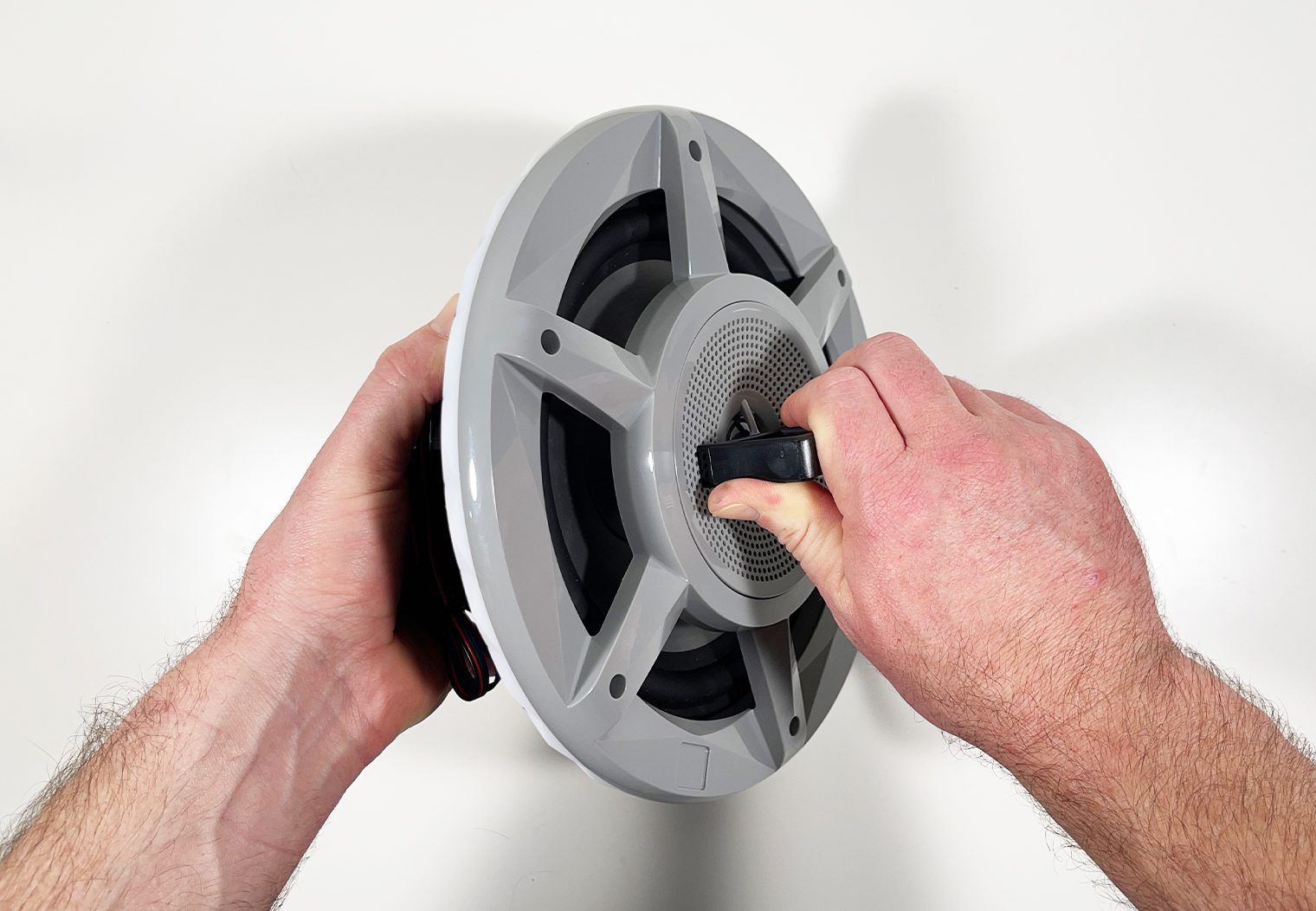
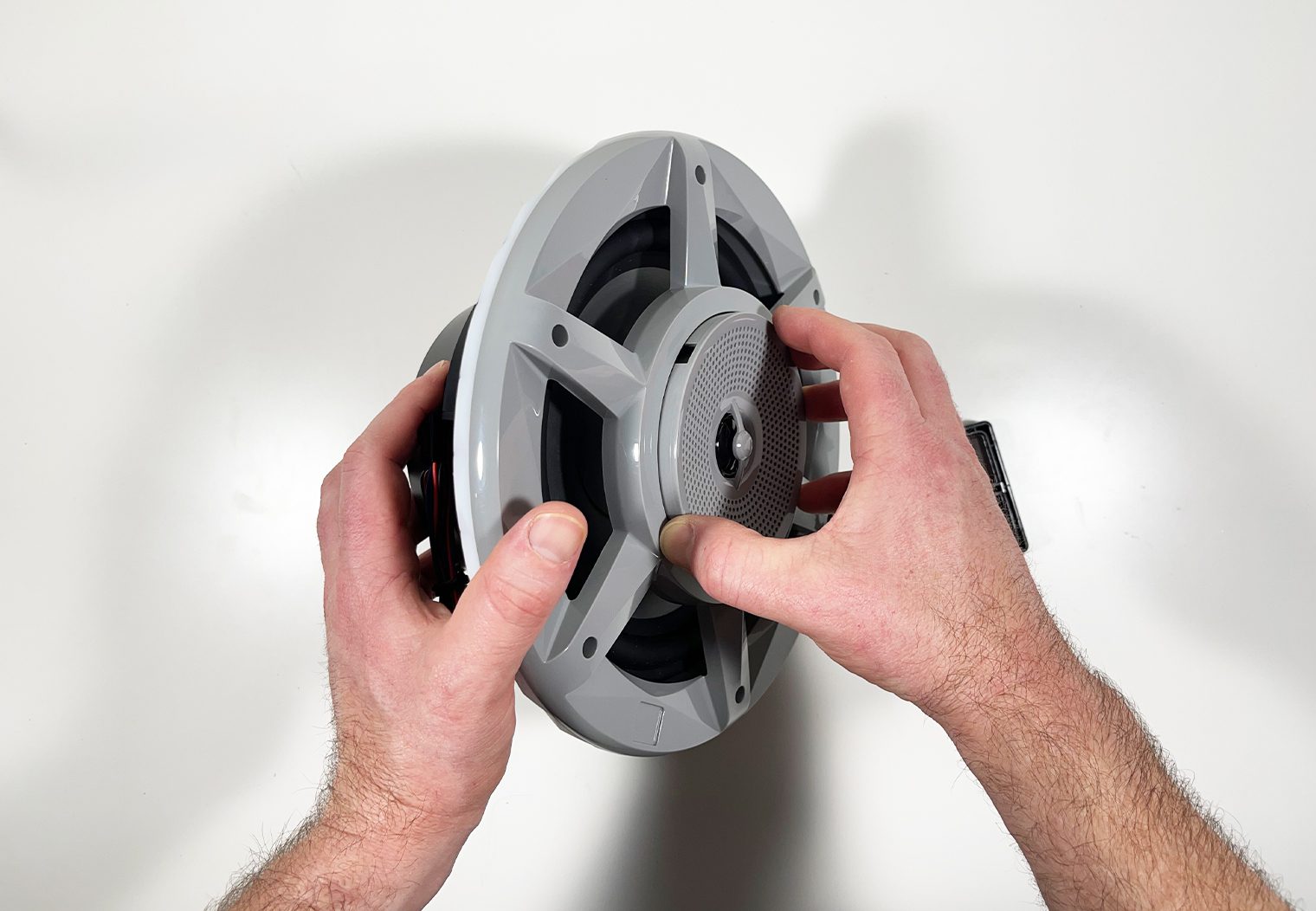
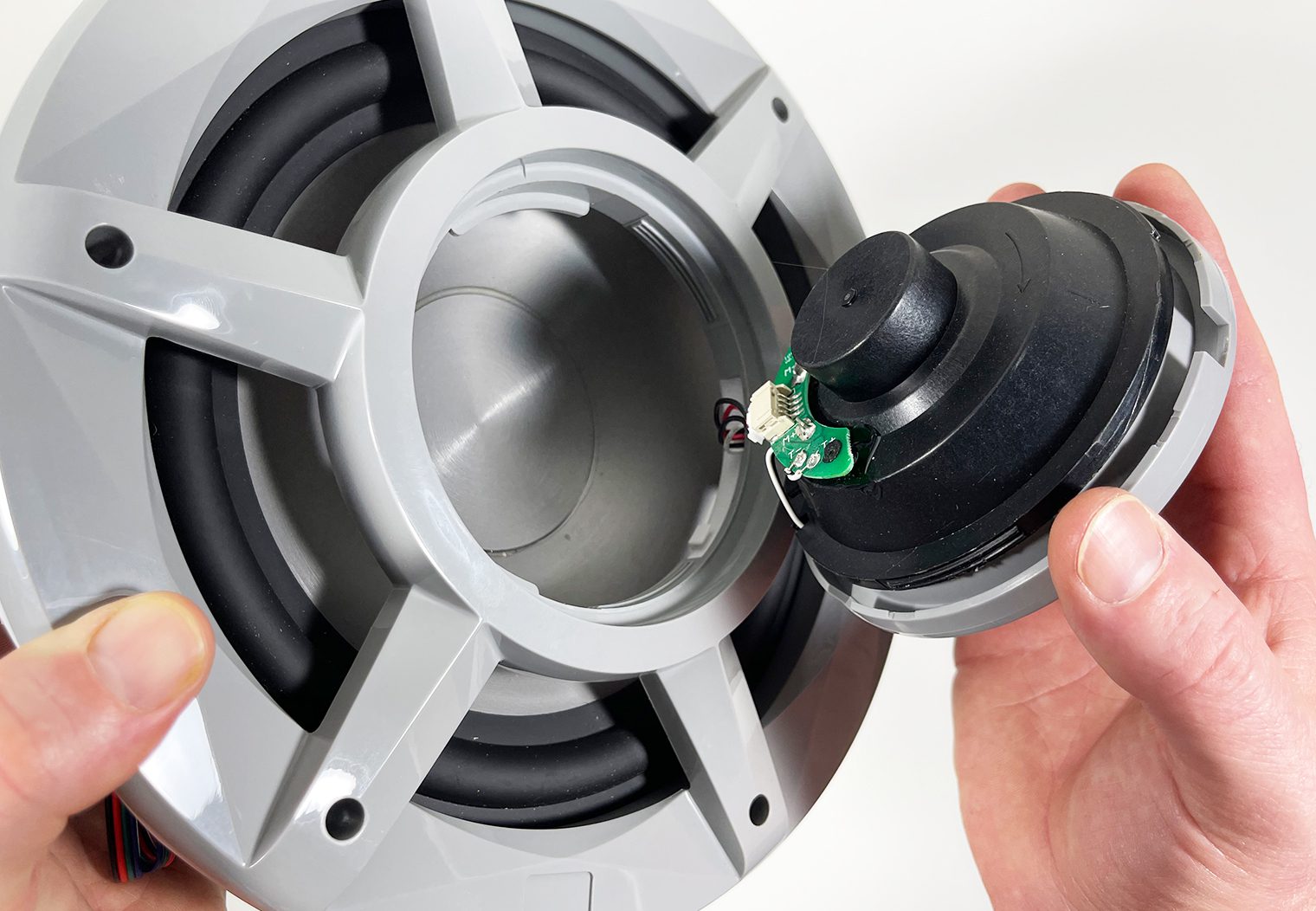
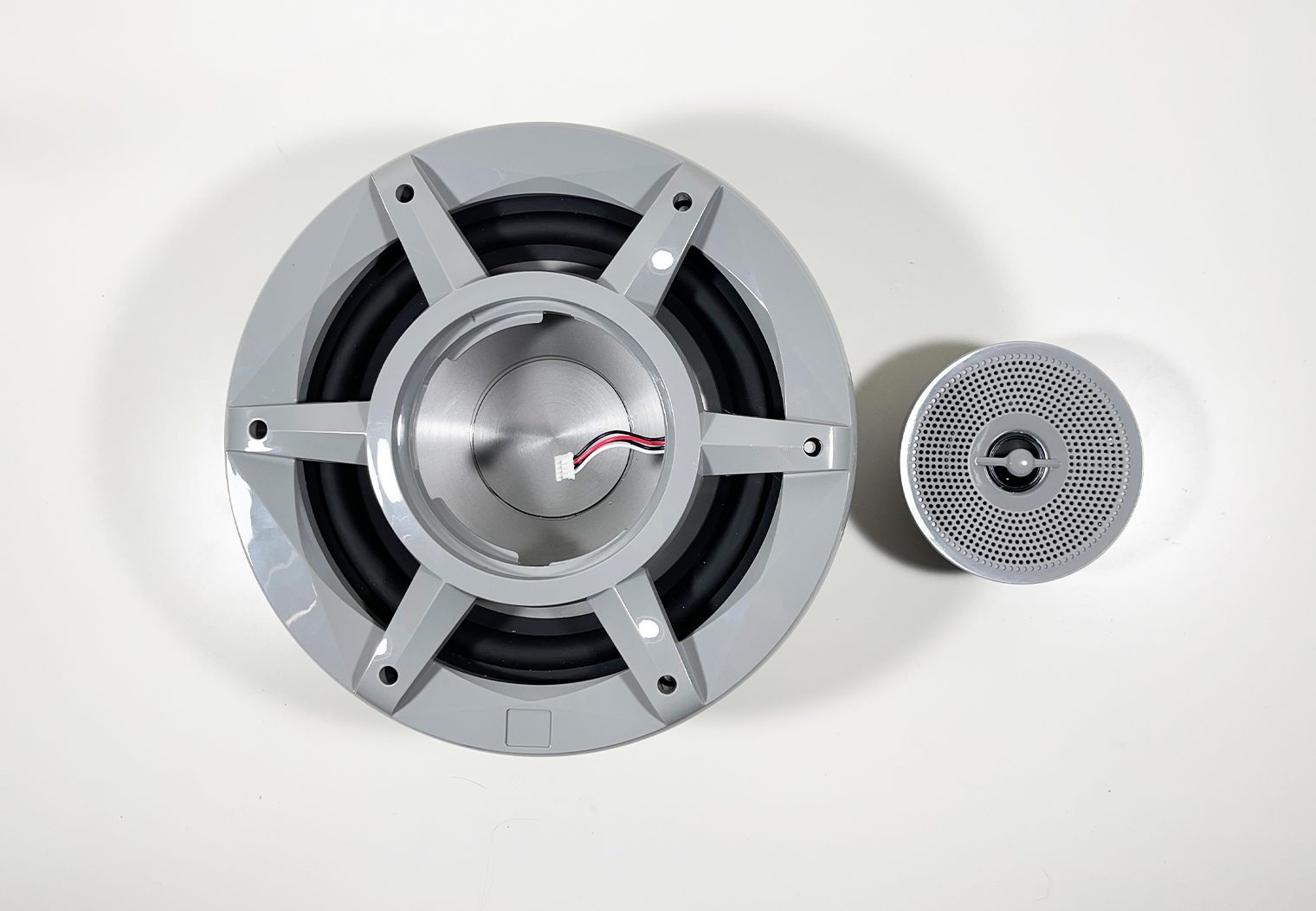
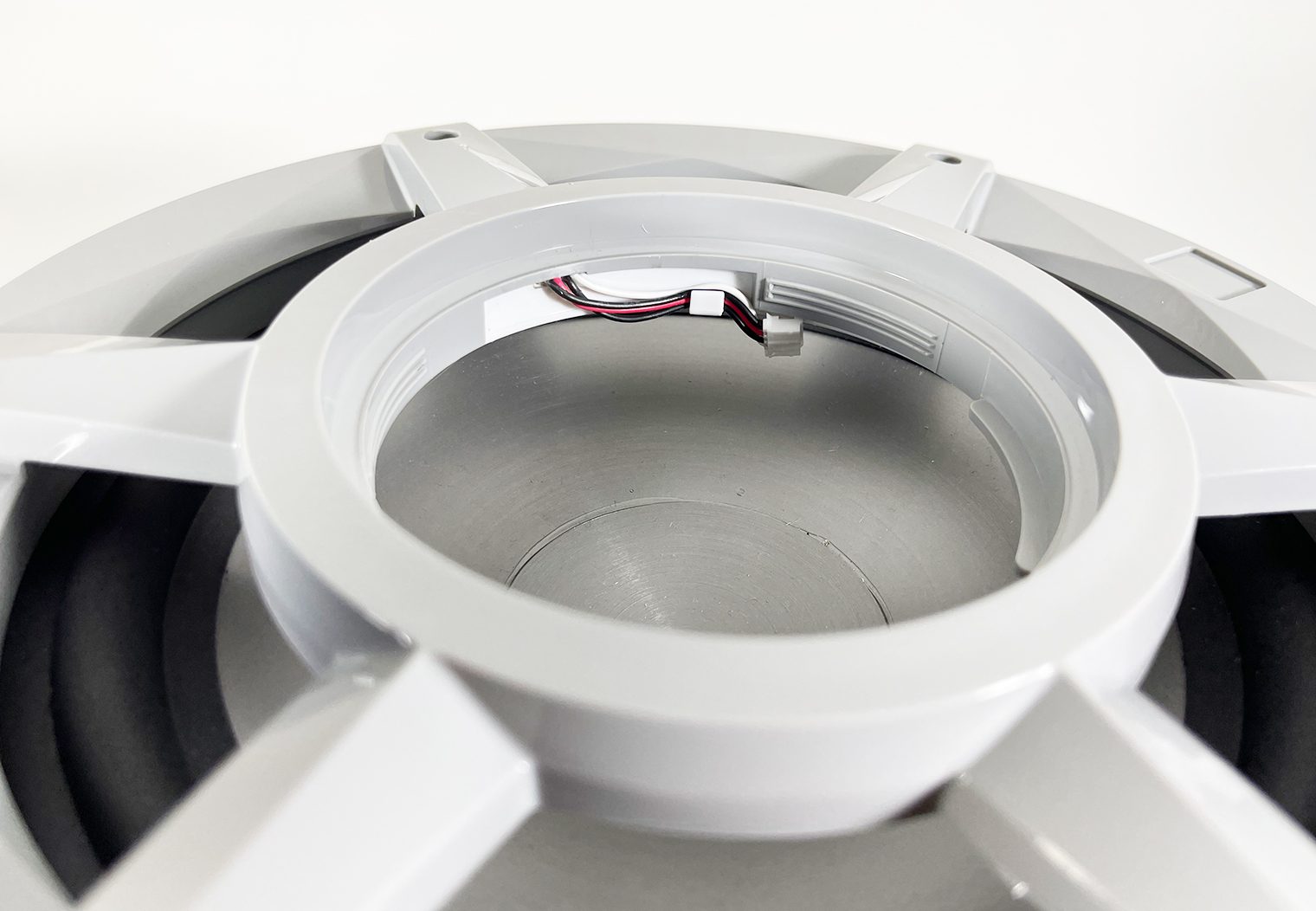
Installing the midrange in the separate mount:
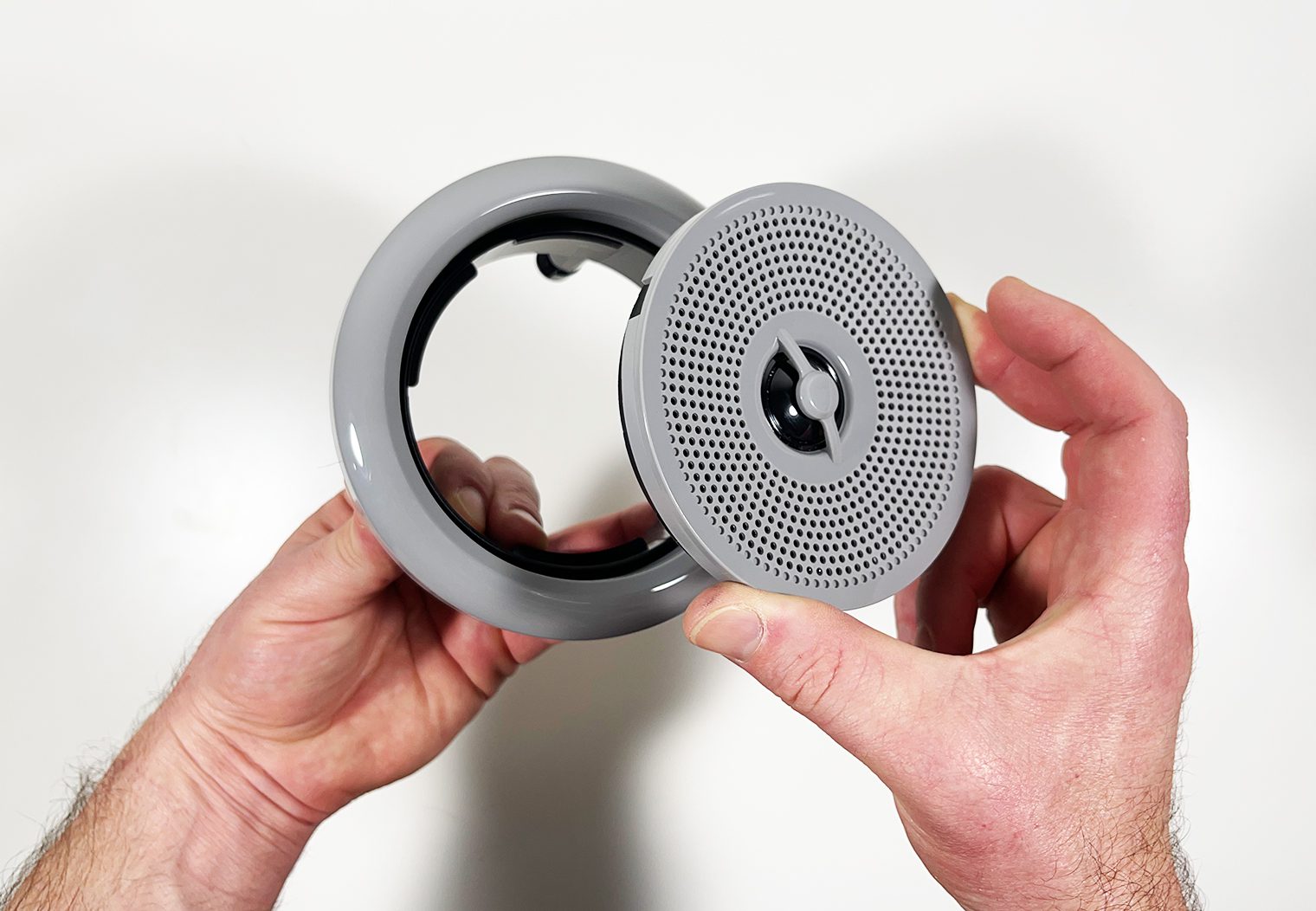
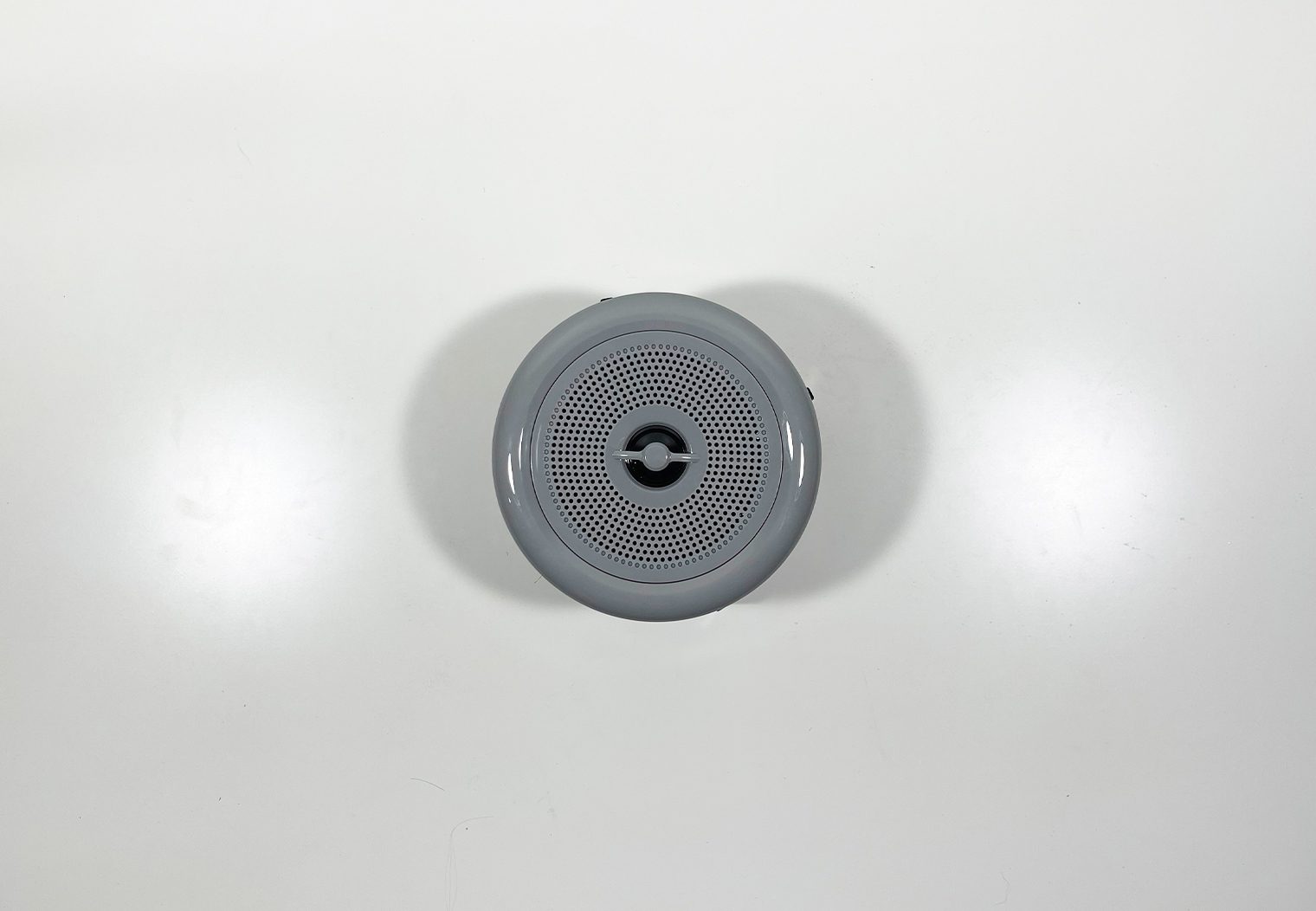
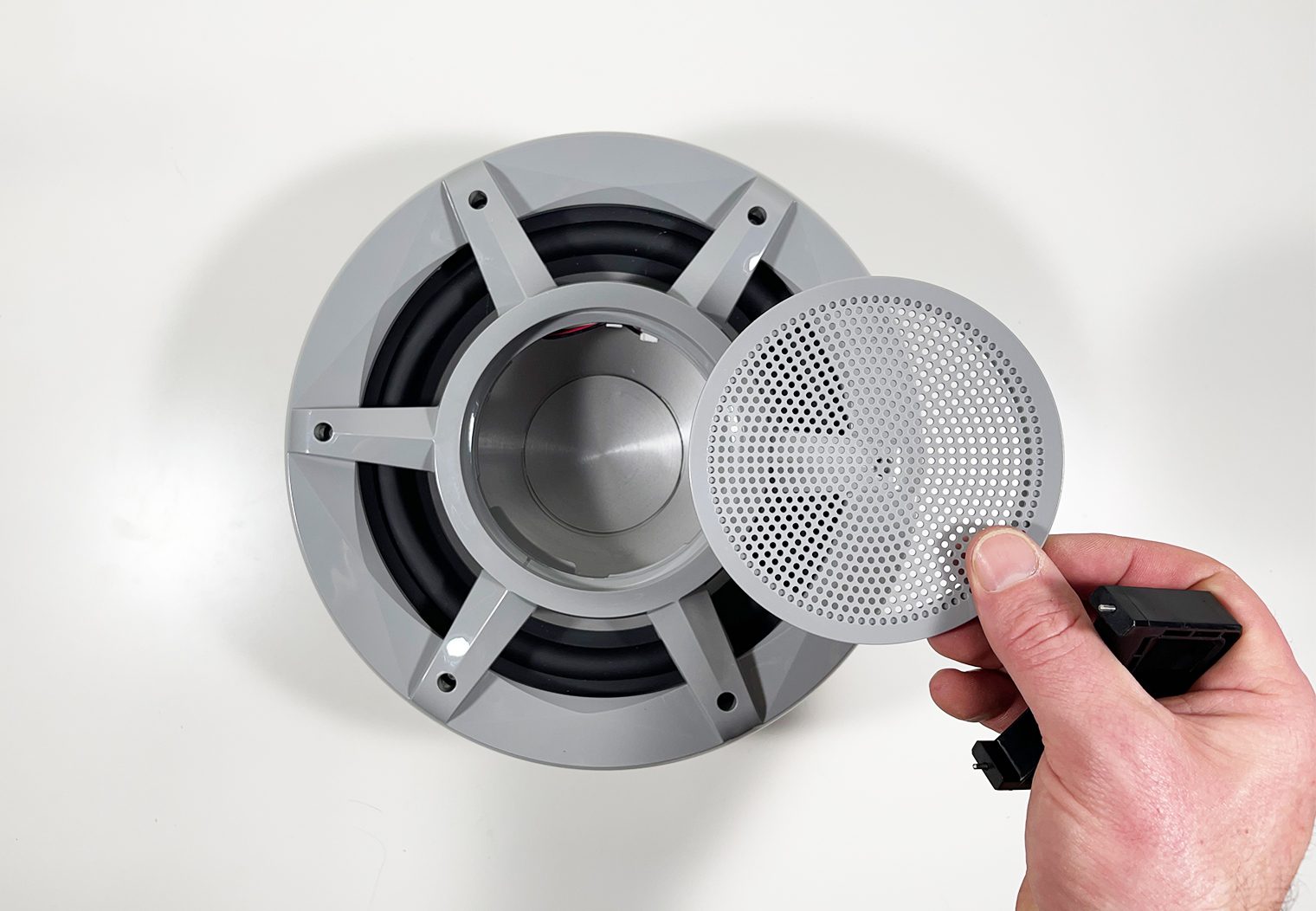
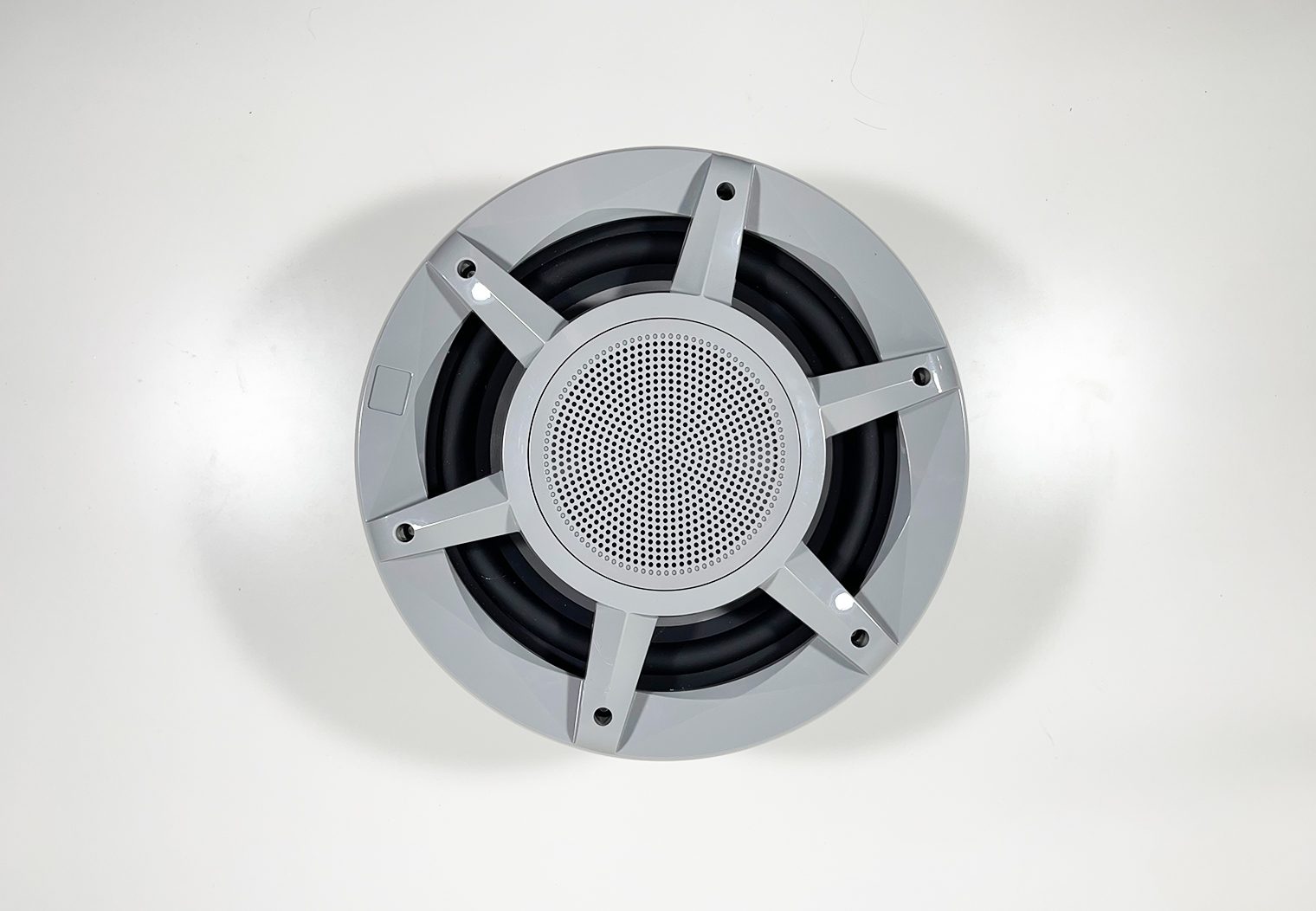
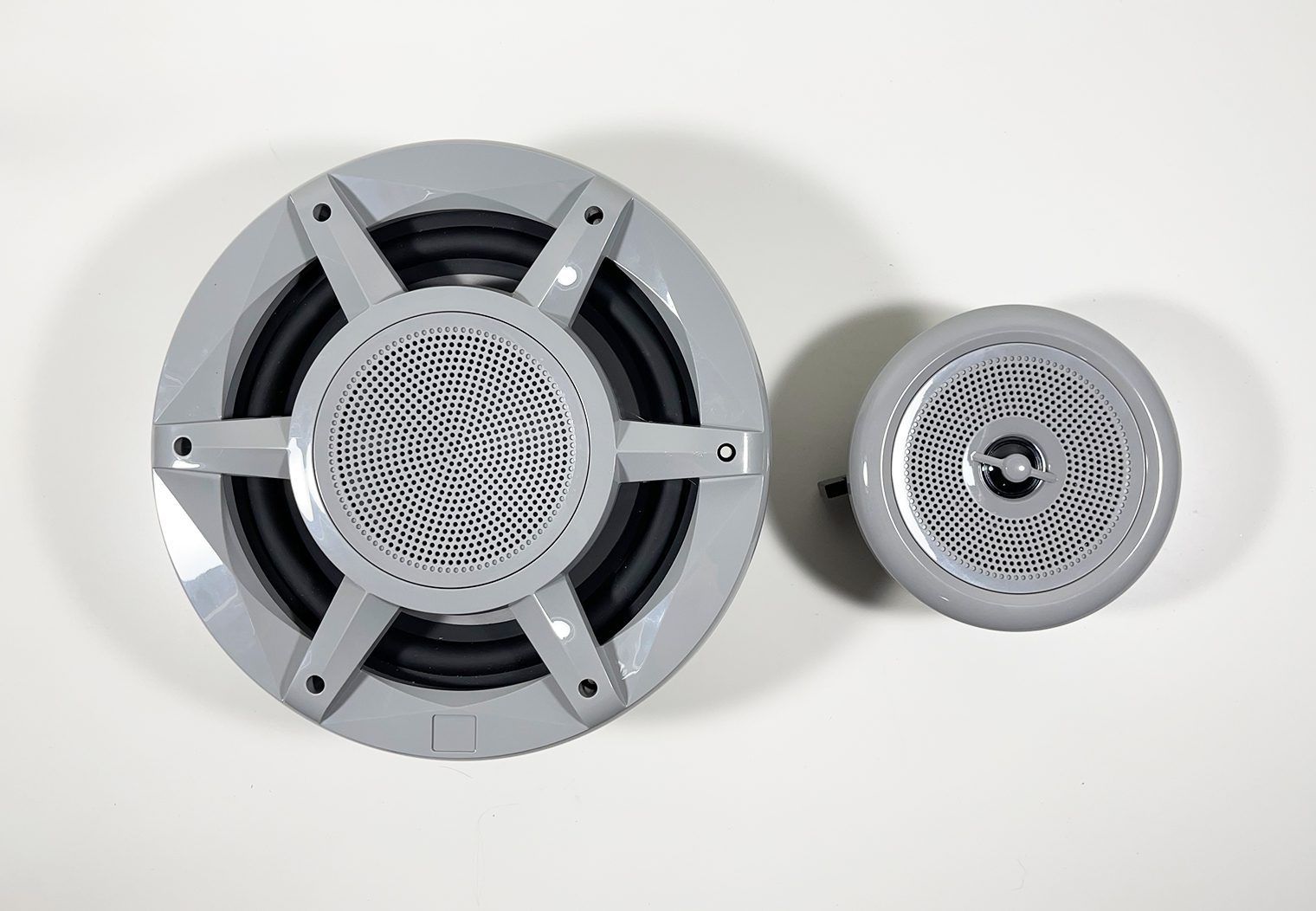
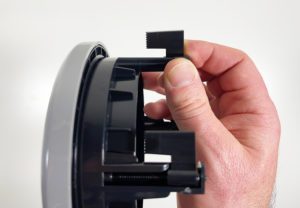
You can see in the photos above that the 82M comes with a separate mounting mechanism that will allow you to mount the midrange onto a variety of surfaces. It's designed to be universal, and if you look at the back of the mount you'll see why.
JBL's design uses four of what look like flaps to pull the mount to the surface from behind. You simply remove the gray cover from the mount, and then tighten the four mounting screws. As you tighten the screws, it will automatically flip these four ‘flaps' outwards and pull them in towards the surface. It reminds me of what they use for electrical boxes that are installed in drywall. Very effective design and super easy to use. The only drawback to this design is that you'll have to make sure that the surface you're mounting the midrange too is shallow enough for the flaps to grasp onto. By the looks of it, that's over an inch.
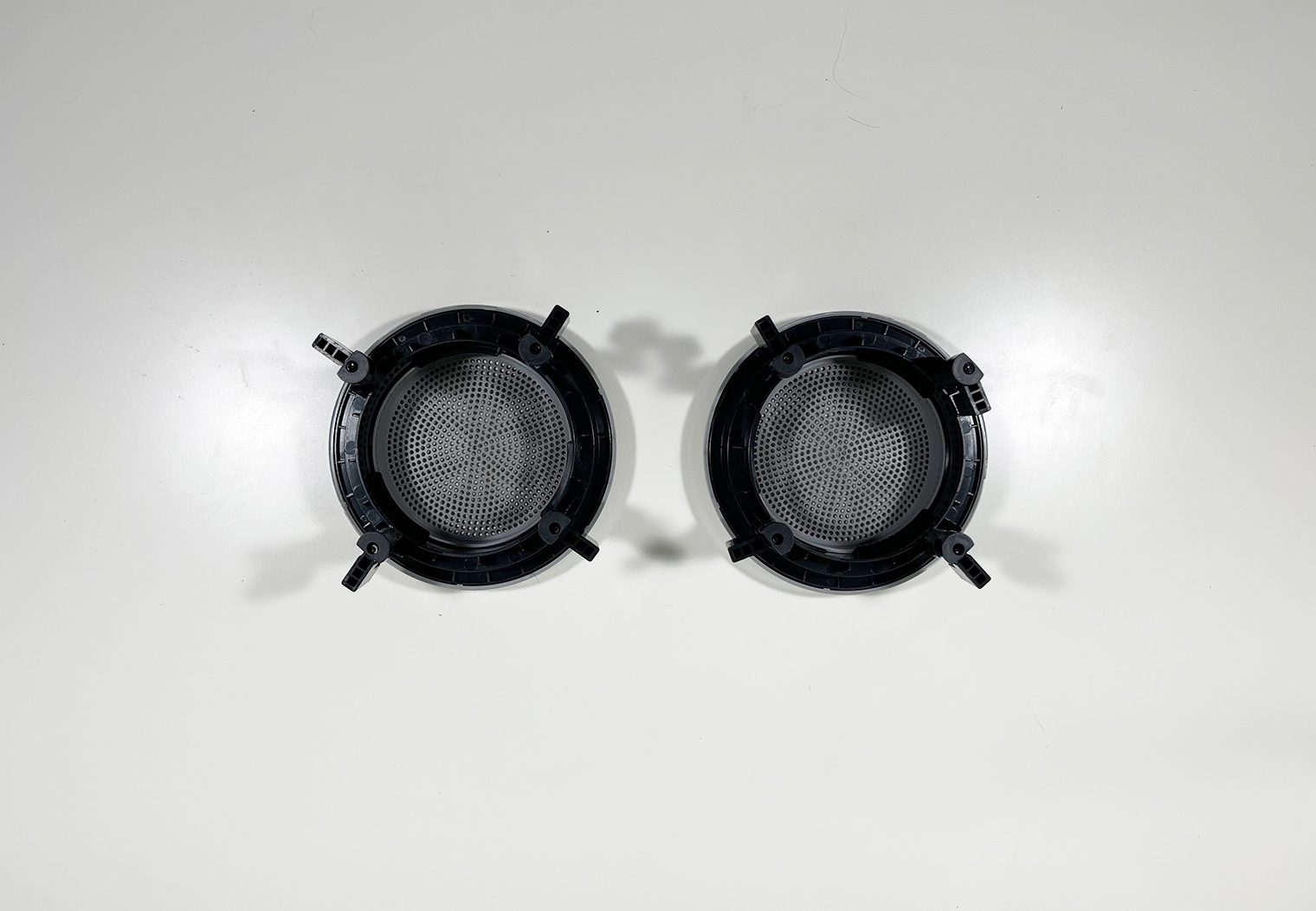
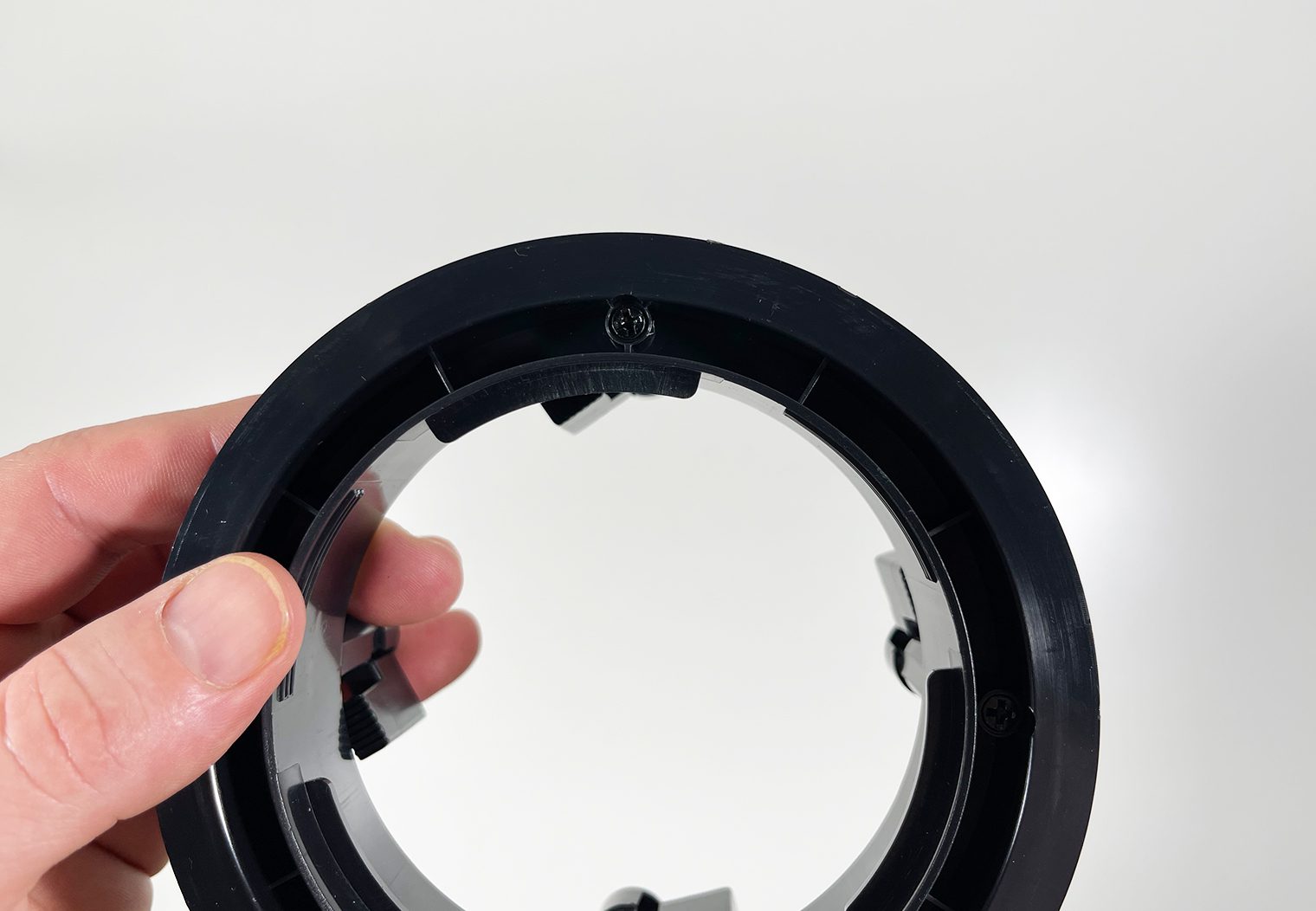
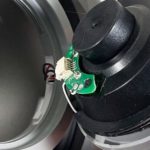
Overall, I really like the design and the idea. It’s a little tricky to swap the tweeter out and install it into the separate grille but with a little patience it's pretty straight forward. And one thing I’d like to see JBL improve on is the wiring and plug on the tweeter. It might be my OCD talking again but I wasn't a fan of the connectors. Over time, it might be another weak spot for corrosion if you’re in salt water. Nothing major.
LED Lighting
LED lighting is sort of becoming a standard for marine speakers, so it’s good to see these are up to par. I went ahead and hooked the 6 1/2″ set to power on my test bench and demoed the LED lighting to give you a better visual of what they'd look like installed on a surface in your boat. Here's my test bench:
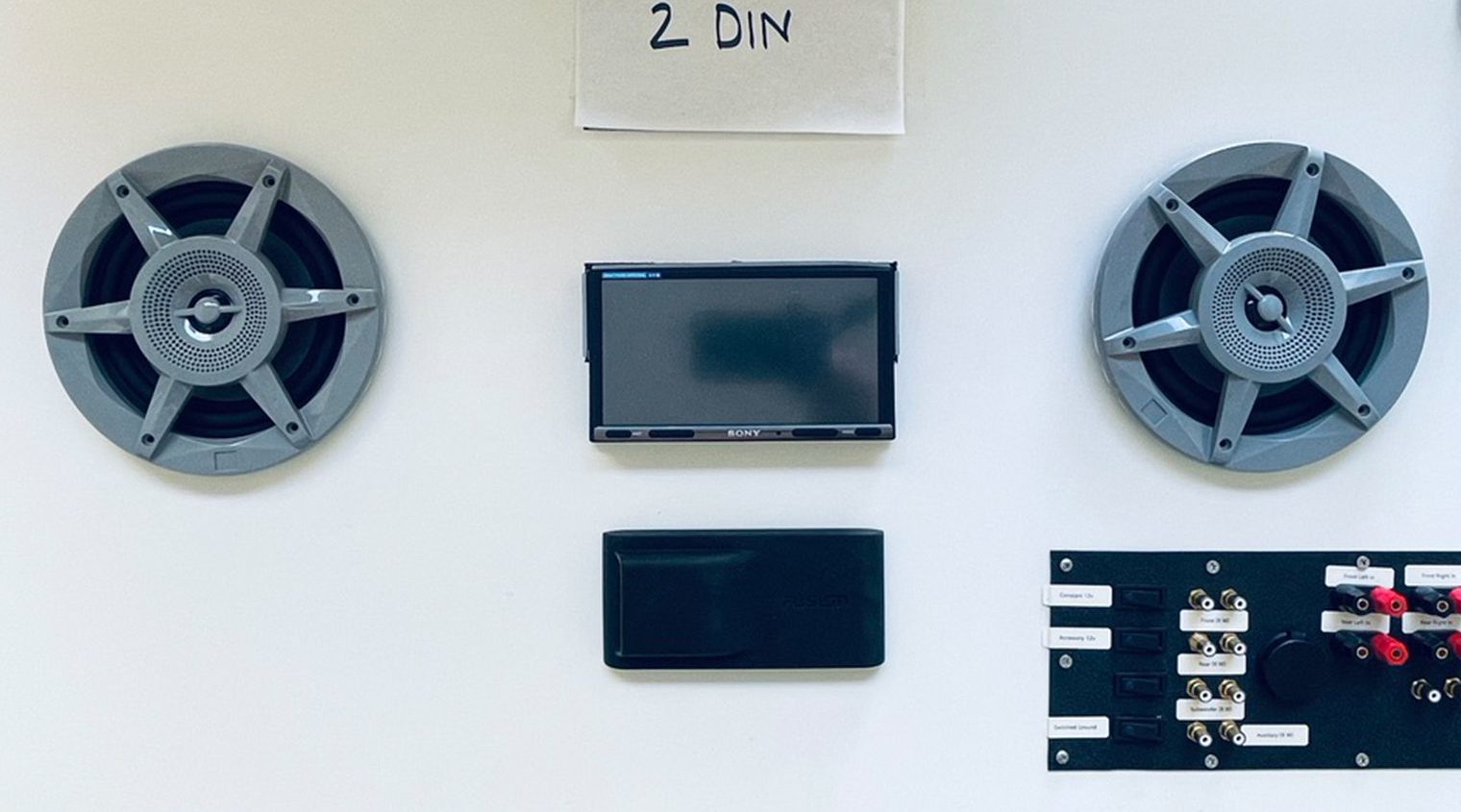
Even though I'm only demoing the 6 1/2″ size, all three models share the same LED technology so you can pretty much guarantee each will have a near identical look and feel. This is great because you can really create a mood in your boat just by installing a few speakers and subwoofer.
But what I found to be a little unique about these JBLs is that they have two LED lights – one on the outer ring and then also one on the underside of grille that fires down towards the cone. Most marine speakers that I’ve seen only have one or the other – on the outer rim of the speaker, or lighting up the cone. I haven’t seen both on a speaker so this is pretty cool and adds a unique flare.
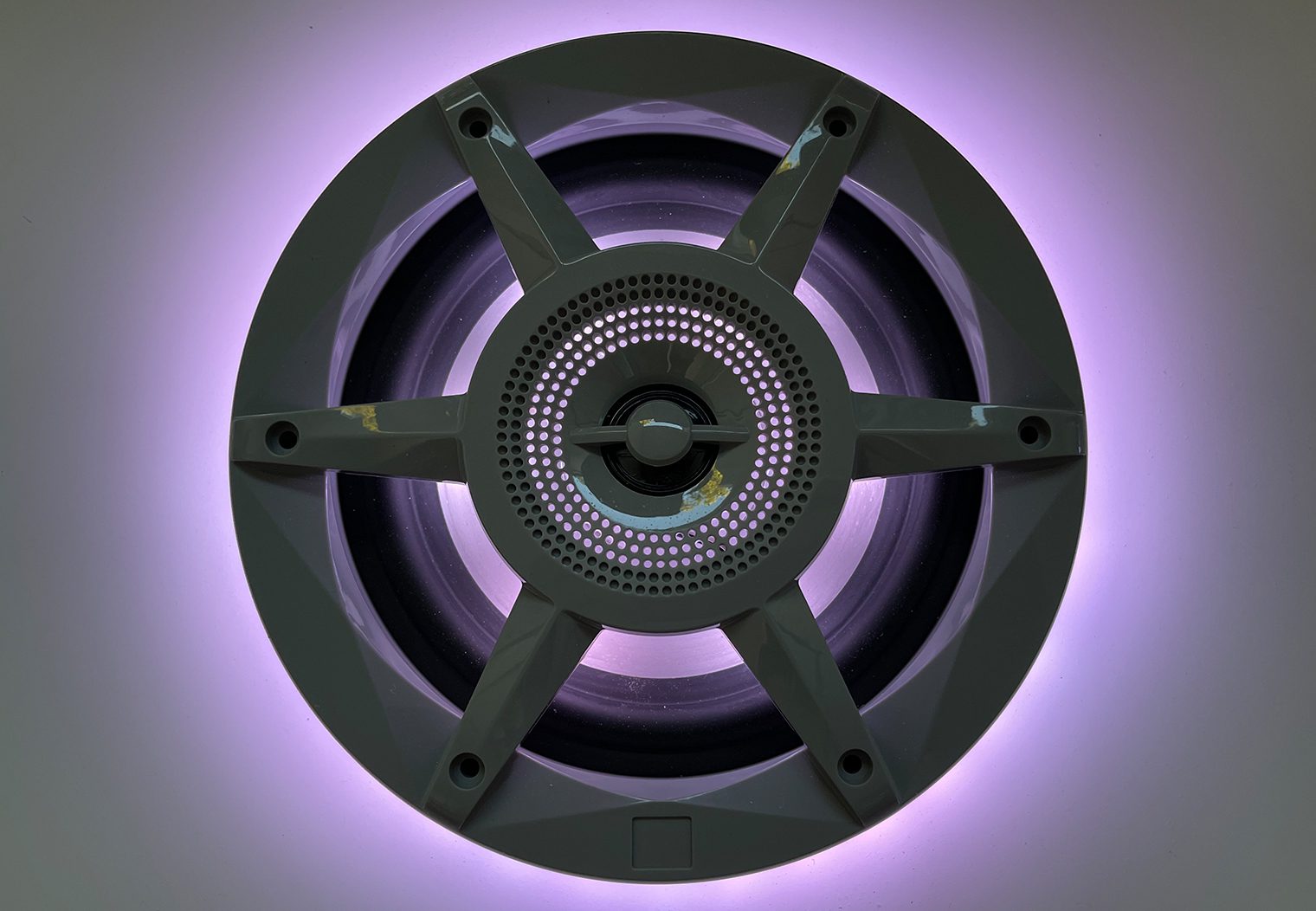
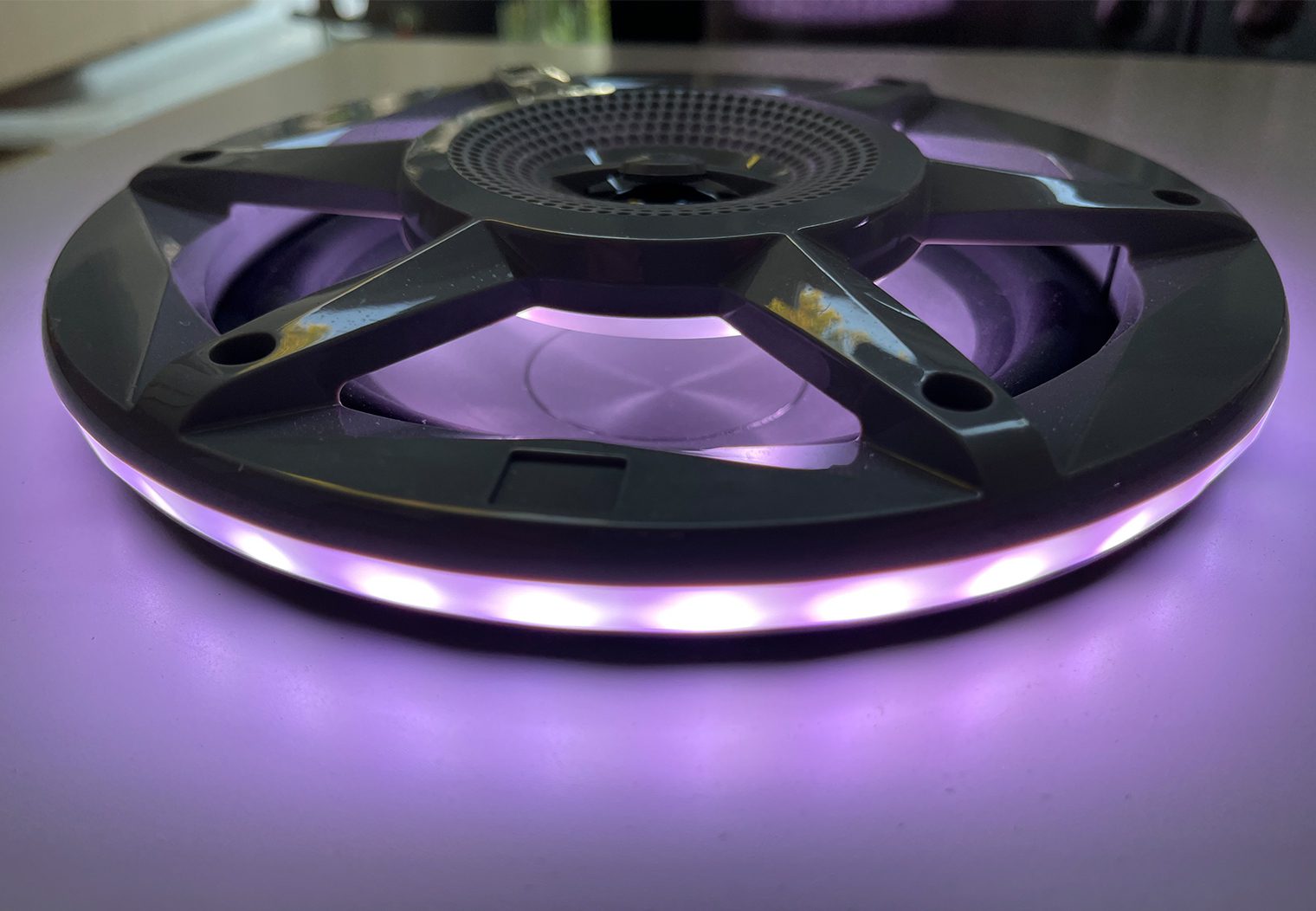
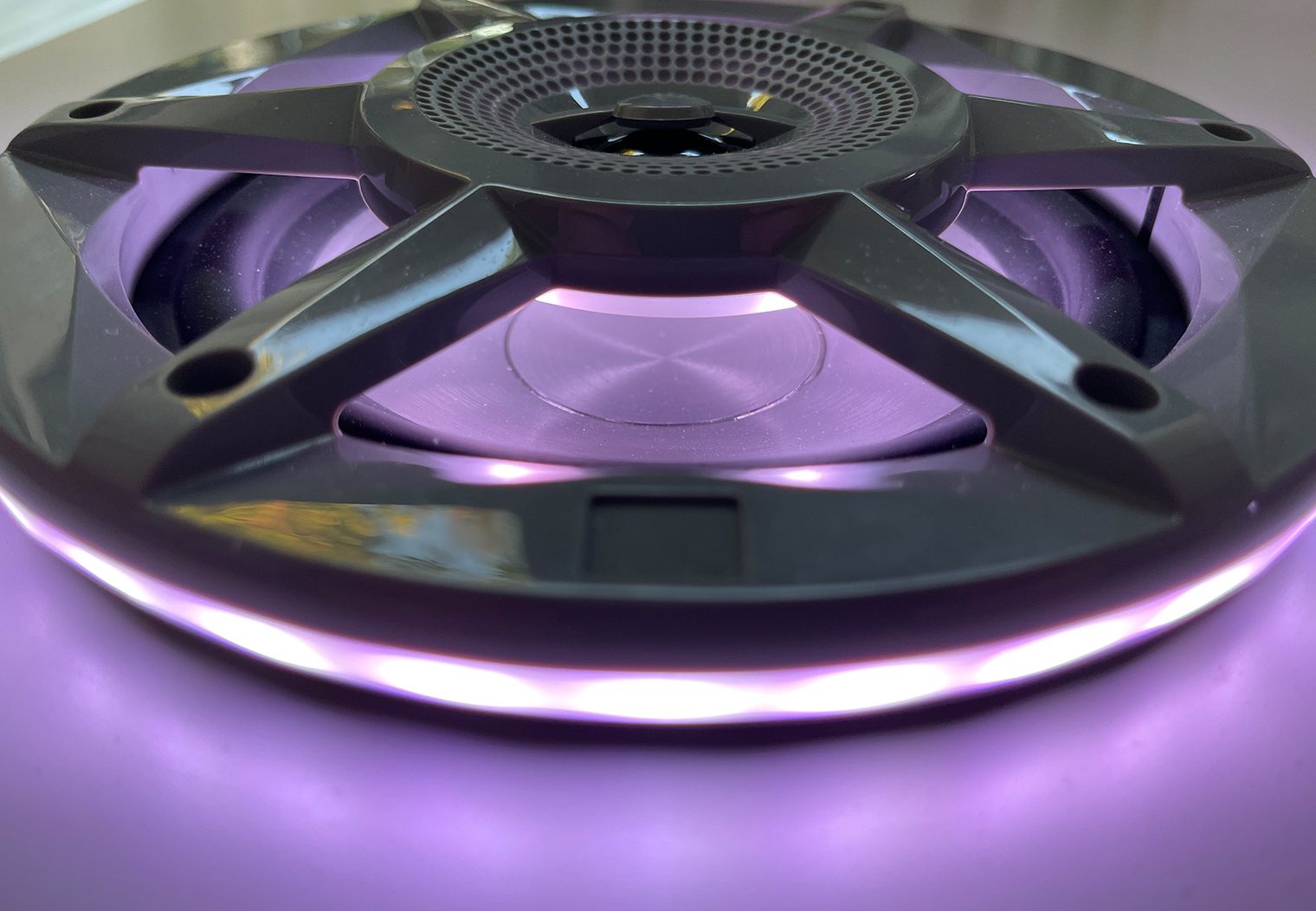
As for wiring the LEDs, they're pretty universal. I actually used a Clarion CMR-L1 LED controller for this test and it worked great. You can use almost any RGB LED controllers though. The Clarion just happened to be one of the more price-friendly ones at $40.
The Stadium Marine Series can emit 7 different colors when wired directly. If you use a universal RGB controller like I did, it will open up the colors to a much broader range and also allow you to control things like brightness and modes. So when I tested with the Clarion unit, there were more options but it will ultimately depend on which controller you use. Here's some photos of the various colors while testing.
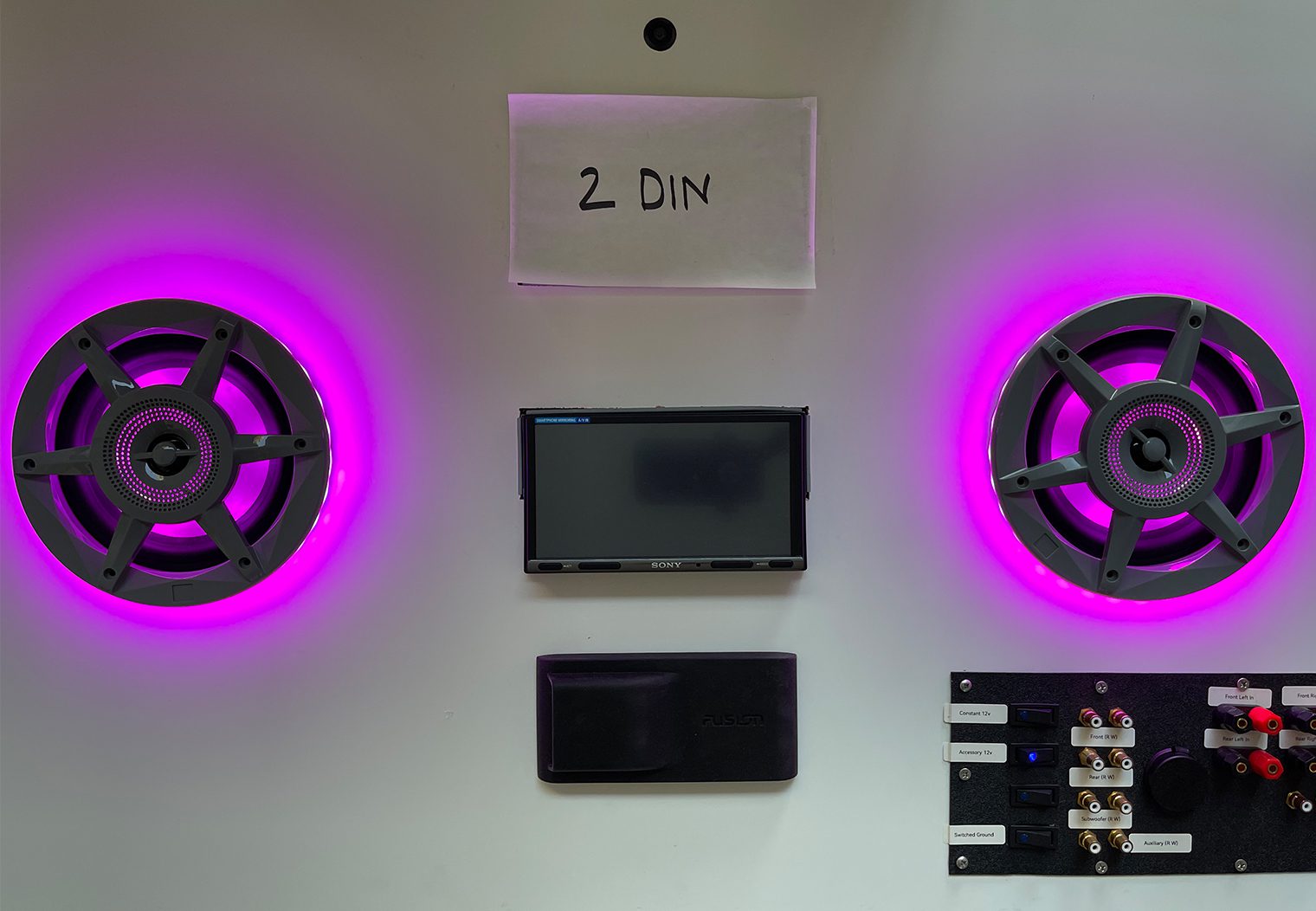
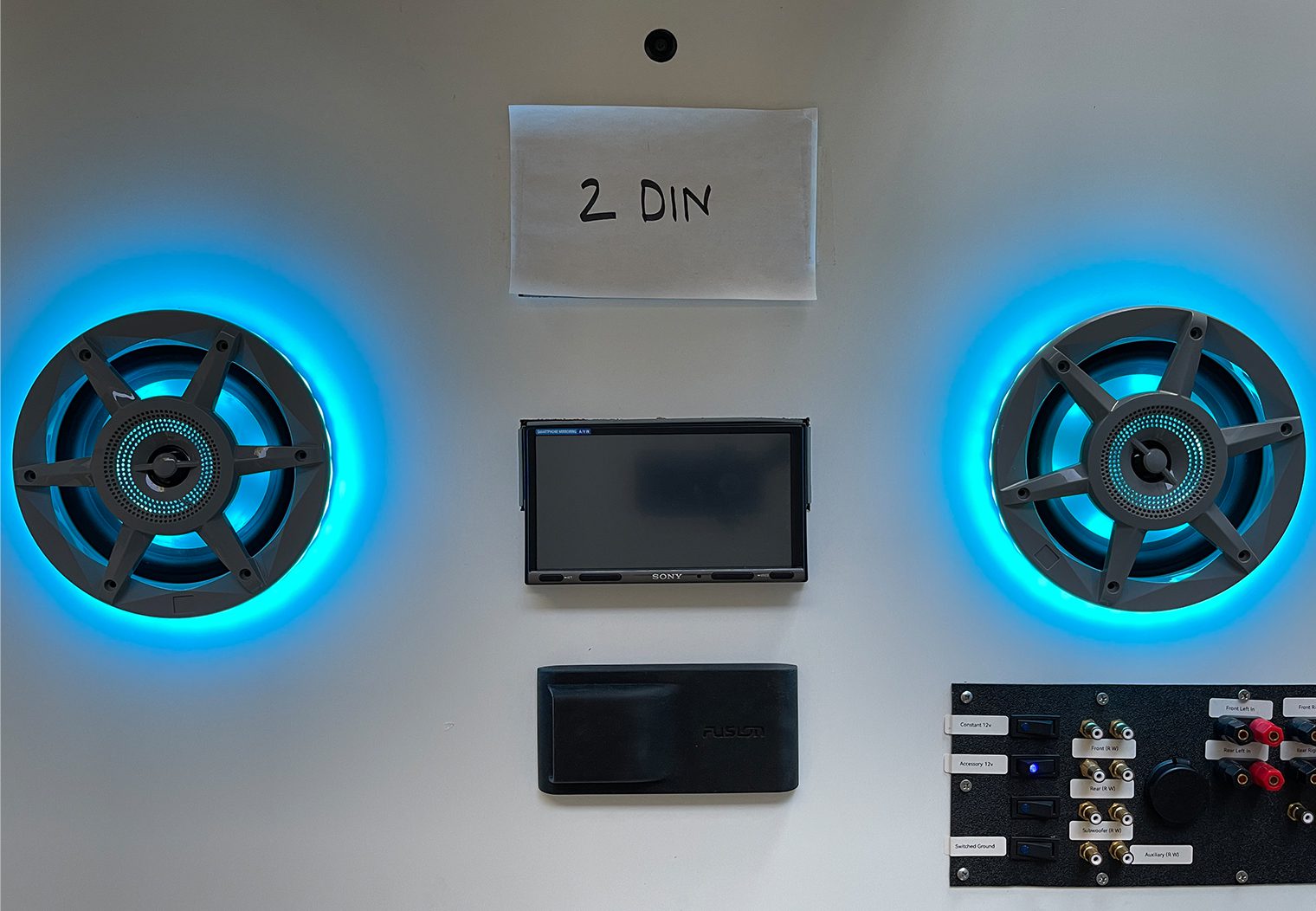
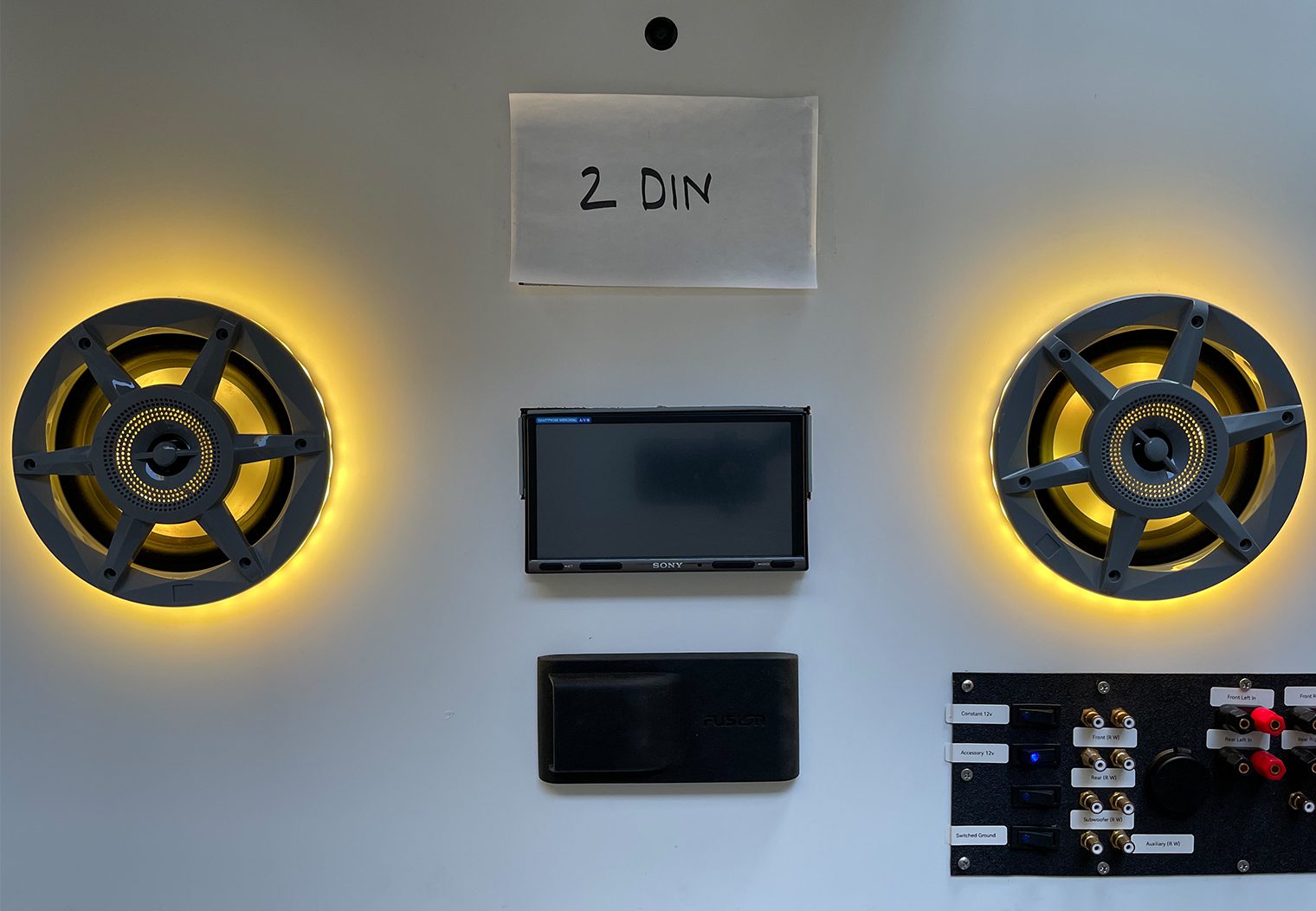
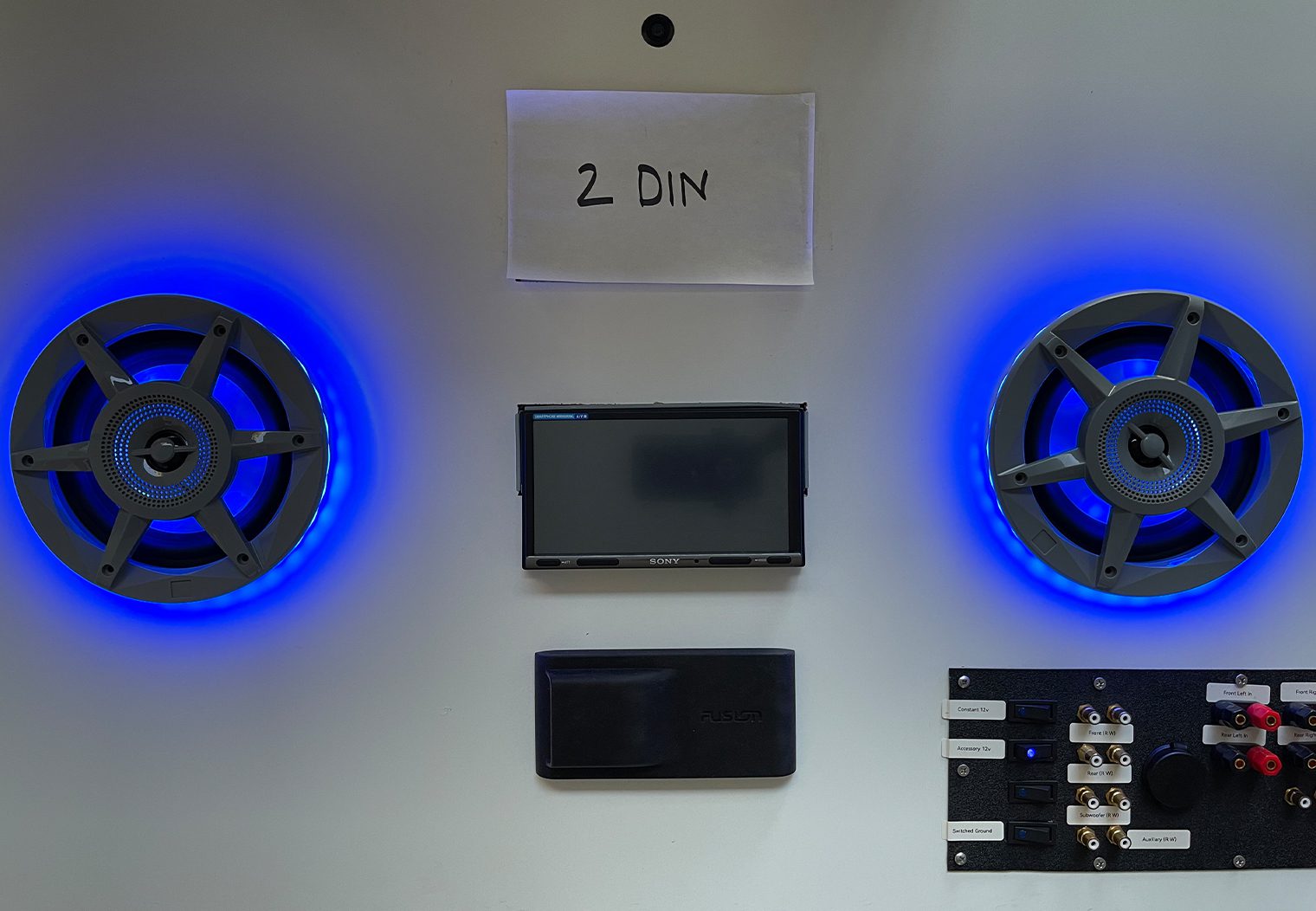
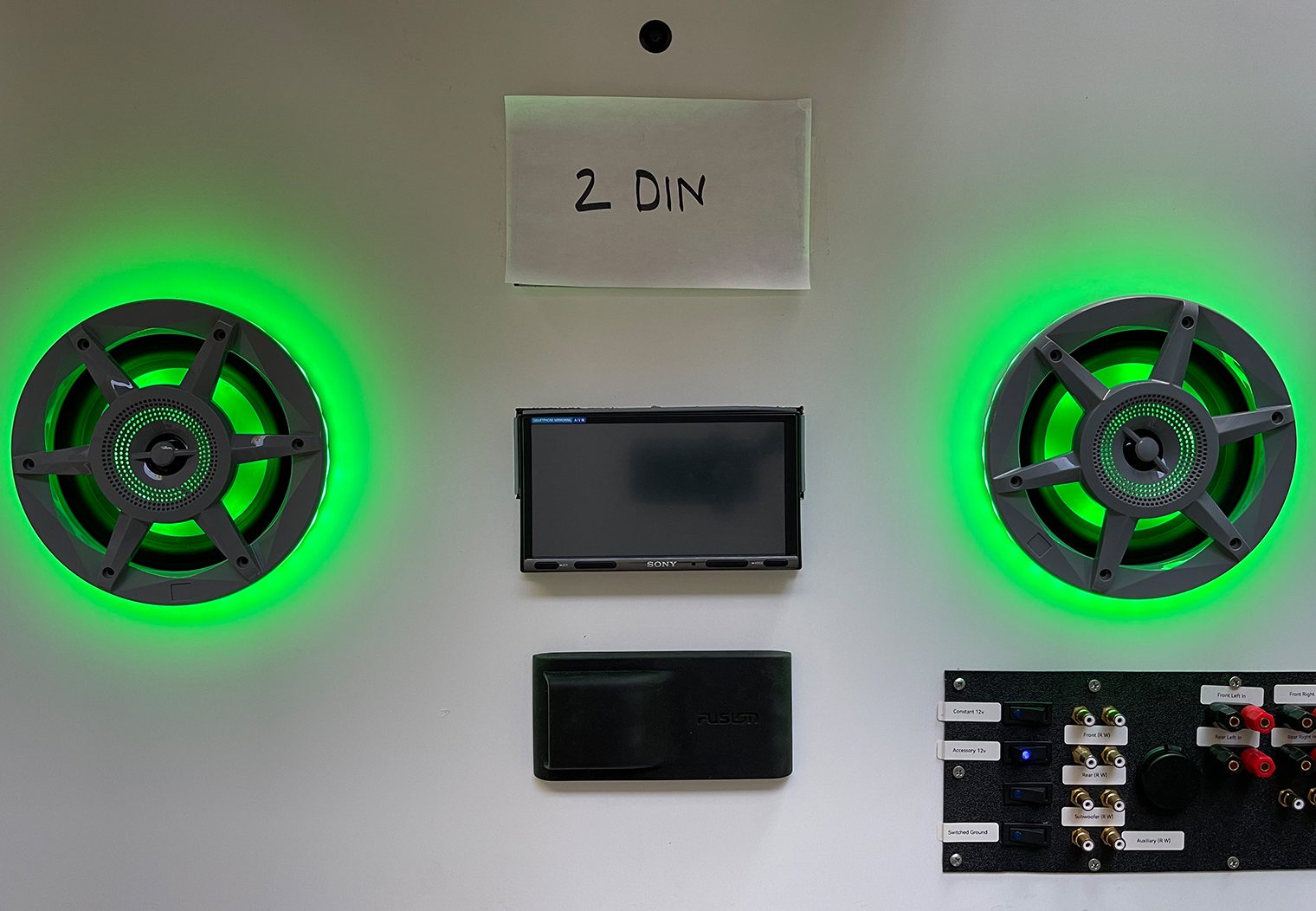
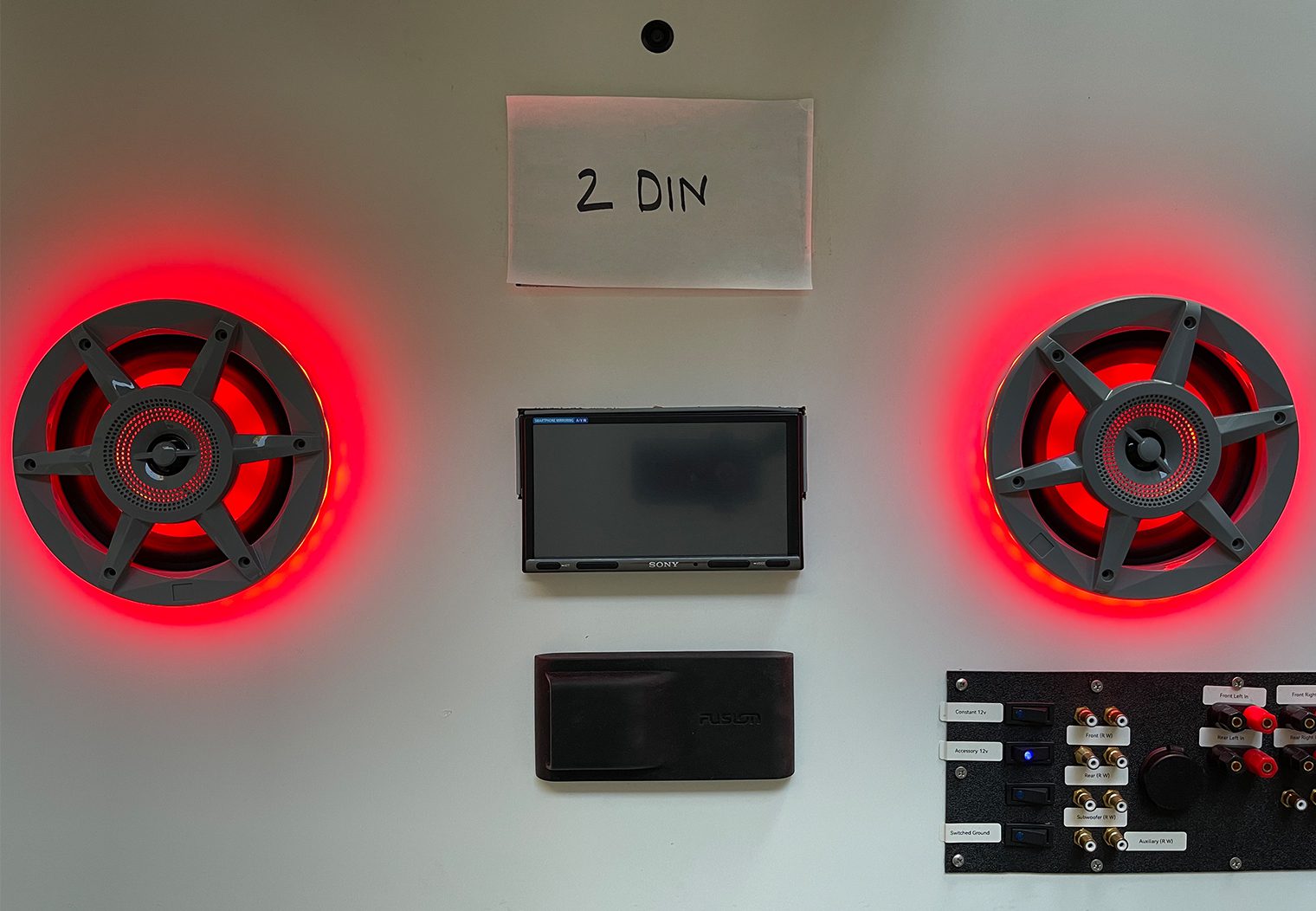
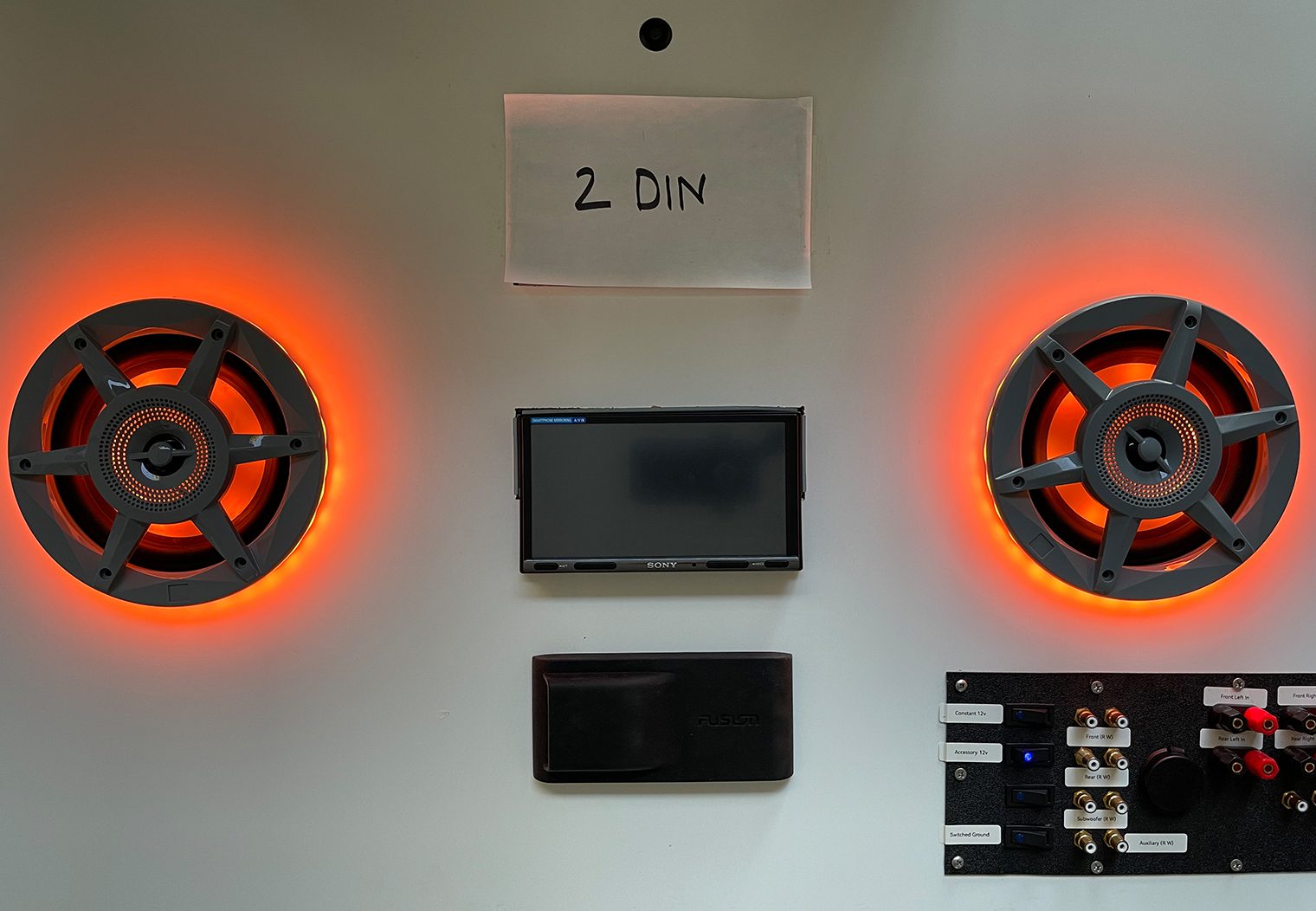
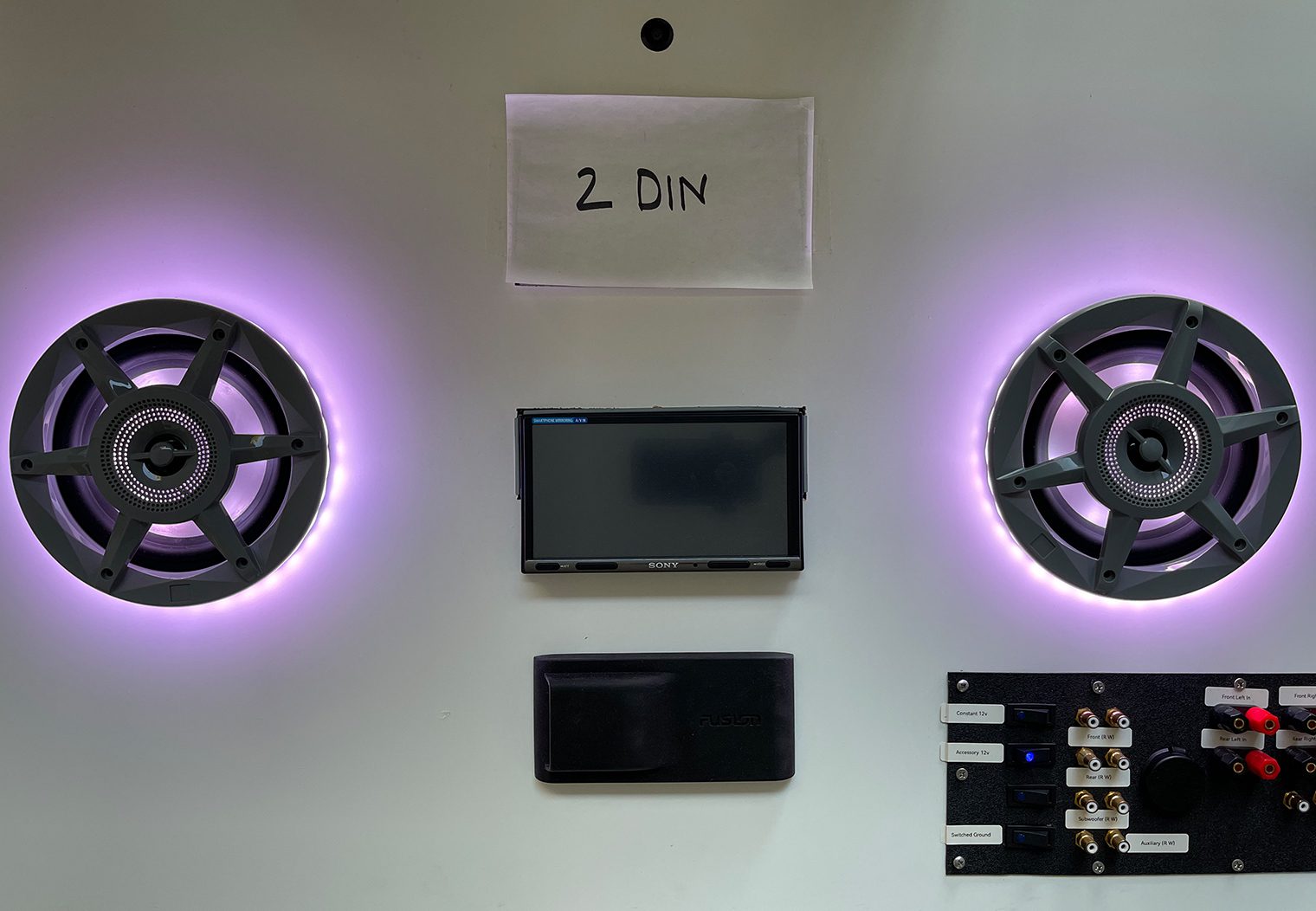
Straight forward, simple and looks great. No complaints here, I really like the look too, with both the outer ring LED that lights up the surface and the inner cone LED that lights the cone well.
Conclusion
I think these are a great option for marine grade speakers. Perfect option for a boat or even a UTV or general outdoor application since they're built to be weather-ready.
They’re priced pretty well – about $350 for the 6 ½, $450 for the 8” and about $400 for the 10” subwoofer. The 8″ and 6 1/2″ speakers are priced a little on the higher side from what I’ve seen, but I think it’s because they come with the unique build-in LED lighting, and the 8” comes with a few cool and innovative features that allow you to separate out the tweeter and flush mount it. So I would expect it to be a bit more pricy. The Plus One cone technology and suspended tweeters on the speakers are good features to have in the marine application too in order to help carry some more bass.
I really liked the LED design with the dual LED lights on the outer ring and underneath the grille. I thought it really brightened up the speakers, more than many of the alternatives on the market. And the outer LED design doesn't complicate the installation process which is great.
Although I didn't get to do all that much performance testing (I hooked them up to a standard head unit for a moment but didn't really test them), I think the Stadium Marine lineup is a great well-rounded set of speakers. All in all a great option and I’m excited to put these in a boat to see and hear them. Stay tuned for more about these speakers when we install them!
And if you have any questions about these speakers, drop us a comment below!

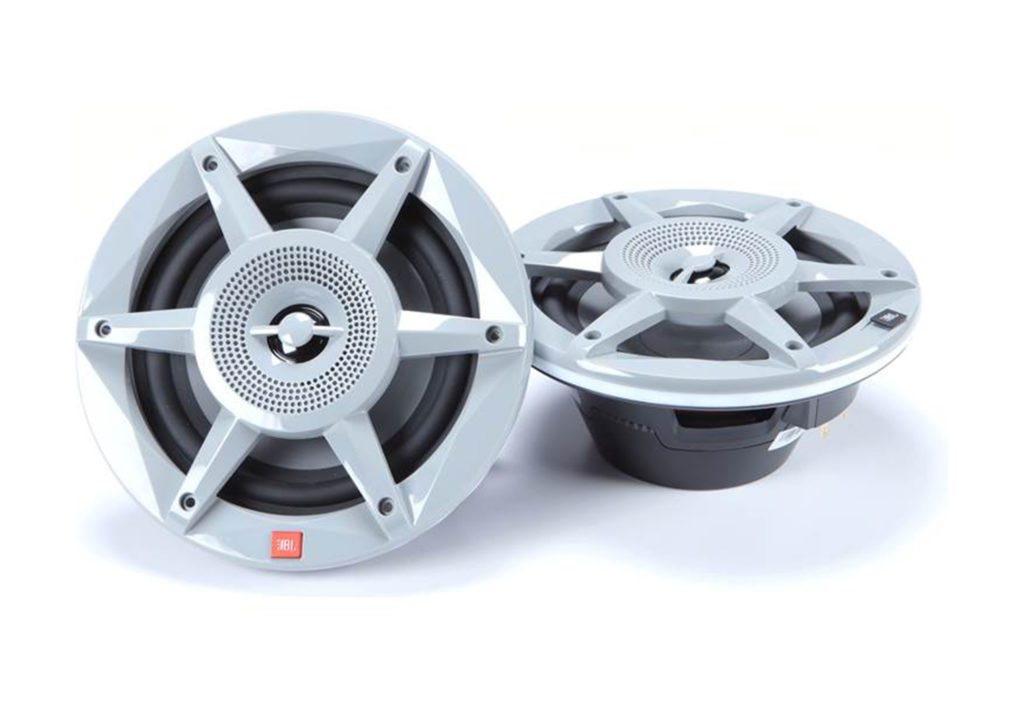
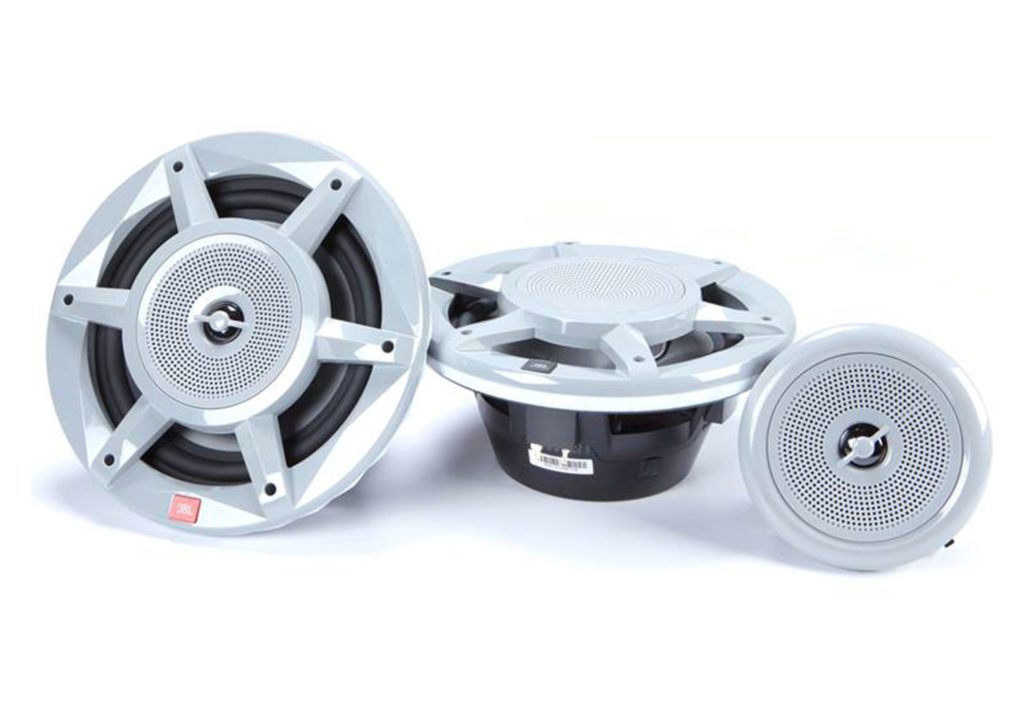
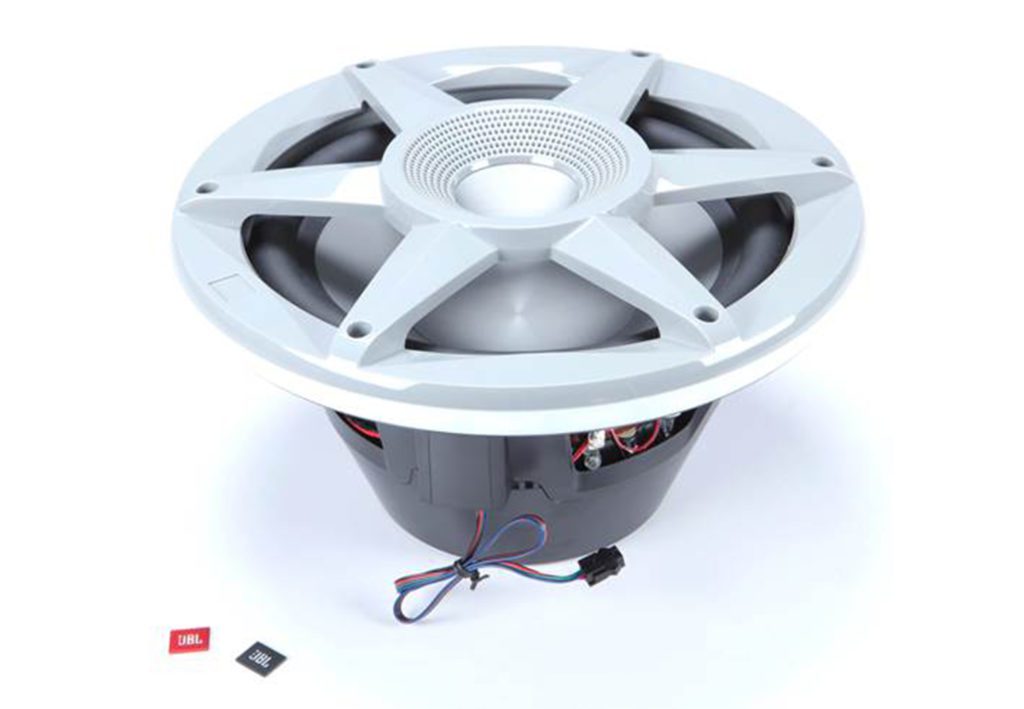

The review is very detailed, informative, and helpful. However, the actual sound quality is never part of the demonstration. How is a review completed for speakers with never actually showing music or sound?
Hi Heather,
Thanks so much for your feedback! The way a speaker or subwoofer ‘sounds’ is a very subjective topic that we try to stay away from. For one, sound on the same speaker can differ drastically based on things like: what you’re powering it with (are you using an aftermarket head unit with a lower 15w or 20w RMS output or a dedicated amplifier with an output that matches the specs of the speaker?), how your signal source is tuned (are you using a preset EQ, flat, have you set your crossovers or are you using a full range of frequencies), where the speaker is installed (is it in an enclosure? does that enclosure negatively impact the sound of the speaker?). The list goes on. There are a lot of reviewers that might focus on how a speaker ‘sounds’ but because it’s such a debated topic on how to actually measure how a speaker ‘sounds’ we try to stick to the facts.